87 min read • Automotive
GLOBAL ELECTRIC MOBILITY READINESS INDEX — GEMRIX 2023
Charting the progressive course of e-mobility across the world
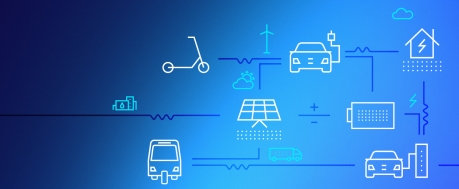

FOREWORD
Catastrophic climate change urges global shift toward electric vehicles — but the world needs to establish its readiness
The pressing issue of climate change, which world-renowned naturalist David Attenborough called “the biggest threat to security that modern humans have ever faced,” brought world leaders to a single stage culminating in the landmark Paris Agreement. This resulted in the requirement for countries to submit climate action plans known as Nationally Determined Contributions (NDCs), outlining their emissions-reduction targets and the measures they would undertake to achieve them.
Energy is at the heart of today’s climate challenge and key to the solution, with the inherent need to transition from fossil fuels to clean, sustainable energy. The transport sector, in particular, is responsible for approximately a quarter of greenhouse gas (GHG) emissions, with about 95% of the world’s transport energy coming from fossil fuels. Thus, the electrification of transportation offers a promising solution to climate change — but only if combined with a transition to electric energy generation from renewable resources. In any case, electric vehicles (EVs) beat alternative powertrain technologies with internal combustion engines (ICEs) in efficiency by a wide margin, disregarding the burning of fuel.
Of course, ending the age of the combustion engine is still a challenge for large parts of the planet. However, with 90% of the world GDP now covered with net-zero commitments and pressure on companies to counter climate change through new products, processes, and purpose, e-mobility topics have moved up the strategic agenda for automotive executives around the globe. To assist executives in organizations of all kinds around the world, Arthur D. Little (ADL) has set up a methodology to evaluate the “readiness” of markets for electric mobility and help formulate strategies based on the data. The standardized approach and detailed analysis of key market drivers for EVs enable a solid understanding of the current situation.
ADL’s current analysis covers 35 markets across all continents under varied situations regarding demographics, economics, motorization, energy generation, and so forth. In this Report, we provide an overview of the key results of the 2023 edition of the Global Electric Mobility Readiness Index (GEMRIX), which ADL first carried out in 2018 under the name, “BEV Readiness Study.”
Dr. Andreas Schlosser
Partner, Global Lead, Automotive
EXECUTIVE SUMMARY & KEY FINDINGS
GEMRIX 2023 is the third edition of the study and now includes 35 markets across all continents (see Figure 1). Already since the 2022 edition, there has been a massive jump in EV adoption worldwide. Norway has defended its position as the global leader of the EV readiness ranking, but a new challenger is getting closer, making huge steps: China.
The two markets are followed by three distinct groups of countries. All countries are moving to increase EV adoption, following similar patterns but with differences in time by a few years, as some started earlier than others. We discern differences between global markets primarily in specific legislation and, to a lesser extent, socioeconomic factors. In countries with higher income, for example, environment protection plays a crucial role, while in countries with lower average income, cost is the primary determining factor. The perspective to participate in a new, dynamically growing industry also sets incentives for vehicle electrification in many regions.
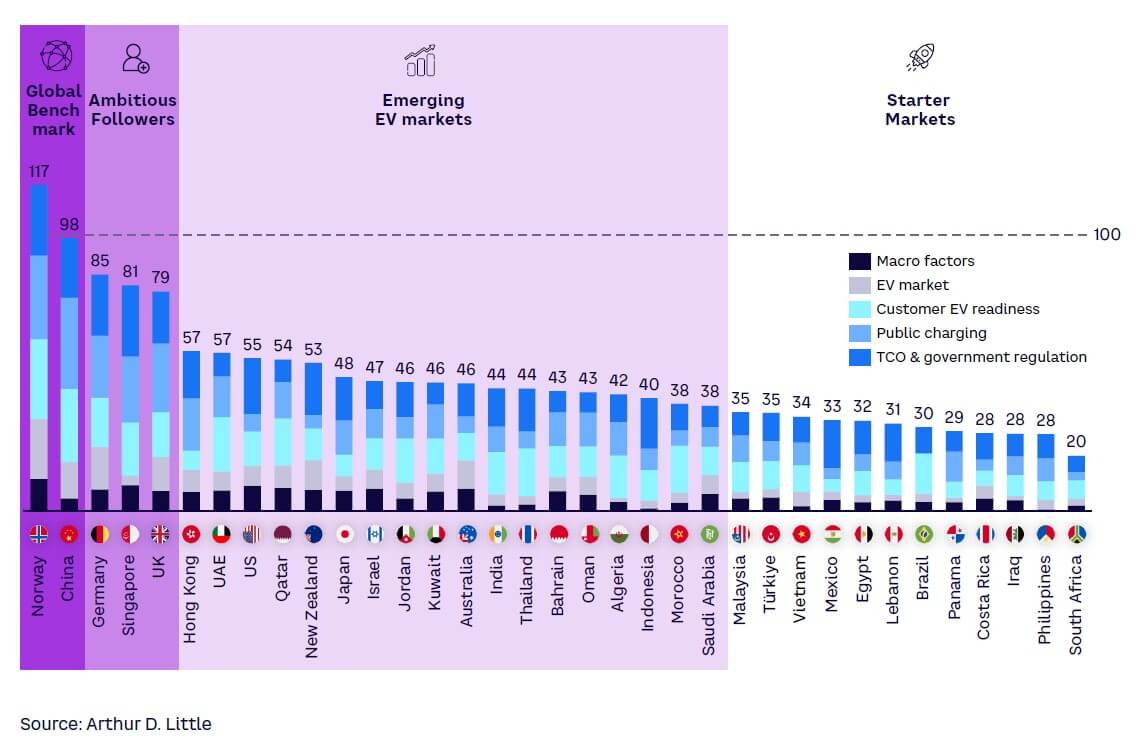
In the 2023 GEMRIX study, the markets are classified into four clusters:
-
Global Benchmark — markets with a GEMRIX score of 100 or above. In the 2022 edition, only Norway, a lead market for electric mobility, populated this category with more than 110 points. This year, for the first time, a second market has moved closer to the threshold: China scores 98 points. Among the 35 markets, Norway is still the only country with an EV sales share of more than 50%. A stunning 88% of all new cars sold in Norway in 2022 were either battery electric vehicles (BEVs) or plug-in hybrid electric vehicles (PHEVs).
-
Ambitious Followers — where all prerequisites for EV mobility are in place and EVs are on the verge of becoming mainstream. Example markets in this category are Germany, Singapore, and the UK. Among Ambitious Followers, EVs have increased their sales shares to more than 30%. In leading markets, a full range of EV models in different formats and price ranges is available, serving a broad spectrum of client needs. However, even in leading markets, OEMs are still under pressure to expand their EV offerings, especially to the entry market segment.
-
Emerging EV Markets — where conditions for EVs are still inferior to those for ICE vehicles, even though customers are becoming more comfortable with the idea of EVs as infrastructure is ramping up. Example markets are the US, Japan, the UAE, and India. Here, we see mainly scores between 40 and 60, with the UAE and Hong Kong emerging as the front-runners with a score of 57. In these markets, we still see a few operational and financial drawbacks. However, these countries have demonstrated a clear intention to make steady progress toward e-mobility. They are making significant investments to boost the landscape — and will likely catch up soon. For example, an entrepreneurial culture and a start-up ecosystem have played a pivotal role in driving EV innovations in the Americas, Southeast Asia (SEA), and the Middle East. Furthermore, the UAE has experienced an increase in EV charging infrastructure owing to government-led initiatives, a significant catalyst behind the increasing number of consumers willing to buy an EV as their next vehicle.
-
Starter Markets — where EVs have just entered the game and still face major challenges in terms of costs and infrastructure readiness. Example markets are South Africa, Malaysia, and Türkiye. In Starter Markets, electric mobility is just beginning to enter the conversation. Consumers are excited about embracing sustainable technologies, including EVs, as reflected in these countries scoring high in readiness. Given lower fuel costs in these regions, higher total cost of ownership (TCO) of an EV is a deterrent. The limited availability of EV options is yet another major issue. Additionally, given global awareness regarding climate change and a call for sustainability, these regions have ventured into electric mobility and announced initiatives, but execution and implementation at scale remain to be seen. Although the expansion of the EV charging infrastructure is still in its nascent stage, these countries are likely to ascend in the rankings as concerns surrounding charging accessibility are alleviated. Moreover, governments exhibit a strong inclination toward promoting e-mobility in public transportation.
Regarding Customer Readiness, cost is one of the most, if not the most, important drivers of EV adoption. This poses a challenge in developing countries as EV prices are still high and income is comparatively low. Thus, OEMs need to decrease costs, while governments need to create incentives to pave the road to success and allow customers to enjoy electric mobility. Especially in markets with low costs for fossil fuels, there needs to be improvement with TCO for EVs to enable a breakthrough.
In terms of Infrastructure Readiness, battling range anxiety — the fear that a vehicle’s battery will not have sufficient charge to reach the destination — is a key issue. DC chargers are becoming more popular, as they lower charge time, are perfectly suited to highways, and decrease range anxiety. Charging industry players should focus on the Emerging EV Markets — as these countries are about to solve the chicken-and-egg problem (i.e., determining which must be in place first, infrastructure or EVs), if they haven’t already done so, and governments are pushing infrastructure buildup, enabling players to win large-scale contracts. In markets with a quickly rising EV population, the challenge is to keep up with infrastructure installations to avoid creating barriers to adoption.
Government Readiness hinges on government’s willingness to take the first step by introducing wide incentives for purchasing vehicles. Customers should not pay a premium for EVs. Moreover, governments need to reduce TCO by introducing incentives for vehicle usage. Promoting EV adoption in Emerging EV Markets and Starter Markets will give charging infrastructure players the incentive to enter a country, creating a reinforcing spiral of EV adoption.
Betting on EVs is no longer a risky gamble, and the predictability of the EV market is continuing to grow. The only major driver that cannot be predicted fully is government policy. However, making reasonable assumptions about this will give the industry in all countries firm ground on which to base their planning.
1
GEMRIX 2023 METHODOLOGY
GEMRIX evaluates countries’ progress toward e-mobility, providing a comprehensive assessment of their suitability for EV adoption
Index methodology & approach
ADL’s 2023 GEMRIX has been calculated for 35 countries. The index provides a platform to compare countries’ preparedness and progress toward e-mobility. GEMRIX is calibrated between notional scores of 0 and 100. A score of 100 implies that ICE vehicles and EVs are at the same level in terms of acceptability, affordability, and availability. The higher the score, the higher the favorable transition to EVs in the country. Thus, a score beyond 100 shows that EVs are even more beneficial than ICEs.
GEMRIX comprises five major categories reflecting EV adoption: (1) macro factors, (2) EV market and competitive landscape, (3) customer EV readiness, (4) public charging infrastructure, and (5) TCO and government regulation (see Figure 2). Each category is further broken down into six to 16 specific data metrics, analyzed with a standardized metric for each country, rendering 47 variables per country.
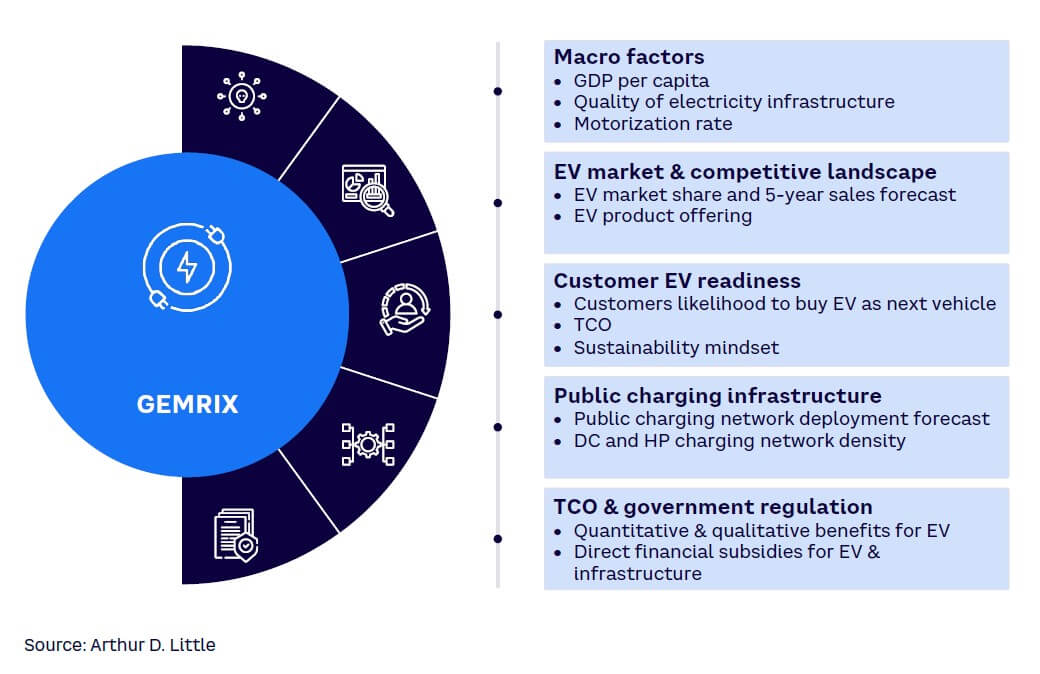
The five categories are assigned weights according to their relevance for EV adoption. The countries can score different points in each category, with each metric within the categories varying by weight and market data. The individual point score is calculated from analytics that consider relative and absolute performance measures. The final GEMRIX score is the aggregate of performance indicators from the five subcategories, providing a thorough assessment of a country’s suitability for e-mobility.
Macro factors
A country’s macroeconomic conditions can substantially impact its readiness for e-mobility solutions. GDP per capita, net income, and growth rate are among key macroeconomic statistics. Higher GDP per capita means more disposable income for emerging technology like EVs; the share of the urban population also paves the way for EV adoption (see Figure 3). As cities typically have higher pollution and congestion levels, EVs are appealing to mitigate these risks in urban cities.
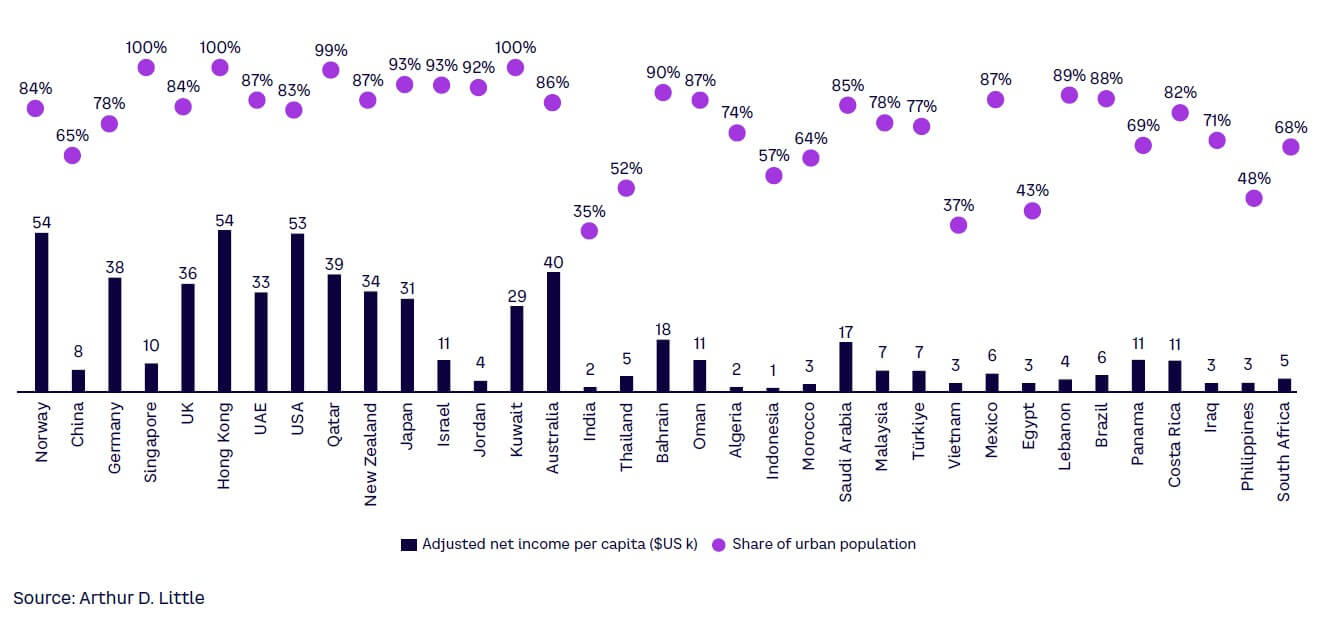
Furthermore, renewable energy production can boost e-mobility preparedness by powering EVs with cleaner, more sustainable energy. Renewable energy production is crucial for EVs to be a truly sustainable alternative to ICE vehicles. Smart grids are also vital as governments pursue ambitious plans to boost their electricity supply and integrate renewable energy into their generation portfolios. Importantly, resilient electrical grid infrastructure can accommodate the growing demand for charging EVs. The availability of a secure and steady electrical supply guarantees EV owners a seamless charging experience, thus easing the transition to electric mobility.
EV market & competitive landscape
The level of competition among OEMs impacts a country’s EV adoption — higher competition results in more innovation, lower prices, and better consumer services (see Figure 4). The number of BEV or PHEV models offered in the market by OEMs also indicates the availability of consumer choices, which drives competition and innovation. This, in turn, can make EVs more accessible and affordable to a broader range of people.
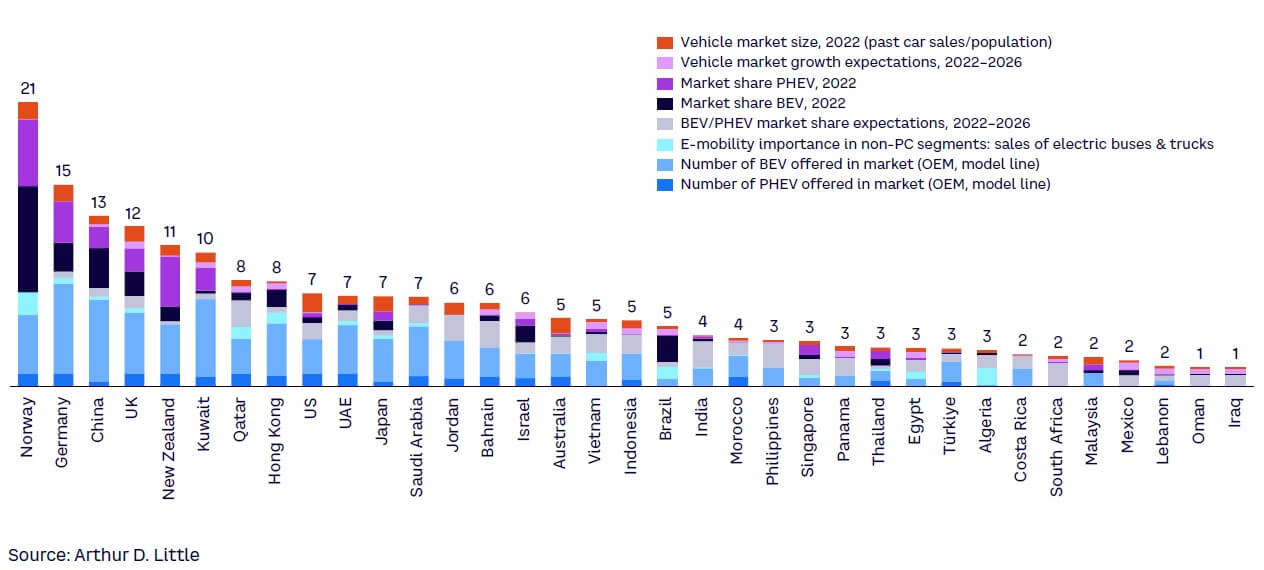
Recently, EV markets globally have proved to be very dynamic (see Figure 5). While it was only two years ago in which the EV market outside China was dominated by emerging players (with Tesla leading the way), many incumbent OEMs have since raced to overtake them. German and US OEMs are a good example of this volatility. Up to 2019, they only reluctantly introduced EVs. Customers interested in electric cars of a new kind largely had to turn to Tesla. Starting in 2020, however, pushed by government initiatives and the pressure of coming late to this important future market, German OEMs rapidly introduced new all-electric lines and models. The US saw a very similar uptake, as major US OEMs — including Ford and GM — also electrified their mainstream model lines.
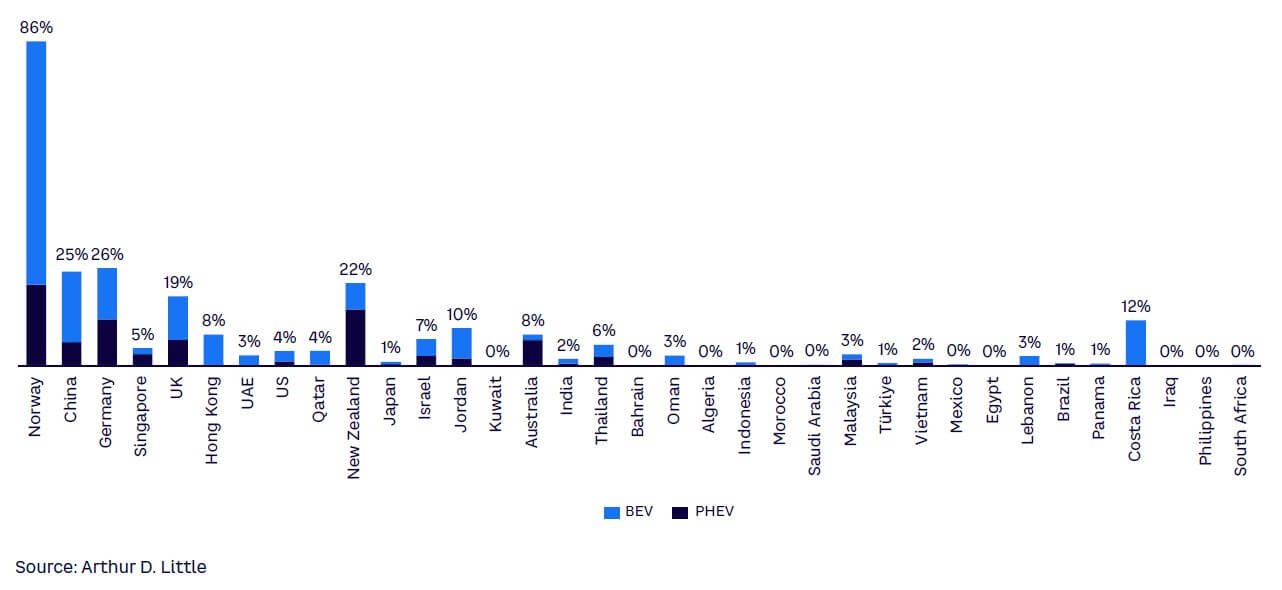
At the same time, Chinese EV manufacturers are now ready to export their EVs all over the world. Moreover, in many countries, new dedicated EV brands and manufacturers have been installed and are about to start operation, for example, in Vietnam, Türkiye, and Saudi Arabia, among others.
Customer EV readiness
Customer preparedness allows for the acceleration of EV adoption and promotion. This is influenced by such factors as the chance of acquiring an EV, Internet penetration, and EV pricing versus ICE automobiles. A higher incidence of homeownership can create a wider pool of potential EV owners who can readily access and install home-charging infrastructure.
Figure 6 summarizes the factors influencing customer readiness, while Figure 7 zones in on customers likely to buy a PHEV/BEV as their next vehicle.
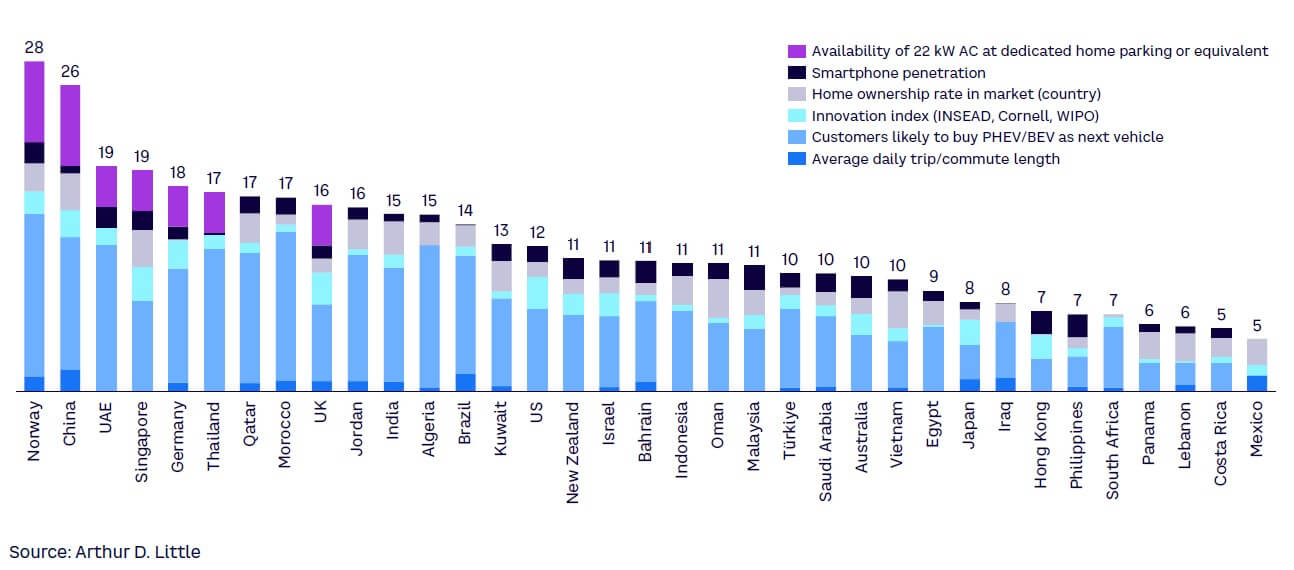
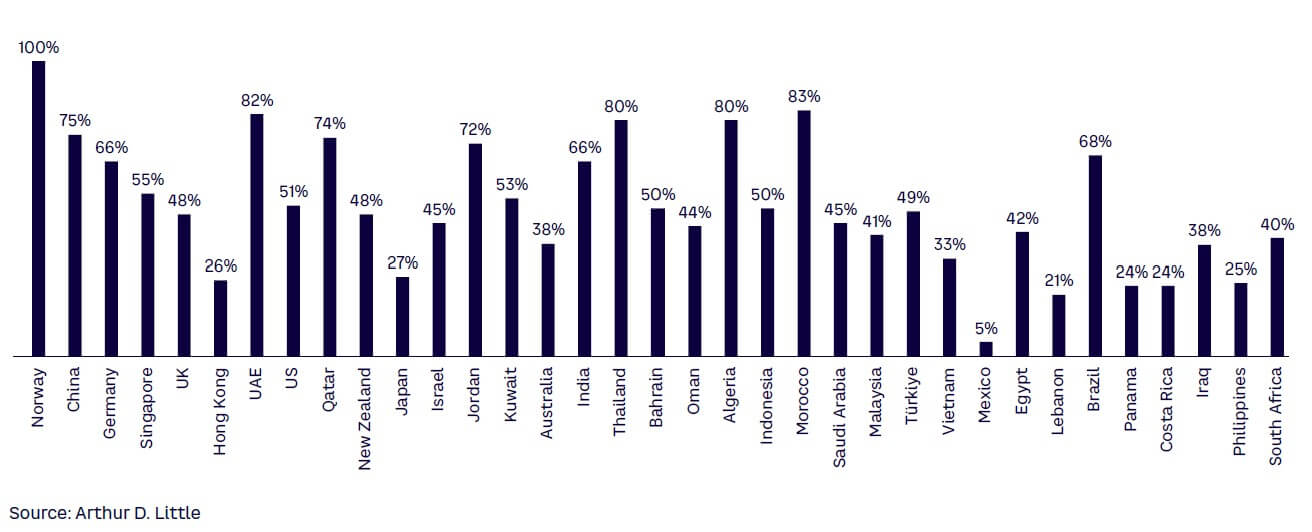
The topic of charging naturally leads to accessibility. We see a correlation between the share of a population living in urban areas and EV readiness. Lack of access to public charging infrastructure is a massive hurdle to the adoption of EVs. Globally, the density of public charging points in rural areas is nowhere near the density of petroleum stations. With most EVs are still of lower range compared to their ICE counterparts, countries with a large rural population have a significant challenge to solve, as is very visible in India and Vietnam. Again, this hurdle is much less pronounced for two-wheelers (2Ws), which can be charged effectively using standard household power lines.
Factors like knowledge and automobile preferences also determine customer readiness. A favorable inclination toward EVs enables greater adoption, as the lucrative demand side will push the supply side, namely, government and OEMs, to enter the EV market. One factor signaling customer preference for EVs is the homeownership rate. Homeowners have the flexibility of charging installation, thereby making e-commutes more feasible. Some countries, such as Oman and Qatar, have fared well in GEMRIX due to upbeat customer readiness, primarily driven by homeownership rates. Range anxiety is another factor that concerns consumers. Thus, a shorter average length of commute bolsters the use of EVs.
Concerns about environmental protection play the second most important role in readiness to buy an EV. We see a clear correlation between EV readiness and environmental awareness, as measured primarily by the number of governmental activities and years since those activities were introduced. While this aspect is very important in Norway and Germany, in a country such as India, it only reaches a very small group of customers. Furthermore, the “coolness” of driving an electric car is a determining factor — again, primarily in Europe and North America.
Additionally, a higher score in the Global Innovation Index (GII)[1] of a country can pave the way for technological advancements in EV technology, including improvements in battery efficiency, range, and charging infrastructure. Customers are more likely to be ready for EV adoption when they see continuous innovation and advancements in these areas.
Public charging infrastructure
The availability and quality of charging infrastructure are critical variables in a country’s EV industry’s growth and success. Before purchasing an EV, consumers must have faith in the availability and dependability of charging infrastructure. A comprehensive charging infrastructure network, including both AC and DC networks, can improve the convenience and appeal of owning an EV by increasing the number of opportunities for drivers to recharge their vehicles. Furthermore, developing a charging infrastructure network can boost customer trust and encourage EV adoption, increasing demand for EVs and moving the EV sector forward.
AC charging infrastructure, prevalent in homes, workplaces, and public parking lots, provides slower charging speeds but is appropriate for overnight or extended charging periods. It makes charging convenient and accessible for daily commuting and routine use. DC fast-charging infrastructure, on the other hand, provides considerably faster charging speeds, allowing EVs to recharge their batteries within 30 minutes or less. DC fast chargers are frequently installed along highways and main travel routes to facilitate long-distance travel and reduce charging time during trips. The presence of both AC and DC charging infrastructure demonstrates the EV sector’s comprehensive development (see Figure 8).
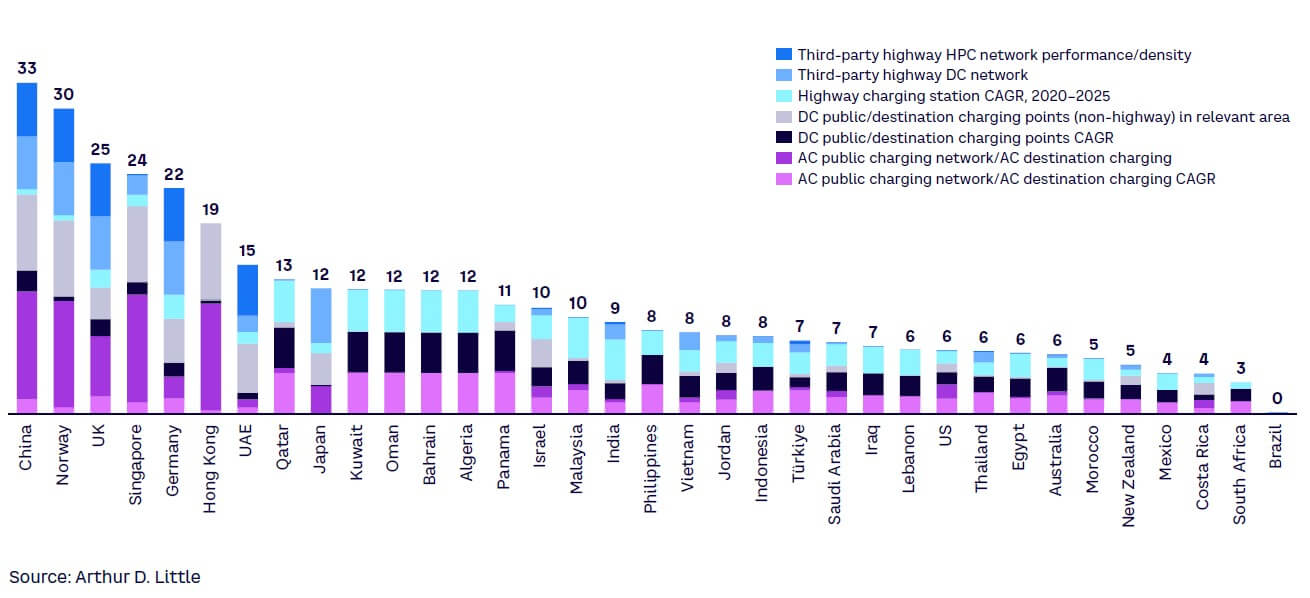
The importance of the charging infrastructure category in GEMRIX is established by allocating one of the highest weightages. Some smaller and densely populated countries score high in this category because of high EV charger density on highways, at destinations and in residential areas. EV charging infrastructure is also among the foundations for strengthening the UAE’s position in achieving the highest score in this category. For example, Dubai is investing in making the charging infrastructure robust through various initiatives aligning with its vision toward sustainability. It makes it a lucrative go-to-market for EV charging infrastructure vendors.
When starting EV markets, the availability of private charging at home or workplaces is the key enabler, but every significant step in a market’s EV adoption requires public charging infrastructure. Only dense-enough and easy-to-use public charging infrastructure enables long-distance travel by EV and opens the market to customers who do not have access to private overnight parking with electric power supply.
Because the lack of public charging is the greatest hurdle in starting EV markets, and the costs of infrastructure setup and charging play a major role, AC charging up to 22 kW was the first choice in early EV markets. While these charging speeds are sufficient for small battery packs and charging use cases that allow for several hours of charging, they fail in en route charging and locations with high and continuous charging demand.
We observed that DC charging becomes the preferred choice in a growing number of public charging use cases, including destination, curbside, and en route highway charging, where maximum outputs can reach up to 300 kW currently. Only DC charging powers of around 100 kW and above enable a quick refill for driving distances greater than 50 km in an hour or less.
Leading GEMRIX markets, such as Norway and Singapore, score high in GEMRIX for their public DC charging infrastructures, while the UK, Germany, and the group of Emerging EV Markets are still more AC-heavy beyond the main highway connections. Changing existing infrastructure to DC or creating a sufficient density of DC charge points will require significant investments in those markets in the coming years. Starter Markets preparing for the first wave of EVs can leapfrog to DC charging in public spaces.
TCO and government regulation
Vehicle price and running costs are the most important factors for customer decisions between ICEs and EVs. ICE vehicles have had a head start of more than a century in optimizing production at scale and building an ecosystem, which has allowed customers to buy and operate vehicles affordably and conveniently. Therefore, legislators have introduced various EV incentives to compensate for economic disadvantages, which are clustered into three broad categories:
-
Sales price — tax reduction or lump sum
-
Ownership — mostly reduction of motor vehicle tax
-
Operations — lower energy prices, reduced tolls, reduced parking prices/exclusive parking
Thus, government regulations can significantly impact the smooth transition to EVs (see Figure 9). Policies like subsidies, tax incentives for EV purchases, and regulations on emissions and fuel-efficiency standards for vehicles can incentivize consumers and manufacturers to adopt EVs. Such schemes help reduce TCO, thereby creating a strong demand pull. Additionally, regulations mandating the installation of charging infrastructure and promoting the use of renewable energy sources for electricity generation can further facilitate the growth of the EV industry.
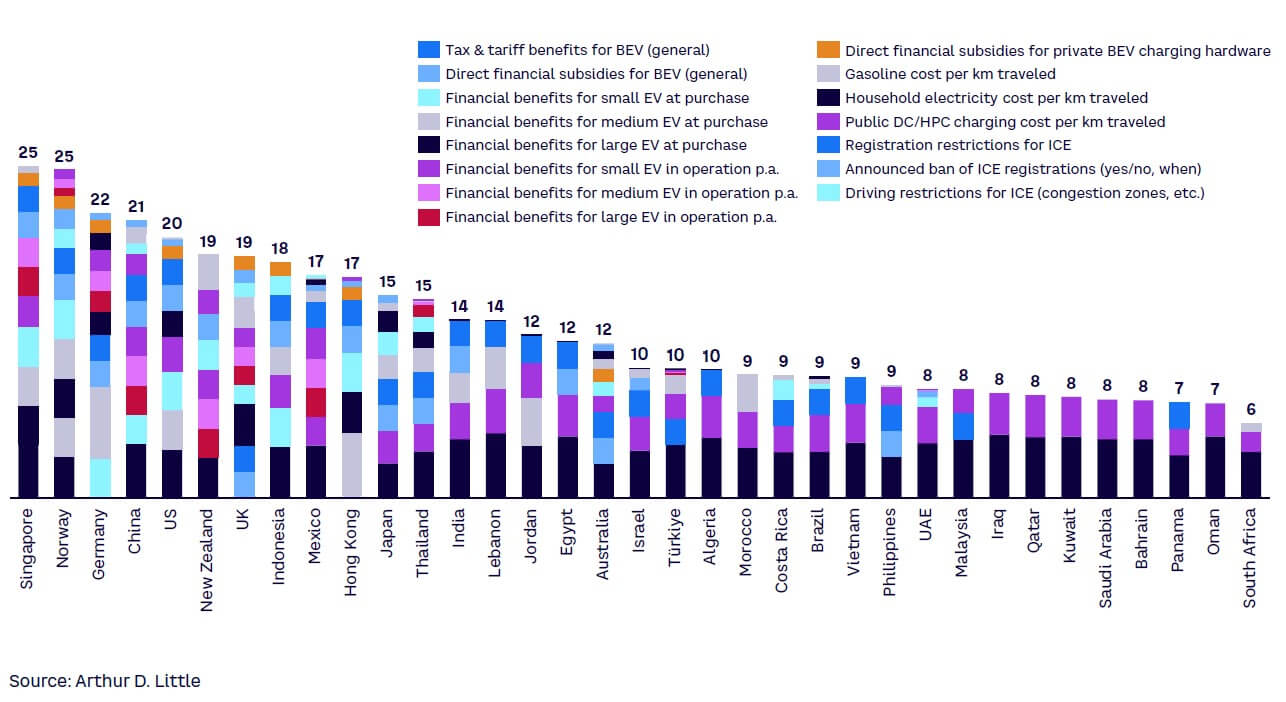
The classical example for taxation in favor of EVs is Norway. Without the value-added tax (VAT) on EVs, which is 25% in Norway, the end-customer price for a new US $50,000 vehicle effectively falls to US $40,000 for a private customer. As a business, one could deduct the VAT anyway. Thus, EV adoption in Norway has been driven primarily by private customers, which has pushed the market forward and allowed the overall network effects to generate advantages for commercial customers.
Singapore decreased tolls for EVs, making EVs not only more cost-efficient to buy but also to operate. Moreover, in some states of Mexico, EV owners are exempt from the “Tenencia,” an annual vehicle tax based on car value, which amounts to savings of approximately US $850. Additionally, in leading EV countries, the costs of driving 100 km on fuel is nowadays comparatively higher than those of doing so on electricity, also because of taxes.
Such policies aim to create a distinction between ICE vehicles and EVs. Customers’ ability to purchase and maintain EVs is a driving force. It includes financial incentives during purchase and when in operation. Beyond these benefits, the government offers incentives like the announced ban on ICE vehicles (see Figure 10) and free parking for EVs. Many markets, such as the EU, Israel, Türkiye, and Egypt, have already announced bans on the registration of ICE vehicles, which will become active in the next decade.
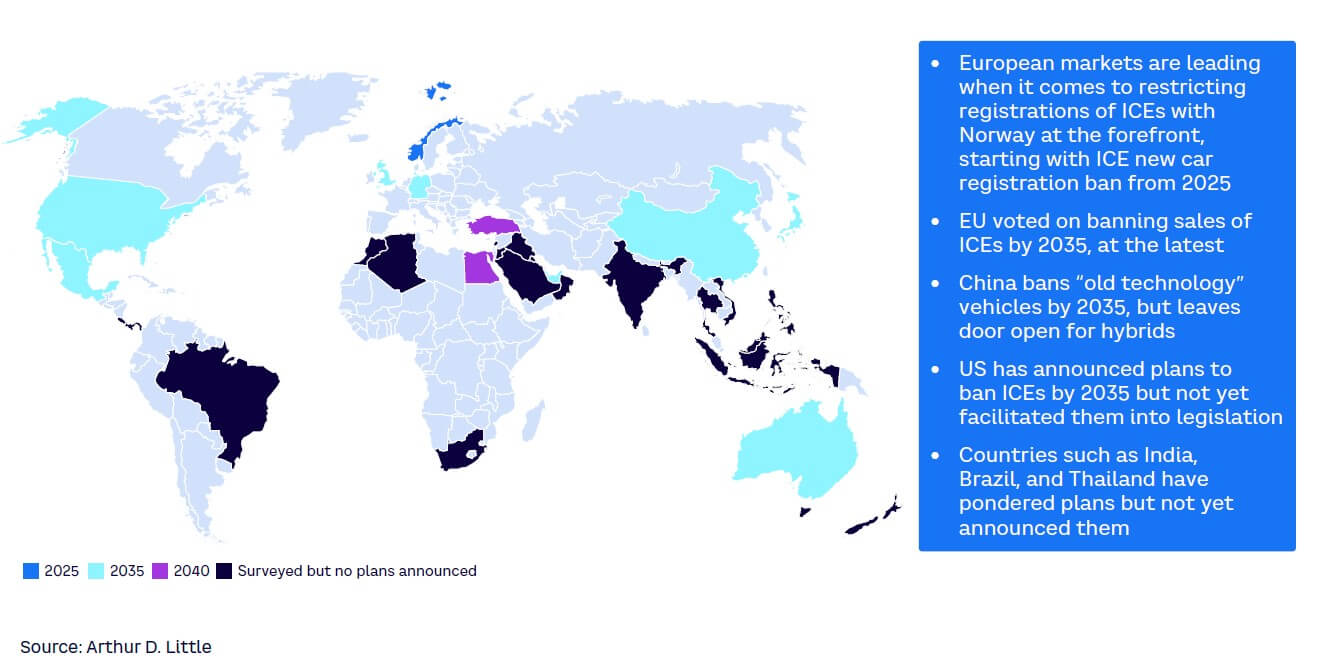
The comparison between gasoline and electricity prices also leads to determining the favored mode of transportation. Some countries are characterized by significant oil reserves, driving oil prices down. As a reaction, for instance, the Lebanese government has reduced subsidies on fuel prices. It indicates a “disincentivization” of gasoline. Thus, the push from the government becomes more crucial in shaping the affordability, demand, and development of the EV sector.
2
GLOBAL BENCHMARKS
What markets can learn from global benchmarks in EV readiness
A consistent trend is that BEV powertrains are key to decarbonizing transport and contribute to decreasing carbon emissions. This is particularly so for passenger vehicles, as well as light commercial trucks, and likely will be the main technology over the next 20-30 years. However, the full value chain, including suppliers, OEMs, and customers, will have a difficult time through the transition.
Norway, still the front-runner in e-mobility, shows how long it may take to turn even a small market and vehicle fleet toward EVs. Norway’s journey began in 2011, when EVs were rare and exotic, and the first Teslas were not yet in series production. Ambitious Followers and Starter Markets will have it easier today, as key market conditions like EV availability, comparative TCO, and environmental awareness have improved on a global scale over the last 10 years.
Financial incentives for EVs and disincentives for ICEs may still be adequate support measures in a starting market, where only pioneers with home-charging ability use EVs. However, to enable true and mainstream transition, all markets require a functioning ecosystem for EVs, which must work hassle free for users. Thus, the stage must be holistically set up by multiple parties and stakeholders.
Infrastructure
Formerly independent industries, such as vehicle OEMs, energy companies, road infrastructure/service providers, and telecom and software companies, need to work together with local and national authorities to provide widely available, easy-to-use, and reliable charging infrastructure for EVs.
Only an integrated approach can ensure cost-effective and customer-oriented infrastructure development without jeopardizing grid stability and macroeconomic feasibility. While this infrastructure was mainly AC-based in the early periods of electric mobility and in starting markets, nowadays the importance of DC fast charging becomes clear. Long-distance mobility with EVs and widespread EV adoption, especially among drivers without home-charging opportunities, can only work with a dense, fast-charging network along all major routes.
Closed-loop EV supply chain
Successful EV markets require a resilient, sustainable, and effective EV supply chain either domestically or in close reach. China is the prime example for setting up a competitively strong EV industry end-to-end in no more than 10 years. This involves the availability of raw materials, key components, and focal capabilities for EVs. It also necessitates a circular approach — reducing and reusing natural resources — to make e-mobility a truly sustainable alternative and ensure supply of scarce inputs. Other examples of this approach can be found in Central and Northern European markets, which have discovered the attraction of domestic battery production and recycling. In addition, SEA, with automotive hubs in Thailand, Malaysia, Vietnam, and others, is already setting up to follow this EV cluster strategy.
Multi-stakeholder orchestration
Governments and regulators have played a central role in supporting e-mobility and will continue to do so. However, they need to change their approach since many markets have reached new levels of maturity. EV infrastructure and supply chains are key prerequisites for successful e-mobility markets of the future. Both require holistic and integrated action from disconnected parties and market actors. Such a “garage band” needs a conductor to become a symphonic orchestra, and markets need more than tax incentives on one hand and restrictions on the other.
Corporate players, too, can assume the role of integrators. Markets in which either entrepreneurs or authorities successfully assume integrative roles in the areas of infrastructure and supply chains will become Ambitious Followers quickly, or even future leaders.
Market readiness differences attract different players
Leaders & Ambitious Followers
Mature EV markets like Norway and China are experiencing increasing competition among market players in the EV sector — for both vehicles and infrastructure. Ambitious Followers are at a stage that enables the entry of all kinds of EV actors, holding potential for established EV OEMs and scaled-up providers of charging infrastructure and ecosystem services. Customers in these markets appreciate a growing and still improving offering and have a rather high willingness and ability to pay — but also hold high expectations. The competition is increasing, especially with new EV OEMs entering the global field. These markets will see further consolidation, and market-entry barriers for new entrants are already high.
Emerging EV Markets
Players that still want to shape an EV market with new and selective vehicle offerings and charging infrastructure solutions will turn to Emerging EV Markets in the Middle East or SEA, such as the UAE or Thailand. These markets are not yet fully divided up among incumbents and growing rather quickly — a very promising environment in which to scale up and create a home base for later expansion, or to enter for increased market share and dynamically growing revenues. Governments in these regions have clear transition plans and support e-mobility with legislative and fiscal action.
Starter Markets
Slightly late to the party, Starter Markets offer huge potential for new start-up-style entrants and early infrastructure development in a “blue ocean environment,” where market shares are not yet divided up. However, profit pools need to be developed first. These markets require some (financial) patience and willingness to invest. Established players would rather wait for others to prepare the ground and make a late market entry with scale and financial power. Many Starter Markets have taken action by establishing local EV manufacturers and full EV ecosystems with component and local energy provider partnerships to set up a charging infrastructure.
How actors can cope
Vehicle manufacturers
Manufacturers must adapt their offerings and supply chain planning to market-readiness levels (e.g., in quantitative sales planning and product management). However, there is no time to lose, and manufacturers that have yet to embark on the EV journey will face more than hard times to survive the industry transition during the coming years.
In markets with higher GEMRIX scores, such as Ambitious Followers, EV sales planning can follow proven methods, considering target segments, pricing, positioning, and product specifications. In addition, sales planners should note that powertrain disruption usually decreases brand loyalty. A convincing EV model offering helps conquer market share and tap into new market segments. Some successful examples show that positive brand repositioning and expansion into new markets can work with electrification.
Starter Markets and markets with lower readiness, however, need special methods of sales planning and market entry. OEMs frequently prefer selective offerings, first targeting the most promising customer segments with lower risk. New sales models and sales channels may help mitigate risks and lower investment requirements. All sales planning must adjust to the fact that a new offering is only one part of the required market preparation. In particular, EV introduction in less mature markets requires a well-planned launch strategy. It may, nevertheless, be more successful than expected due to the lower level of competition. For a brand, gaining market share with new EVs is even easier in a Starter Market than in more mature environments, while lower absolute sales volumes need to be dealt with.
Infrastructure providers
Norway and Ambitious Followers are experiencing consolidation of the charging infrastructure market already. This includes the formation and shift of roles between energy providers, charge-point operators, and asset owners. Players that have not yet pegged their positions — and established partnerships, customer bases, and solid market shares — will face difficulty in keeping up with development. For incumbents, now is the time for scaling and setting up fast public DC charging in attractive locations. Increasing utilization of charge points will be key to improve economics. Public megawatt (MW) charging for trucks and commercial vehicles will be the next big topic in mature EV markets.
Infrastructure players in Starter Markets should avoid copy-and-paste strategies from early EV markets like Norway, and not rely on the rollout of wide AC networks in the public space. Today’s customers in many developing markets require public charging, as they lack private parking and charging possibilities. Leapfrogging to quicker DC charging solutions at destinations and charging parks in fuel station locations is turning out to be the winning strategy to avoid the need for update investments five years from now.
We expect today’s Starter Markets to develop EV readiness quicker than first-benchmark markets, and thus charging needs to catch up sooner rather than later.
#1 Norway
Still leading in EVs and sustainability due to first-mover advantage
Norway is leading the EV movement across the globe. In 2022, 80% of new vehicle sales were BEVs. This adds to a long history of leadership in many sustainability areas. For example, the country’s utilities sector is built mainly on renewable energy from hydropower, with 45% of its energy mix coming from that source; the first hydropower plant was built in 1892. Moreover, as far back as 2016, 98% of electricity production came from renewables.
One driver for Norway’s EV adoption is its high share of urban population. Of Norway’s inhabitants, 84% live in cities. As a result, typical range anxiety, a major inhibitor of EV adoption, is less relevant, since city driving covers fewer kilometers. However, given that Norway is a vast country, average trip length is high, at close to 15 km per day. The government countered possible range anxiety by launching programs to install charging infrastructure as early as the late 2000s, resulting in about 2,000 charge points by 2011. Today, around 25,000 public charging stations are available in Norway, including around 6,000 fast-charging stations.
As Norway has historically not had a large car industry, a new kind of automotive suppliers are currently flocking to this destination. For example, battery cell manufacturers FREYR AS and Morrow Batteries have set up shop in Norway, and battery recyclers Swedish Northvolt and Canadian Li-Cycle are building plants in the country. The high availability of renewable energy for electricity-intense operations is the key driver of this development.
Norway’s government resolved the previously mentioned economic chicken-and-egg problem through government-funded infrastructure projects and tax breaks for EVs. The first 2,000 charge points were built through a program costing just €7 million. Furthermore, Norway committed to establishing chargers at intervals of at least every 50 km at major roadways, and successfully fulfilled that goal. To further accelerate EV adoption, Norway suspended import taxes on EVs in 1990, decreased annual registration taxes in 2000, and slashed EV VAT to 0% in 2011.
Its focus on cutting taxes paid off as EVs became the major technology in 2019, reaching 50% of sales, and pure BEVs reached 50% of sales in 2020. Conversely, tax burdens on fossil-fueled cars are substantial.
In addition, Norway has set ambitious goals for the future, declaring a target of zero local emissions from passenger vehicles by 2025. Putting this in perspective, the EU aims for the same by 2035. EV adoption has reached levels in Norway that are allowing its government to roll back tax incentives step by step.
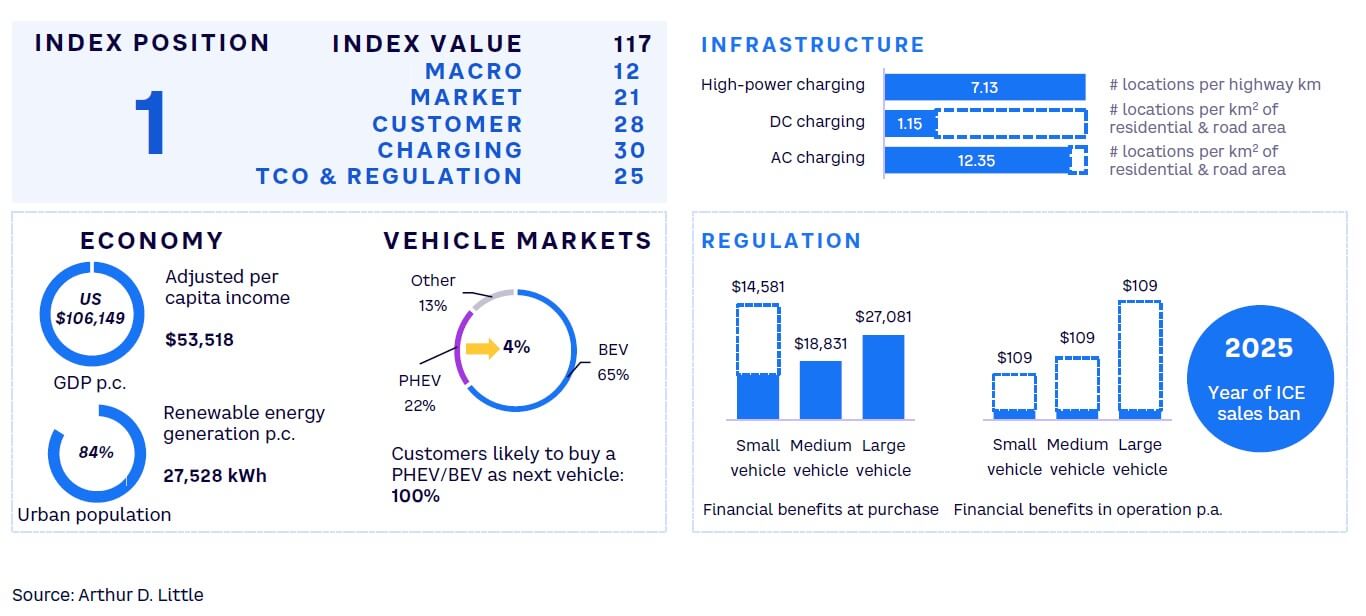
#2 China
Leading industrial BEV ecosystem enables global champion position
The EV industry in China is the largest in the world, accounting for more than half of global production (58%, according to International Energy Association [IEA]), and share of exported EVs from China have increased from 25% in 2021 to 35%. Plug-in electric vehicle (BEV/PHEV) sales amounted to nearly 25% of overall automotive sales in China in 2022, and these sales were increasingly driven by local automotive companies. When it comes to vehicle availability, China is the most developed EV market globally, with more than 90 brands offering over 300 models in all price ranges, from micro car to luxury. Local brands have a market share of more than 80%, among which are BYD, Wuling, Chery, and Changan. From China, there are also internationally active EV start-ups, such as Nio, XPeng, Zeekr, and Aiways. With China representing about 50% of the global BEV market, international OEMs must increase their value to customers and find cost-saving opportunities by designing vehicles to meet local requirements.
While global players are strengthening their technology position, they also need local ties to realize additional opportunities. Chinese OEMs such as XPeng, Nio, Geely, and BYD saw new record growth in EV sales in 2022. These regional companies are providing a superior experience to local consumers. Features such as strong human-machine interfaces and connectivity differentiate them from the competition.
With over 2.5 million charging stations added in 2022 alone throughout the country, China’s EV infrastructure continues to expand at an impressive rate. With the successful transition to EVs so far, China’s charging network has grown in step with other technologies, such as battery-swap stations. As a result, it has established itself as the current leader in EV infrastructure.
The Chinese government is supporting the development of the EV industry through regulation. There are encouraging policies and measures for both EV manufacturers and purchasers, as well as incentives for business operators to engage in and improve charging and other peripheral services. Financial benefits for customers can range from US $1,500-$2,000 per vehicle and US $1,000-$1,500 for manufacturers.
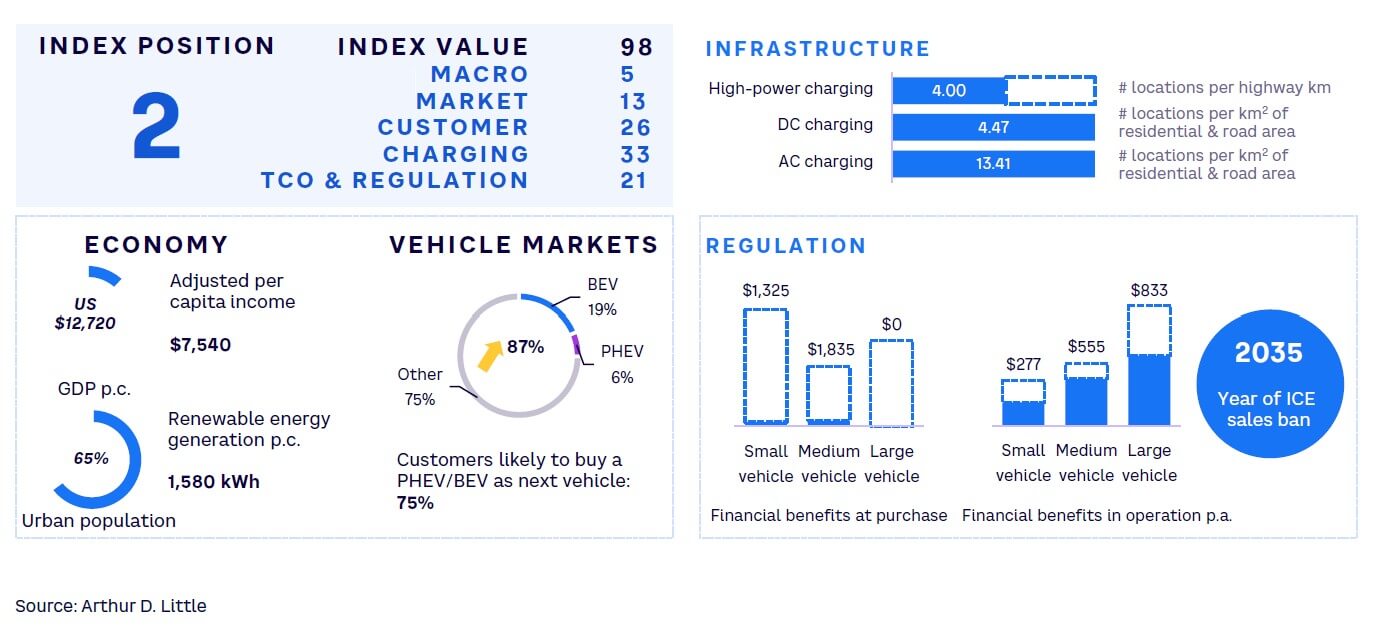
#3 Germany
Transitioning automotive industry and public awareness of sustainability and climate change
Germany has always been a strong automotive market, hosting many of the world’s most renowned brands, especially in the high-end sector. Comparing the number of cars on German roads to the population, statistically more than every second person owns a car in the country.
Additionally, environmental protection has long played a significant role in Germany. The first legislation on the “Energiewende” (energy transition) dates from the late 1970s. Today, about half of the country’s electric energy is generated from renewable sources. The political uncertainties around energy import from Russia have prompted Germany to increase local production of renewable energy even further.
The automotive industry in Germany, however, maintained a strong focus on ICEs for a long time. While the hype around EVs from 2010 to 2013 was already high in countries such as the US and China, German manufacturers only started serious production of EV passenger vehicles around 2019–2020. Despite the late start, German OEMs picked up the pace, and today, more than 120 different BEVs are available in the market, representing a healthy mix of local and international brands.
One of the major barriers to adopting EVs in Germany is the aforementioned chicken-and-egg challenge of consumer unwillingness to buy vehicles due to poor charging infrastructure and industry hesitance to invest in infrastructure due to poor vehicle sales. Germany recently made a new attempt to break this vicious cycle, with many new, attractive EVs coming to market that spanned all price ranges. Many of these vehicles come with a free (or at least well-priced) wall charger, making EVs an attractive offer for the considerable portion of the population living in single-family homes with parking.
German consumers have always tended to spend more for their vehicles (US $45,000 on average for new cars in 2022), and cars are still highly appreciated in parts of the population. Rural Germans often see the car as their only means of transportation. Combined with the substantial financial benefits offered by the federal government in 2022, EV adoption increased significantly. This, in turn, made investment in public charging infrastructure attractive for players from the automotive, oil, and energy industries, as well as start-ups.
Notably, German manufacturers’ sudden increase of vehicle models was also driven by the fact that other global OEMs, for example, from the US and China, are now competing heavily with established European brands. The newfound German appreciation for EVs also benefits from EU regulation like the announcement of banning registration of new ICE vehicles by 2035.
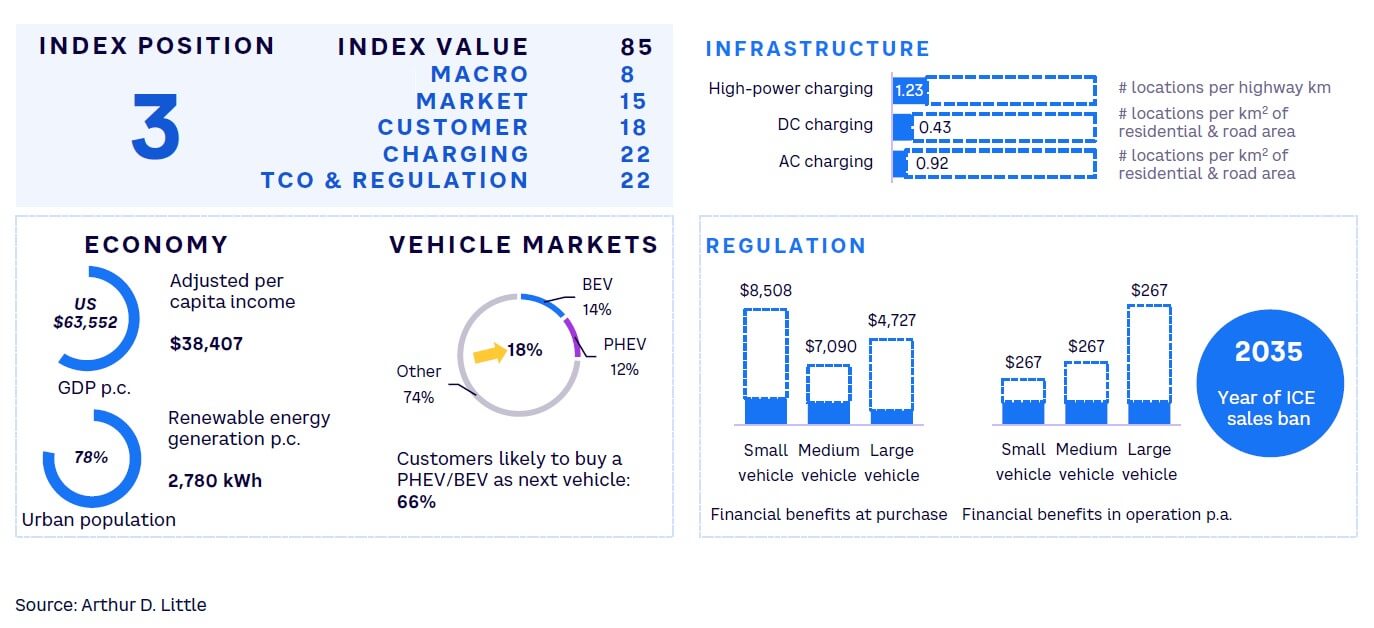
#4 Singapore
EV sales boom in Singapore with new governmental measures
Singapore suffered a setback in EV penetration during the pandemic but has bounced back sharply with new measures to promote EV sales. With a strong economy (a high estimated per capita GDP) and almost 100% urbanization, Singapore consumers are not anxious about driving range and are willing to pay a premium price for EVs, considering the manifold advantages. The government has also been clear about its encouragement of EV adoption through its announcement in March 2021 that all new car and taxi registrations would need to be clean energy models from 2030 onward, and that all vehicles on roads would need to run on clean energy by 2040.
EV sales are expected to continue to grow at an average annual rate of around 40% year-on-year — to reach an annual sales volume of just under 7,000 units by 2030 and an EV penetration rate of around 9.6% of total vehicle sales in the same year. In 2022, about 3,600 EVs were sold, representing about 12% of all new cars registered. Tesla has been the highest-selling EV brand, with a market share of about 24%, followed by BYD.
The Singapore government announced in its 2021 budget speech that US $25 million has been set aside over the next five years for EV-related initiatives entailing public-private partnerships. This could include measures to improve charging availability at private premises. Singapore will also accelerate the development of its charging infrastructure to better support the growth of EVs in the next decade, aiming to enable the rapid growth of EV sales at around 40% year-on-year. The plan is to deploy 60,000 charging points at public car parks and private premises by 2030 — which is more ambitious than the previous target of 28,000 chargers.
Financial regulations in Singapore are quite progressive as well. New policies such as the Vehicular Emissions Scheme, together with the EV Early Adoption Incentive initiatives, provide tax rebates to reduce the prices of some electric cars by up to US $15,000. From May 2022, to support mass-market EVs, those with up to 110 kW of power were grouped in the smaller car category in auctions for certificates of entitlement (COEs), lowering costs for consumers. This threshold was previously at 97 kW.
All these measures are motivating consumers and fleet operators to shift from ICEs to EVs as the transition becomes increasingly user-friendly. They have put Singapore at the forefront of EV adoption across the globe, second only to China in Asia.
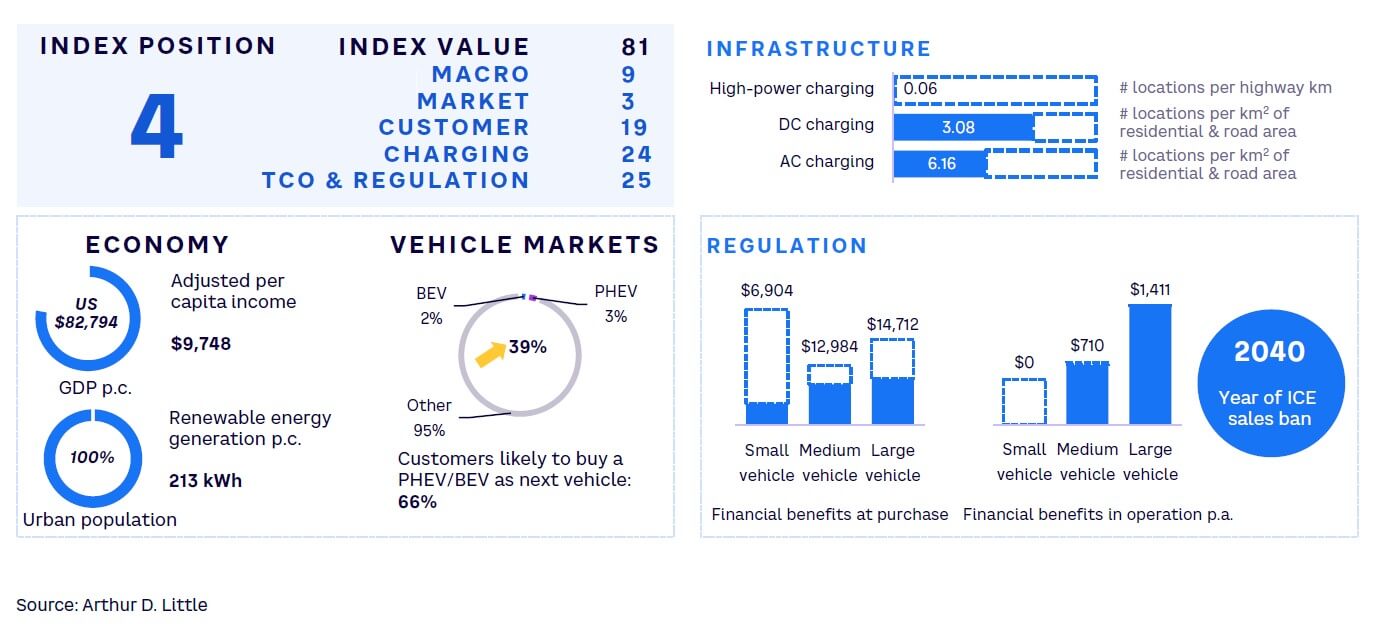
#5 UK
Fast acceleration of EV adoption — Government’s course is becoming unclear but not having a negative effect yet
Electric mobility is slowly becoming a success story in the UK. In 2022, the sales share of electric light vehicles climbed by 40% to 22.8%, while the overall car market suffered. The dominating technology is full BEVs, as nearly 17% of total vehicles sold used a purely electric drivetrain.
The UK government has set ambitious goals for building up its charging infrastructure. In 2022, the public and semi-public charging infrastructure stood at around 39,000 charge points, of which 6,900 were DC fast chargers with more than 100 kW, and a majority of 21,500 were AC with up to 22 kW. The country aims for at least six rapid charge points at every motorway service area by 2023. By 2030, more than 2,500 high-power charge points are scheduled to be added across strategic road networks. In addition to its large public infrastructure program, the UK subsidizes private home charging with a grant of up to £350.
One obstacle to EV uptake in the UK used to be renewable energy supply. The market has increased its speed in the energy transition, and 2022 saw record highs in renewable energy generation: wind contributed 27%, biomass 5%, solar 4.4%, and hydropower 1.8%.
Governments and cities are endorsing EV uptake through bans and regulations on the one hand, and incentives to empower end consumers on the other. The original plan to ban all new registrations of ICE vehicles by 2030 has, however, been postponed by five years. The effects will have to be monitored. Furthermore, parts of cities are regulated through congestion zones in which vehicle operators must pay if emissions and traffic density standards are not met. For example, in London’s Ultra Low Emission Zone, gasoline cars and vans must meet at least Euro 4 standards to avoid charges, whereas in Oxford’s Zero Emission Zone, every vehicle with local emissions is charged — even PHEVs.
Additionally, EV purchase subsidies are in place for up to £1,500, as well as exemptions from road tax and an expensive-car supplementary tax. Further, the UK government also drives corporate promotion of EVs with a capital allowance and a benefit-in-kind tax. In total, we estimate that a BEV company car has an advantage of more than £8,500 spread over three years over a similar ICE car.
In recent years, the UK has started to embrace the change from ICEs to EVs and is accelerating fast to nudge end customers in the direction of the electric powertrain. The steep increase in EV sales and the rapid buildup of infrastructure indicate its success.
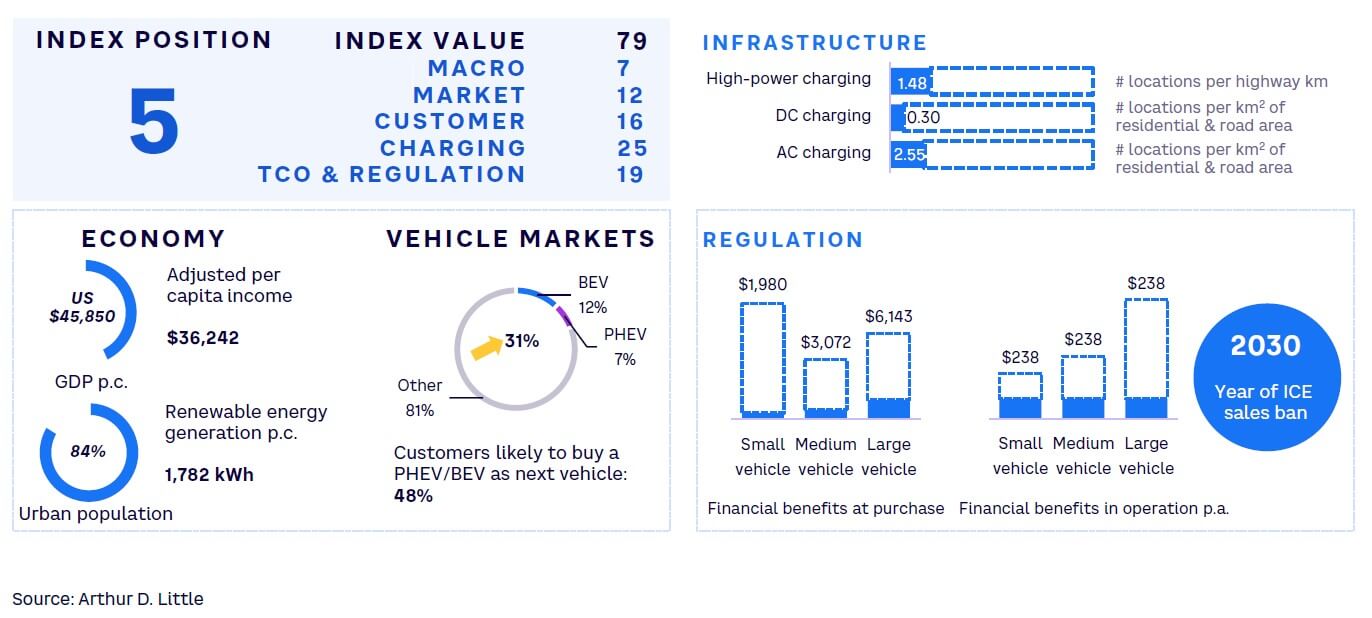
#6 Hong Kong
Charging infrastructure concentrated in residential and commercial buildings
Hong Kong wants to achieve carbon neutrality by 2050 and with the transportation sector being the second largest single producer of carbon emissions, electrification of road transport is an important stepping stone. This region has good overall conditions for an EV transition: an urban, young, tech-savvy population; well-developed electricity infrastructure; and a high smartphone penetration and GII score.
Hong Kong profits from the strong Chinese EV market. The local market for EVs is broad and well developed, as 188 EV passenger cars are available for sale, benefiting from the large offering of Chinese car brands. Unfortunately, only a negligible share of electricity in Hong Kong is generated from renewable sources. Therefore, EVs are not automatically a sustainable alternative, but they help reduce local or tailpipe emissions.
In 2021, the government of the Special Administrative Region implemented a roadmap to support the adoption of EVs, including long-term objectives and policies to reach net-zero vehicle emissions by 2050 (while planning to be carbon neutral overall at the same time). A ban on fossil-fueled cars from 2035 onwards sets a clear agenda, and the government has introduced waivers of first-registration tax (FRT) for EVs, leading to large financial benefits. Enterprises buying EVs can fully deduct the purchase price from their profits in the first year for tax reduction.
The government has also allocated funds for electric buses for public transportation. The EV sales share was 8% in 2022, while the share of fleet is currently around 6%.
Although authorities highlight the importance of charging at home or the workplace, more public charging infrastructure will be required to lower adoption barriers for EVs. A current government plan wants to have a minimum of 5,000 public chargers installed in Hong Kong as early as 2025, in addition to 125,000 chargers in residential and commercial building parking garages. The government has provided funds for installation of EV charging infrastructure at existing residential buildings. For EV users in Hong Kong, an increased transparency about public EV charging locations in the city, along with better accessibility, will make the transition to EV easier.
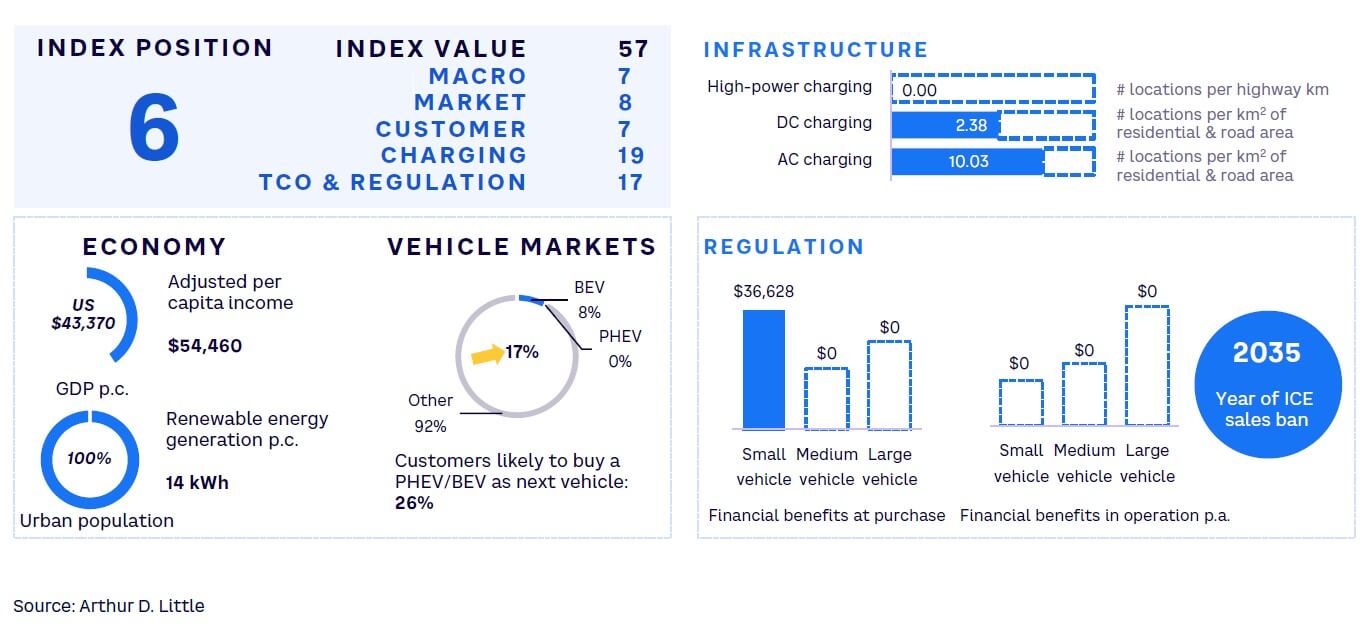
#7 UAE
Incentives support government’s ambitious EV vision; charging infrastructure fuels EV growth
EVs are increasingly visible on the UAE’s roads. This number is set to expand rapidly in the coming years and will interlink the transport and electricity sectors like never before, as the UAE aims to become carbon neutral by 2050. Under UAE Vision 2021, the government has placed a strong emphasis on promoting the adoption of EVs across the country. Dubai, for example, has launched its Green Mobility Strategy 2030, under which it aims to have approximately 42,000 electric cars on the streets of Dubai by 2030.
In 2015, Dubai launched the EV Green Charger initiative to enhance the availability of charging stations for EVs. The overall number of charging stations in the country has grown considerably to approximately 700 stations and is set to expand further. The Dubai Electricity & Water Authority and Road Transport Authority are working jointly to incentivize the use of EVs, with benefits such as free parking and exemption from tolls. By 2050, they aim to make public transportation emissions-free.
The concerted effort of both the government and private sectors in boosting the EV landscape has been met with a promising response from consumers; a staggering 82% are willing to purchase an EV as their next vehicle.
NWTN, a green mobility tech firm, wants to establish an EV assembly plant in Abu Dhabi with a 25,000 square meter facility. It will have an initial capacity of 5,000-10,000 units annually, with potential expansion to 50,000.
Adnoc Distribution, the UAE’s largest fuel and convenience retailer, and Abu Dhabi National Energy Company are coming together to create new joint venture (JV) E2GO. The venture aims to become the primary provider of EV charging points and infrastructure in Abu Dhabi, with plans to deploy a network of fast chargers at key locations, providing associated solutions like parking and tolling services and related digital platforms to enhance EV charging.
By unlocking new revenue streams and catering to the evolving needs of EV customers, the partnership is well placed to promote the adoption of EVs in Abu Dhabi. With the government’s continued support and collaboration with the private sector, the UAE is well on its way to achieving its goal of becoming a leader in e-mobility and sustainable transportation.
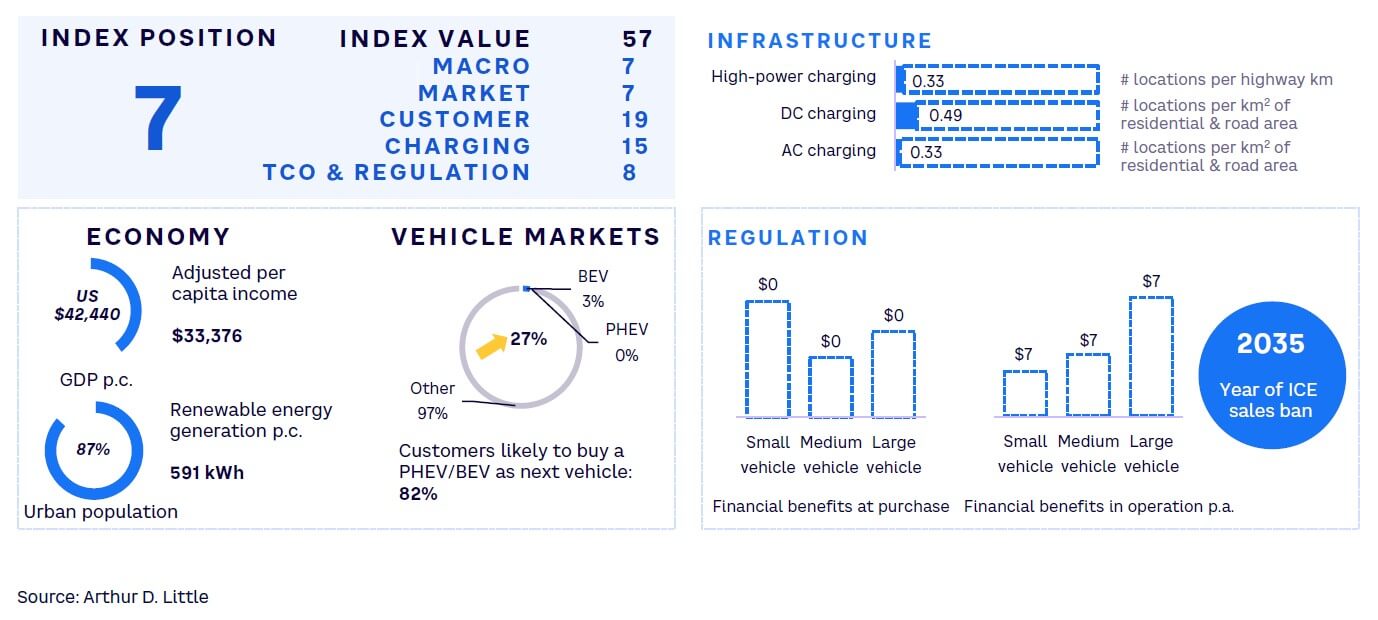
#8 US
Robust government measures continue to create sustainable EV ecosystem — driven also by one of the world’s largest EV OEMs
Until now, EV adoption has been slow in the US, where EVs were roughly 6% of sales in 2022. By the end of the year, only about 1% of the more than 280 million passenger vehicles in the country were electrified. As the US has always been a country of significance for the whole automotive industry, developments will be exciting to monitor over the coming years.
The US has favorable macro factors that are setting a promising framework for EVs: high GDP per capita at more than US $76,000 and 5.6% GDP growth over the last three years indicate adequate disposable income in many cases. One of the highest motorization rates across the globe, with nearly 830 cars per 1,000 inhabitants, establishes the potential of the market. High smartphone penetration of 82% and holding third place in GII rankings also shows the US’s affinity for innovative technologies.
The US automotive industry’s development is now supported by the country’s Inflation Reduction Act policies, including huge clean vehicle tax credits for domestic manufacturers of EVs and EV components such as batteries. The rise of Tesla arguably kicked off the electric mobility movement across the globe and revived the US automotive industry. Tesla’s Model Y and Model 3 are still the most popular EVs within the US. Ford and GM followed up on Tesla’s success by announcing ambitious EV sales plans and introducing electric versions of iconic pickups like the Ford F-150 and the Chevy Silverado. GM aims for 40% of global sales being electric by 2025 and 100% of US passenger EVs by 2035. Ford targets a 50% share of EV sales by 2030. New entrants are also trying to get their share of the market, such as SUV brand Rivian and Lucid Motors.
However, lack of infrastructure is a major inhibitor: charge-point density on highways is very low, at approximately two charge points per 1,000 km. The East and West Coasts boast better infrastructure than the Central and Midwestern states. Additionally, energy infrastructure might pose a problem for home charging, as residential homes are usually served by a single-phase power supply; only commercial sites have the three-phase power required for 22 kW chargers. This creates one of the largest challenges in the US, as range anxiety is the second biggest inhibitor, with more than 25 km traveled per trip per inhabitant.
Encouragingly, the current US government has announced more ambitious plans. It has declared a goal of 50% of sales being EVs by 2030, with the addition of 500,000 new charge points. It backs up these claims by subsidizing EV purchases with tax credits of up to US $7,500 and a fund for infrastructure rollout, including US $7.5 billion for the installation and operation of chargers. Together with the strong tailwind for manufacturers from the IRA, these developments make the US one of the most attractive countries for EV players in the coming years.
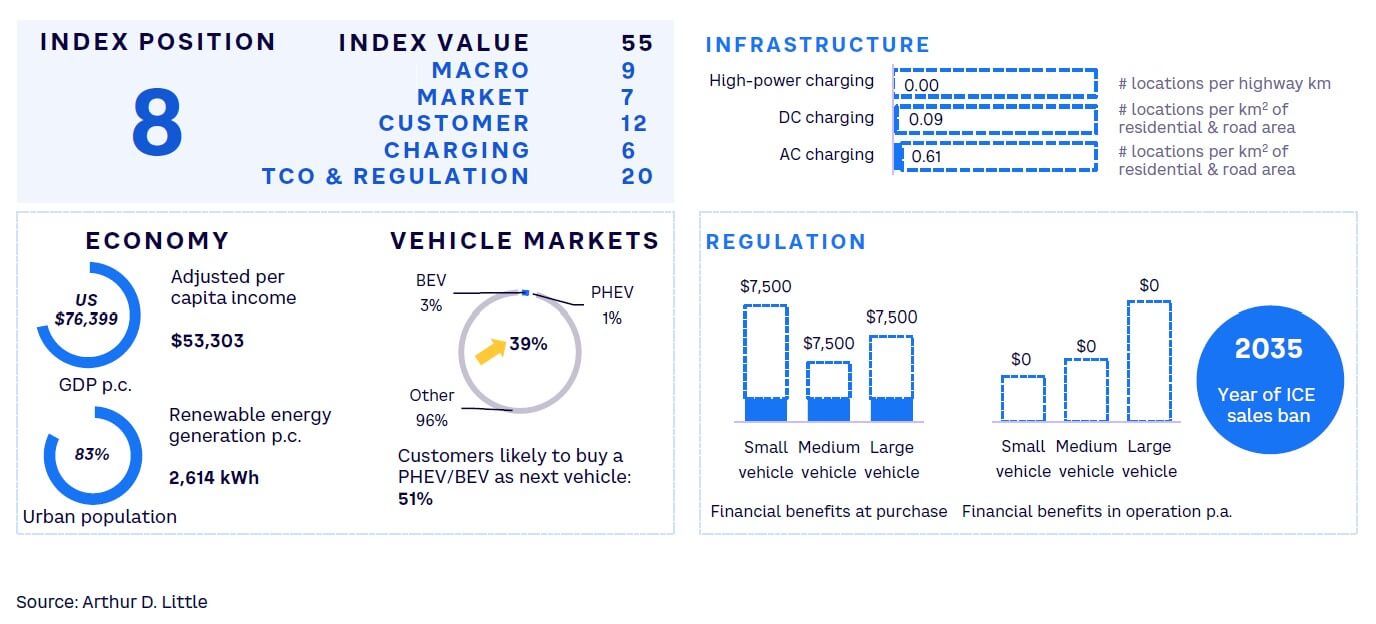
#9 Qatar
Policy frameworks and increased charging infrastructure are required to capitalize on growing customer EV readiness
With one of the world’s highest GDP per capita and a heavily oil-reliant economy, Qatar has set ambitious targets to transition from an industrial-based economic model to a sustainable, innovation-driven one. The country’s EV aspirations align with the vision to facilitate the transition.
According to Qatar National Vision 2030, the nation aimed to achieve 25% of its public transit bus fleet to be electric by 2022 and had successfully reached this milestone by year end. The Ministry of Transport, in line with Qatar’s Vision, aims to switch 35% of total vehicles in its fleet and 100% of its public transport buses to electric by 2030. These strong commitments are a testament to the potential of the EV market in Qatar.
A boost to the EV landscape comes from the recently concluded FIFA World Cup 2022 in Qatar, where the use of electric buses and taxis raised awareness of EVs among tourists and locals alike, while also encouraging consumers to choose EVs. In addition, to bring EVs and hybrid EVs (HEVs) to Qatar, the country is forming partnerships with several international automakers. For example, Qatar Free Zones Authority (QFZA) recently signed a multilateral framework agreement with Yutong, one of the world’s leading bus and coach suppliers, and Mowasalat, Qatar’s major transport services provider, to establish and operate an electric bus factory. Regarding charging infrastructure, Qatar General Electricity and Water Corporation (Kahramaa) and fuel retailer Woqod signed an agreement in late 2022 to supply, install, and operate 37 DC fast-charging units for EVs at Woqod stations.
In addition to the support for public transportation, the government is pushing for higher EV adoption among the consumer segment. The Ministry of Transport is actively promoting the deployment of personal EV charging units for private use, while financial institutions are responding to the growing demand for EVs and hybrids by offering green financing options to facilitate purchases. As a result, it is not surprising that nearly three-quarters of consumers are considering purchasing an EV as their next vehicle.
The government’s strong commitment to promoting green mobility is evident in the active participation of various ministries, offices, and stakeholders in developing robust infrastructure for EV charging and offering a broad range of benefits like free charging. These efforts, combined with a focus on enhancing charging infrastructure and providing incentives for EV purchases, are expected to accelerate the growth of the EV market in Qatar and contribute to achieving the country’s sustainable, innovation-driven economic goals.
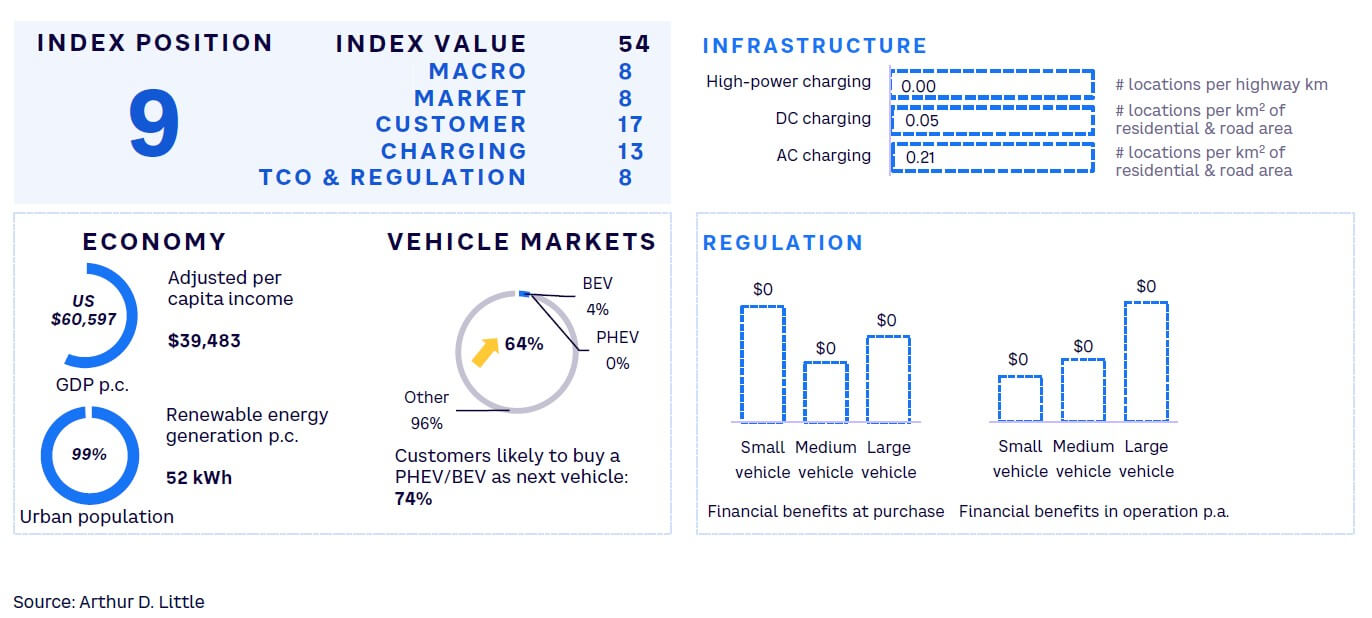
#10 New Zealand
A promising EV market with loads of renewable energy and lack of public charging infrastructure
New Zealand is known for its tourism and beautiful landscapes and shows increasing awareness of the need for a sustainable economy. Climate issues are particularly important to New Zealanders, especially given that the Asia-Pacific region has suffered severely from natural disasters.
New Zealand is likely to ban sales of ICE vehicles by 2040 but has thus far not taken legislative action in that regard. It could improve its GEMRIX position once a ban has been introduced. However, the government has taken action on other ends, such as implementing trade policies that focus on sustainable growth and ceasing fossil-fueled subsidies. For instance, it has introduced an exemption for road user charges that apply exclusively to EVs. These will be in place at least until March 2024. The government is targeting an EV share of 2% of all light vehicles on the nation’s roads by that time. EV sales shares have reached approximately 7% in 2022, and PHEV sales have been at more than 15%. Currently, sales shares are increasing at a high speed.
As a quite wealthy society, with a GDP of more than US $42,000 per capita and a solid economy and political system, New Zealand has good starting conditions for a transition to EVs. Also, it has a high urbanization rate, and strong interest in EVs has been expressed in surveys among consumers.
A large share of renewable electricity generation (around 85%) will help New Zealand not only reduce tailpipe emissions of its local car fleet but also lower overall carbon emissions from the road transport sector by the introduction of EVs. The government has set out to increase this share to fully 100% by 2030, enabling net-zero emissions via use of EVs.
New Zealand is specifically weak in public charging infrastructure, having a very low GEMRIX score and only one charger per 75 km of state streets. As a market of “home chargers” currently, New Zealand could step up to become Ambitious Followers quickly with an improved public charging infrastructure. Some providers have announced plans to install several hundred ultra-fast chargers over the coming years. Thus, a climb up the GEMRIX ranks is probable for New Zealand in the future. Currently, the growth rate of public EV charging infrastructure is more than 30% year-on-year.
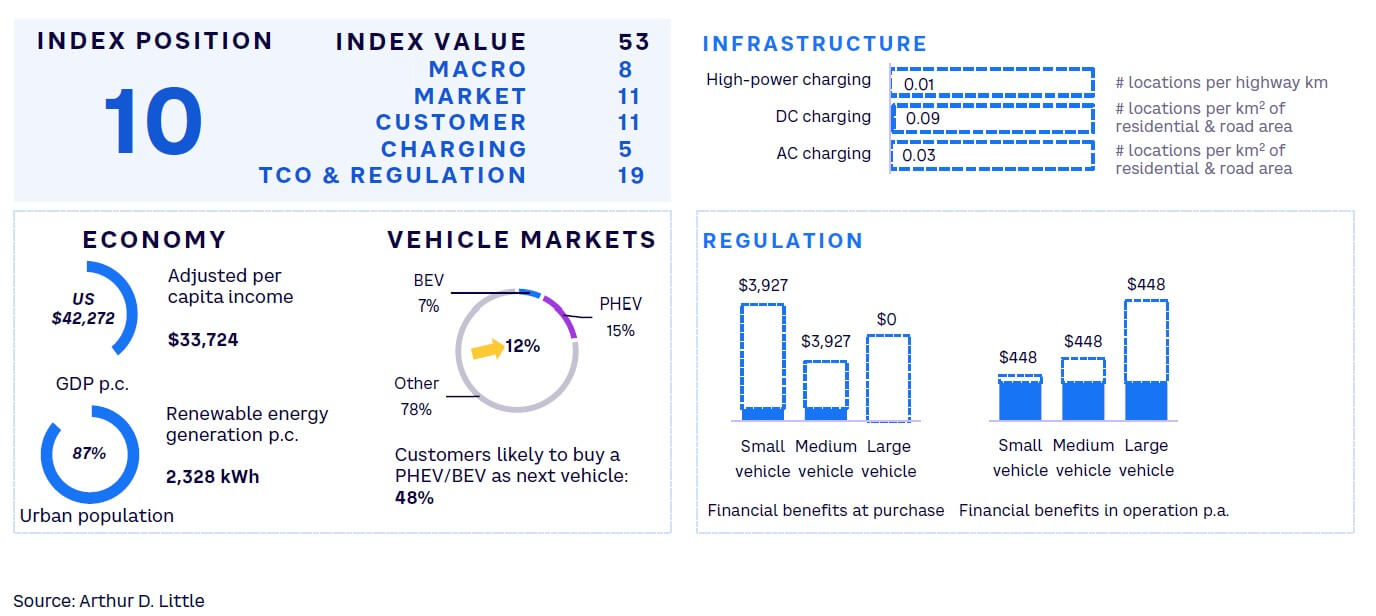
#11 Japan
A huge HEV market prepares for start of full electrification
EV sales as a percentage of total auto sales for Japan were about 2% for 2022, with an estimated annual sales volume of about 77,000 units — a huge jump from around 42,000 units the year before. However, while EV adoption is rising slowly, recent initiatives taken by the government and OEMs are expected to bring a much-needed boost to electrification.
In 2021, the Government of Japan set a target for all new cars sold by 2035 to be environmentally friendly, which will push EV sales. The government has also subsidized part of the cost of purchasing EVs, particularly BEVs, PHEVs, and fuel cell EVs (FCEVs). Local automakers such as Toyota, Suzuki, and Honda expanded their EV offerings in 2022 for the first time, after betting much longer on hybrid and (in small numbers) fuel cell powertrains. For Japanese consumers, 2022 marked the first year of EV model availability from domestic manufacturers.
While PHEVs and BEVs have not seen high adoption in the country, HEVs are still quite popular, reaching a record in sales share of 49% of total auto sales in 2022. Japan also has a strong EV charging infrastructure, with about 30,000 charging stations, and the government plans to increase the number to 150,000 by 2030. With a strong mix of urban population and regulatory push, Japan is slated to become one of the bigger EV markets globally.
Japan’s laggard approach to e-mobility is largely due to its huge investments in gasoline-electric hybrids. For a long time, the Nissan Leaf was the only successful BEV operating in the country. Thus, both the government and Japanese companies have good reason to hold their bets on EVs.
Today, Japan dominates the global market for the current generation of gasoline-electric vehicles. Given customers’ familiarity with this technology, their preference to shift to PHEVs/BEVs is far lower than that of other developed nations. Almost half of all vehicles sold in Japan are HEVs. After incentives provided by the government in 2012, electric charging infrastructure developed rapidly in the country, with more than 30,000 stations already operating.
As demand for HEVs continues to rise, the EV charging infrastructure will further improve. The government provides subsidies at the point of purchase for EVs, but no such incentive is currently provided for operating EVs. The latest changes in the strategy of Japanese OEMs have shown that incumbents like Toyota will surely move quickly to avoid being left behind.
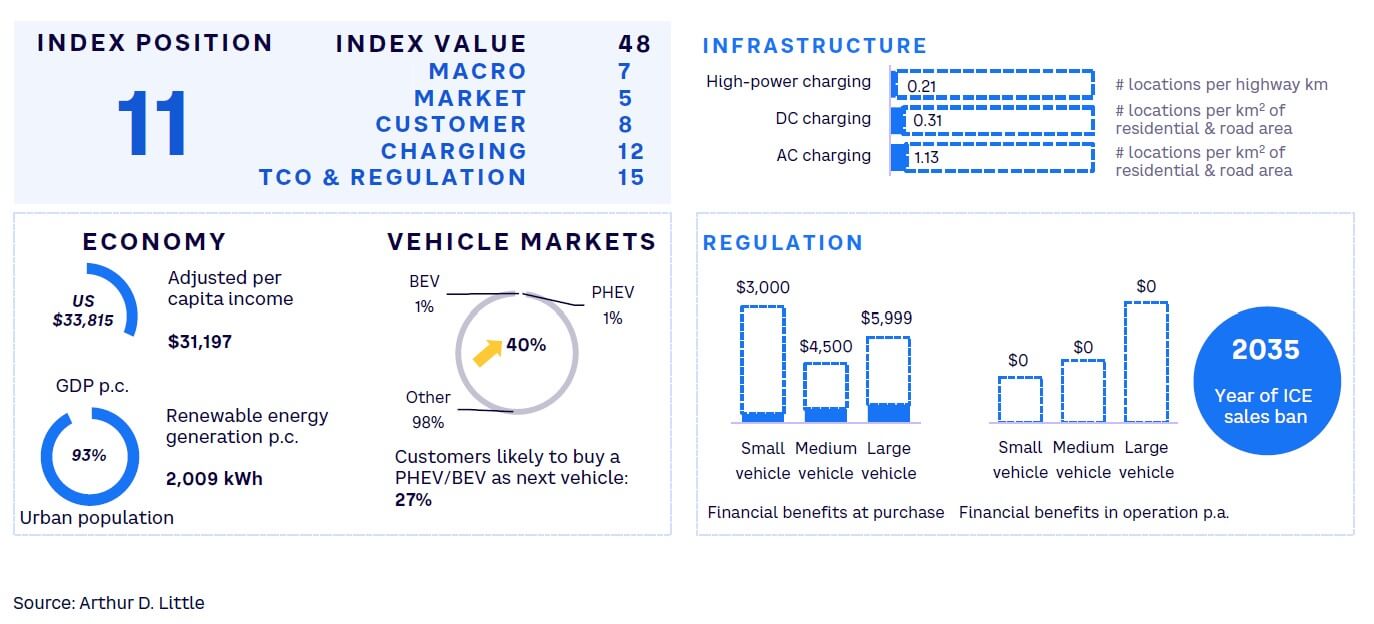
#12 Israel
Propelled by boost in public charging infrastructure and e-mobility innovations
Israel is a highly urbanized, densely populated country with a high dependency on private car commutes. Its commitment to fighting climate change has resulted in an impressive growth story for EVs in the country, which ranks among the top countries in the region in terms of EV readiness. The government’s announcement of making electric cars the only option for purchase from 2030 has further boosted the EV landscape.
Moreover, Israel’s ranking of 16th in GII underscores its affinity for innovative technologies. Although the country’s EV industry is less mature than that of countries like Norway, Sweden, and the Netherlands, Israeli companies have developed some of the best solutions in the industry. Many of the equipment and solutions developed by Israeli companies are highly valued, even in mature markets. For example, StoreDot, an Israeli start-up, has developed a fast-charging battery that can charge an EV in just five minutes, while Electreon Wireless has developed wireless charging technology for EVs, enabling a more convenient charging experience.
A new deal between Toyota and Electreon will yield built-in wireless charging for future Toyota EVs, as well as an easy-to-install kit. With such innovative solutions, Israel is poised to break into the top bracket of countries leading the global EV market.
With one of the highest rates of taxation on ICE vehicles in the world and lower rates for EVs, Israel has incentivized the adoption of EVs. The availability of public charging stations and good electricity infrastructure has also facilitated the EV uptake among customers. As a result, around 45% of consumers will likely buy an EV as their next vehicle. Most current EV purchases in Israel are Chinese imports, with BYD and Geely becoming popular brands and beating legacy players like Hyundai and Kia in sales numbers.
According to Israeli experts and importers, advanced technologies, higher availability, and better configuration are the three main reasons for the success of Chinese EVs in the Israeli market.[2]
However, rapid growth of EVs has put the Israeli government in a conundrum. The government is discussing doubling the purchase tax on EVs from 10% to 20%. The intent is to emphasize public transportation versus massive private EV car usage, as one government official reported saying that the government’s “aim is not to fill the roads, but to encourage travel on public transport.” While this move may cause some confusion in the market regarding emphasis on public and private mobility, the overall EV industry is being bolstered by the government.
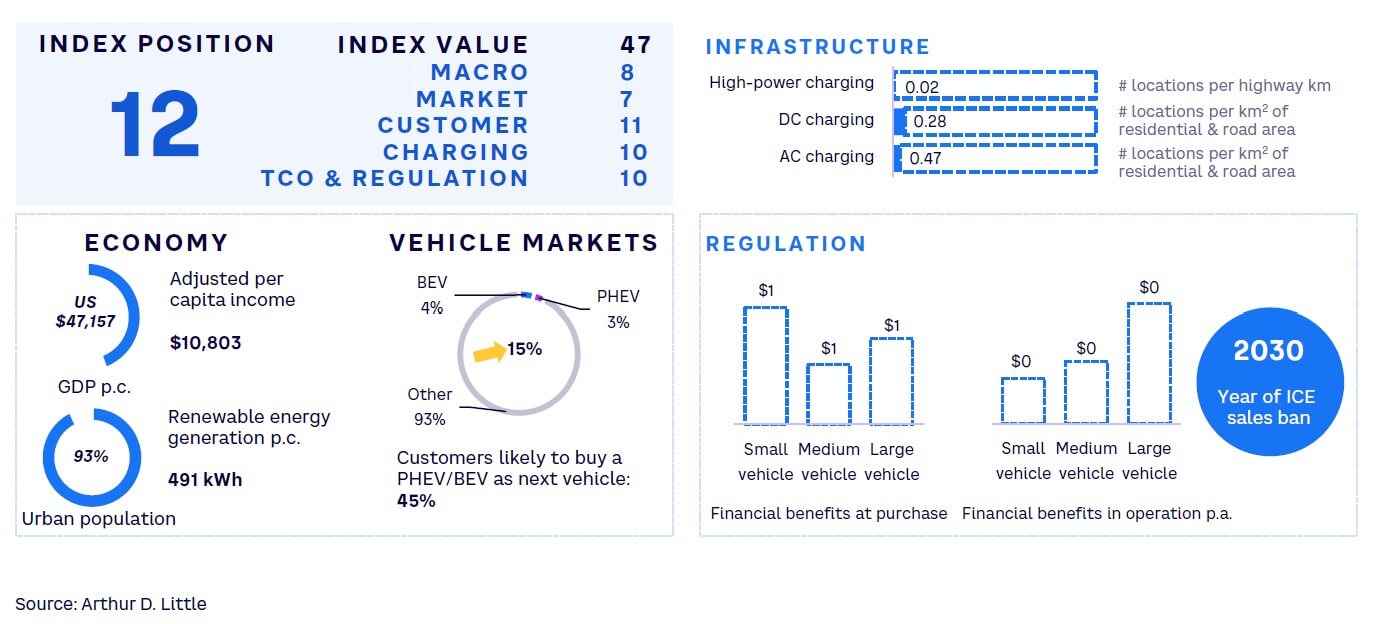
#13 Jordan
Well-developed electric infrastructure; young, urban population; and booming tourism industry bodes well for EV market
In the heart of the Middle East, Jordan is transforming into a sustainable and environmentally friendly nation. The country has shown significant interest in promoting EVs, particularly through government support. In recent studies, more than half of the population shows interest in buying EVs as their next vehicle. Jordan has a significant share of the young and urban population (92%), who are more likely to embrace sustainable technologies like EVs. Additionally, Jordan has a well-developed electric infrastructure, which is a key enabler for robust EV charging infrastructure and opportunities for home charging.
Jordan’s booming tourism industry will have a positive effect on expanding the commercial automotive sector. Intending to build a low-carbon transportation infrastructure, Jordan can capture this boom in commercial transport to enrich electric mobility. The country relies heavily on imported vehicles, focusing on used cars rather than new ones. Affordability is a key consideration for Jordanian car buyers. Thus, cost advantage would be a significant selling point for moving from fuel-based to electric cars. Therefore, the government must invest in charging infrastructure and public transportation to support the transition toward a low-carbon economy.
Jordan’s economic modernization vision aims to promote EV adoption as part of its strategy to reduce dependence on imported fossil fuels and promote sustainable energy solutions. The government has already implemented several initiatives to support EV adoption, including developing a network of electric charging stations. One such initiative is via a partnership with German electric charging station company eCharge to install 10,000 public charging points nationwide.
To meet rising demand, Jordan is also making strides in electrifying public transportation by purchasing up to 15 new battery electric buses (BEBs) in a pilot rollout for the first electric bus transportation network in the city. This project is part of a larger fleet expansion project that involves purchasing 151 buses — 136 diesel Euro V buses and 15 BEBs. Overall, Jordan has favorable conditions for EV adoption. With continued fiscal incentives from the government, such as exempted registration fees and lower customs duties compared to ICE vehicles, the country is well positioned to accelerate its transition toward sustainable transportation.
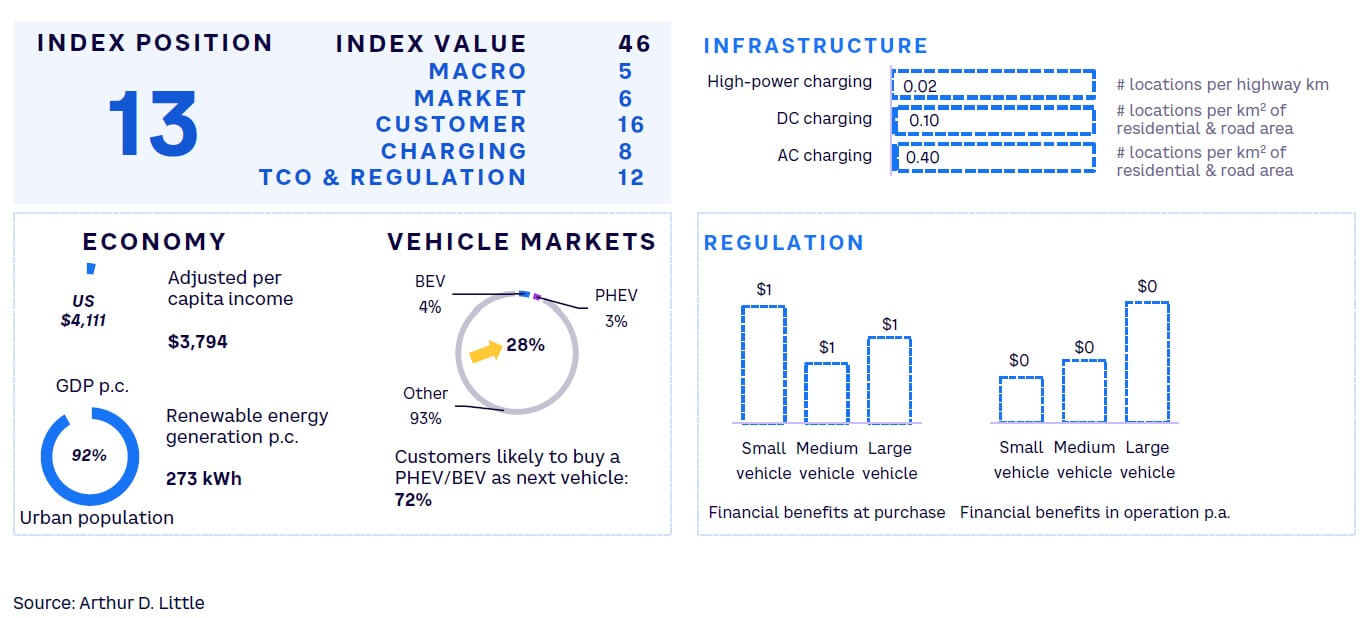
#14 Kuwait
Ambitious infrastructure goals and plans for the Middle East’s first EV manufacturing center indicate potential progress in transition
Kuwait’s e-mobility readiness is gaining momentum, with various initiatives being implemented to encourage the adoption of EVs. With 100% urbanization, there is a high concentration of people and automobiles in densely populated areas, which could make EVs a viable option for reducing air pollution and traffic congestion. In addition, the Internet penetration rate in Kuwait is 100%, which could facilitate simple access to online charging infrastructure, vehicle tracking, and maintenance services. Other potential indicators include Kuwait’s high per capita GDP and the government’s commitment to sustainable development.
However, Kuwait is a highly oil-driven market, with more than 50% of its economy generating output from the industry sector. Such easy and inexpensive availability of fuel poses a hindrance to the evolution of electric mobility.
Customers’ sentiment toward electric transportation is lukewarm, given no substantial value addition over ICE vehicles. On the positive side, the Kuwaiti population owns a high number of cars per 1,000 people. SUVs are Kuwait’s most popular vehicle type, accounting for a little less than half of the market. Kuwait is also an exceptional market for high-end luxury and vintage cars. This reflects that the average Kuwaiti is willing to spend a higher amount on cars. Kuwait also possesses an expansive auto parts supply chain by leading the supply services to Iraq and Afghanistan. These factors can add to positive acceptability of EVs as the transition takes place.
In October 2022, Kuwait-based logistics company Agility announced an investment of US $20 million in Loop Global, a US manufacturer of EV infrastructure. This exhibits the inclination of private players to move ahead in the EV space.
The Kuwaiti government’s infrastructure and environmental objectives are ambitious. Kuwait Ports Authority (KPA) announced intentions to develop EV City, the Middle East’s first EV manufacturing center, in August 2021. In fiscal year 2023/2024, design and construction contracts were to be put out to bid. The decision to create a facility for EV makers aligns with the vision of New Kuwait 2035. This vision strives to recast Kuwait as a trading hub. Strengthening trading relations would pave the way to come to par with other leading economies in transportation development.
Minister of Public Works and Minister of Electricity, Water, and Renewable Energy Ali Al-Mousa said in a statement to Kuwait News Agency (KUNA) that a proposed electric charging rule intends to give electric car chargers to clients.[3] The rule stresses that it establishes a mechanism to enhance the placements of charging points in different areas of Kuwait while taking technical limitations and Kuwait’s environment into account. “Preparing this regulation will encourage many foreign electric car-producing companies to enter the Kuwaiti market, which is one of MEW’s goals,” the minister added.
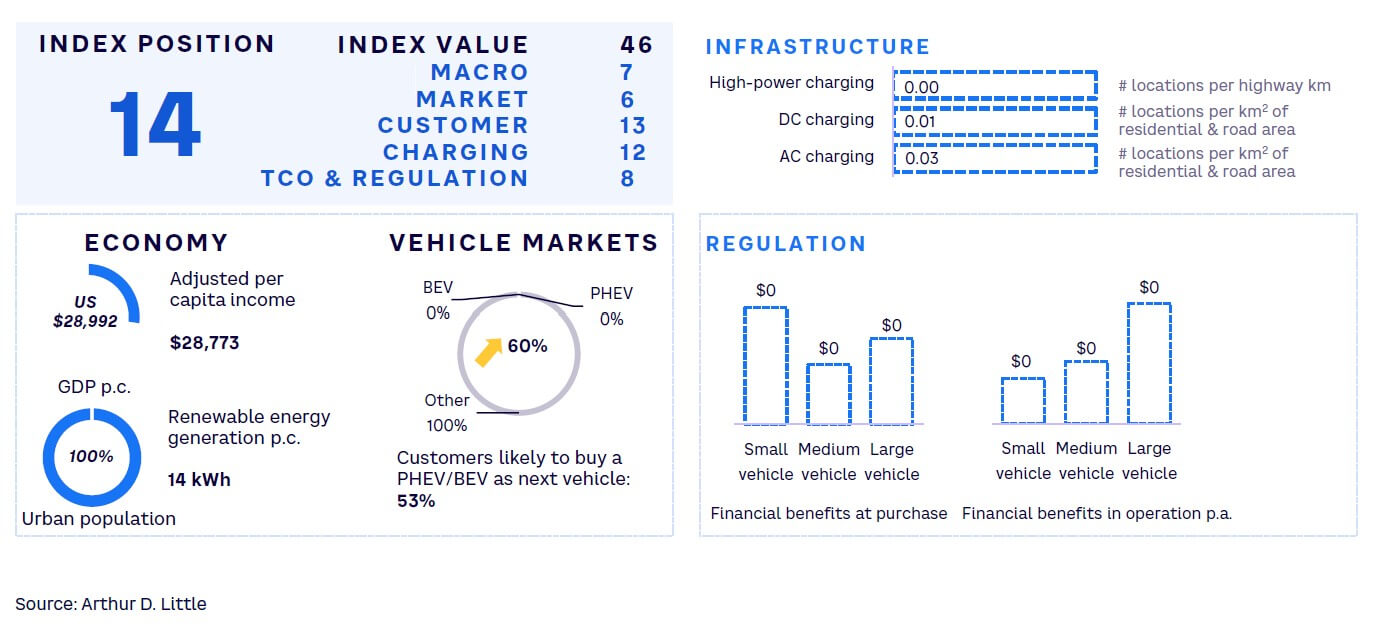
#15 Australia
Government incentives and increasing investments into charging infrastructure support double-digit annual growth of EV market
Like other large territorial states with populations clogging some urban agglomerations, EV shares of vehicle fleets differ greatly in Australia. This share is very low in rural and scarcely populated areas, but higher in large cities with better developed infrastructure and higher awareness of sustainability and climate change issues.
Australia is generally well developed and has a strong economy, with a high GDP of more than US $60,000 per capita. In 2022, its EV sales share was reported at 7% for PHEVs and 1.5% for BEVs. Australia announced that it would ban ICE registrations from 2035 onwards — putting it on tap with the ambition level of the EU.
However, infrastructure is a problem, especially in areas with low population and traffic density. There is a lack of fast-charging stations, especially at interstate connections. Several federal financial incentives are in place; for example, a higher threshold for net-zero-emissions vehicles in luxury car tax (LCT) has been introduced, and all customs duties have been removed for BEVs, PHEVs, and FCEVs. Additionally, zero and low tailpipe emissions vehicles are exempt from fringe benefits tax (FBT). Some territories have introduced additional benefits, such as free registrations for BEVs, direct purchase subsidies, and stamp duty waivers.
Australia’s share of renewable energy in electricity is still low, at below 40%, but growing. The grid is stable and well developed in urban areas.
Consumer interest in EVs has only just begun, as Australia is not a big car market and due to its right-hand traffic style is rarely among the first markets served by new entrants. Still, approximately 150 different EV and PHEV models are now available on the market, and steadily increasing in number. EVs may become more popular as new models are introduced beyond SUVs and sedans (e.g., pick-up trucks and vans).
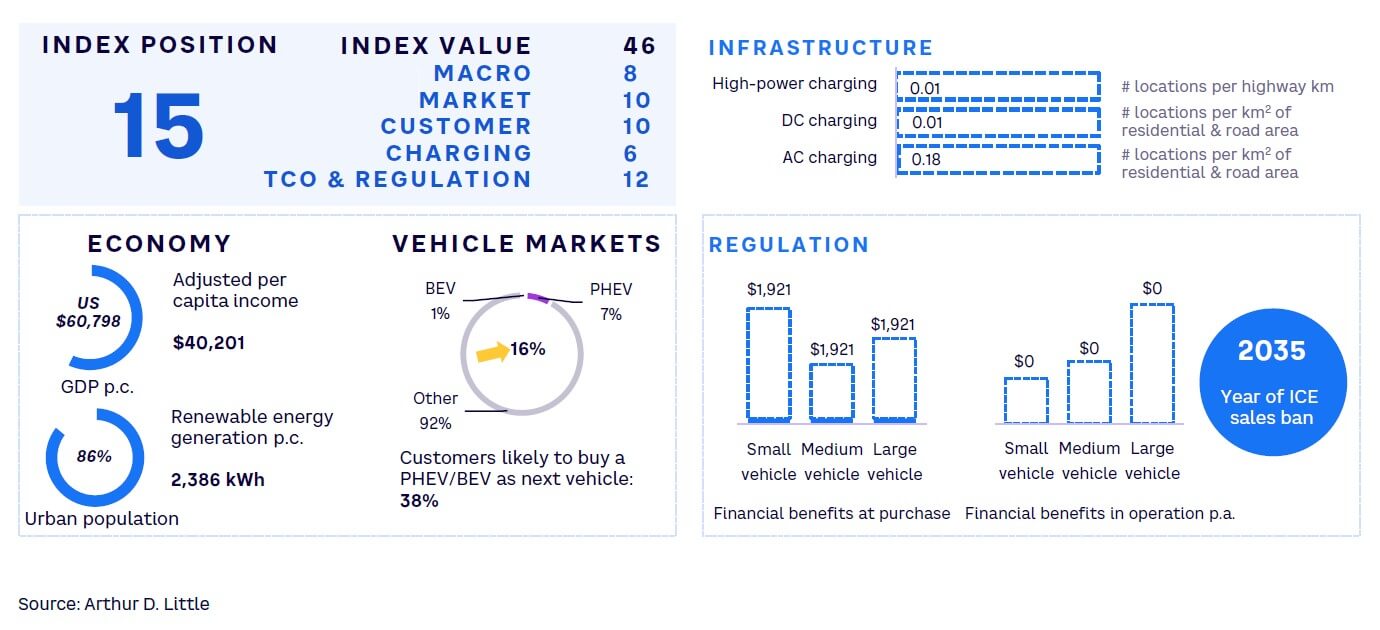
#16 India
Strong government push drives EV adoption
India is uniquely positioned in the EV space, with high customer adoption in a few segments. The current penetration rate of a little more than 1% is not encouraging, but given the country’s ambitions and capacity commitments, it might turn out to be the dark horse in the EV race.
More and more Indian-based manufacturers and local subsidiaries of international OEMs recognize the huge opportunity of the large local vehicle market. Tata Motors currently has a market share of more than 70% in the nascent market but will have to face increasing competition.
However, EV adoption has been higher for 2Ws and 3Ws in India in comparison to passenger cars, which have not had much traction. A lack of proper road connectivity, long charging times, and infrastructure constraints have funneled penetration in favor of 2Ws and 3Ws in the country, which remain the backbone of transport in the large urban centers.
The Indian government’s Faster Adoption and Manufacturing of Hybrid and Electric Vehicles II (FAME-II) policy is one of the most important regulatory factors driving the EV push. Although current EV infrastructure is barely present, both local and global players have placed big bets on setting up adequate EV infrastructure in the coming two to three years. A rising middle-class population, the government’s push to reduce carbon emissions, and increasing fuel prices are some other factors driving EV adoption.
The Indian government is providing several financial incentives to OEMs in EV manufacturing, which have been passed down to customers at the point of purchase. However, lack of adequate charging infrastructure has restrained customers from shifting toward EVs, which is still usually a preferred second car choice for aspirational consumers in the country.
A lot of nonfinancial incentives have been provided for EVs, which has further spurred adoption. Given India’s demographics, the shift will, however, be led by the metropolises of Delhi, Mumbai, Bengaluru, and Chennai before it trickles to other parts of the country. The lower cost and customer preference to travel smaller distances on bikes have led to faster adoption of 2Ws. Players like Ola and Ather have already sold out their first batches of EV bikes, and large OEMs like Hero, Honda, and TVS have shifted their focus to 2Ws as well.
India’s prominence in the global space is reflected in its mission to play an important role in the EV space. It remains to be seen if plans put in place materialize soon for the country to achieve its targets.
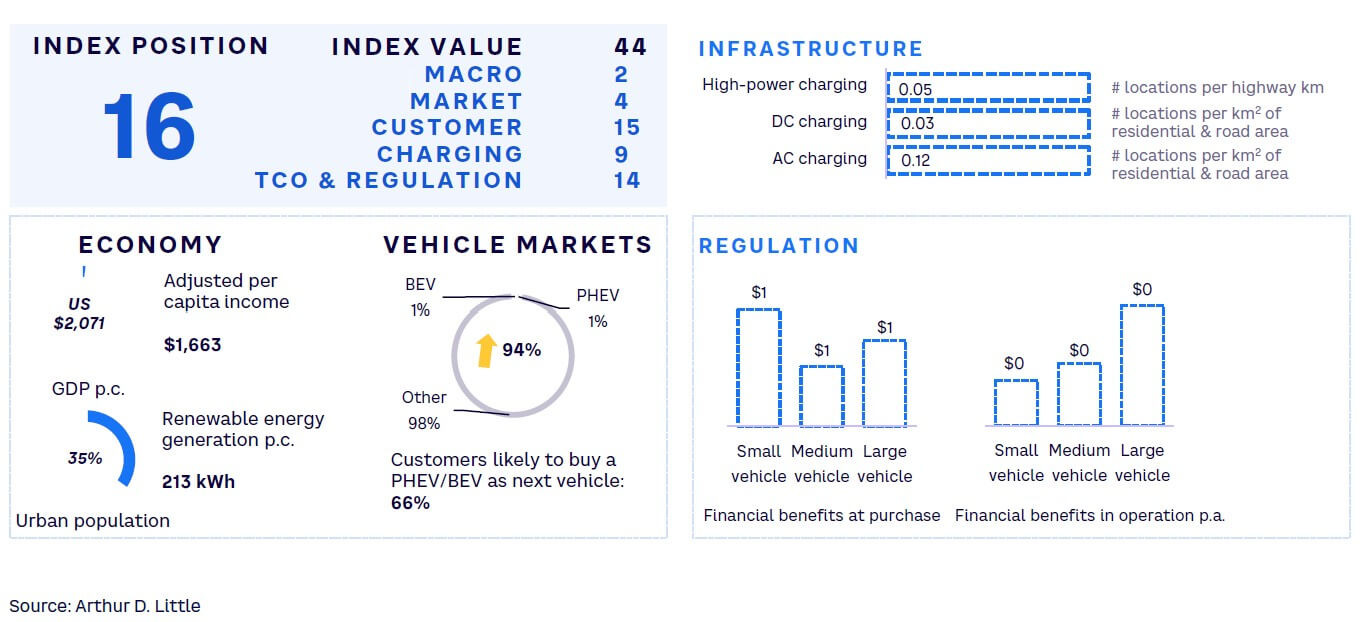
#17 Thailand
Strong stakeholder engagement enhances EV adoption
Often referred to as the “Automotive Hub of Asia,” Thailand has witnessed the flourishing of its automobile industry over the years. The industry contributes significantly to its GDP.
At present, EV penetration is still low, with a fleet share of below 1% and a sales share of 3% of all new cars as of 2022. It is encouraging to note, however, that almost half the population would prefer an EV in the years to come. To sustain this enthusiasm, Thailand will need active government intervention and stakeholder engagement. Recent progress is noteworthy. There has been a concerted push to fast-track EV adoption in the country. State-run companies, academic institutions, government agencies, and automotive associations are taking the lead in electrifying the vehicular fleet, particularly in the area of public transportation.
The Thailand government is supporting EV sales through various demand-side and supply-side incentives, including tax incentives for local EV production and import duties exemption on machinery. They are also offering a five-year corporate income tax exemption for investments in charging stations with at least 40 chargers. The government has set a target of 1.123 million net-zero-emissions vehicles by 2030, with a focus on electrification in the car and pick-up segment.
Also, the government has planned consistent efforts for building the country’s charging infrastructure. The Ministry of Industry, for example, targets the setting up of charging stations within a maximum 50- to 70-km radius in the years to come. To bolster this, three state enterprises — Electricity Generating Authority of Thailand (EGAT), Metropolitan Electricity Authority (MEA), and Provincial Electricity Authority (PEA) — have joined to support investments in EV charging infrastructure.
The Thailand National EV Policy Committee has introduced a roadmap as a framework for EV development from 2021 to 2035, with the aim of developing a well-established supply chain for manufacturing EVs and building the technological capacity for modern mobility.
With EGAT, the Ministry of Higher Education, Science, Research, and Innovation and several academic institutions have collaborated to form the Thailand Energy Storage Technology Alliance (TESTA), which has the objective of revolutionizing local storage technology, a key pillar of electric mobility.
Thailand, therefore, is set for accelerated growth in EVs in the next five to 10 years, with increased investments from local and Thai investors, coupled with government incentives. The government has committed to carbon neutrality by 2050, which will lead to a thrust in EV adoption from 2025 onwards. The government’s National Electric Vehicle Policy Committee has set the target of EV sales penetration at 30% by 2030.
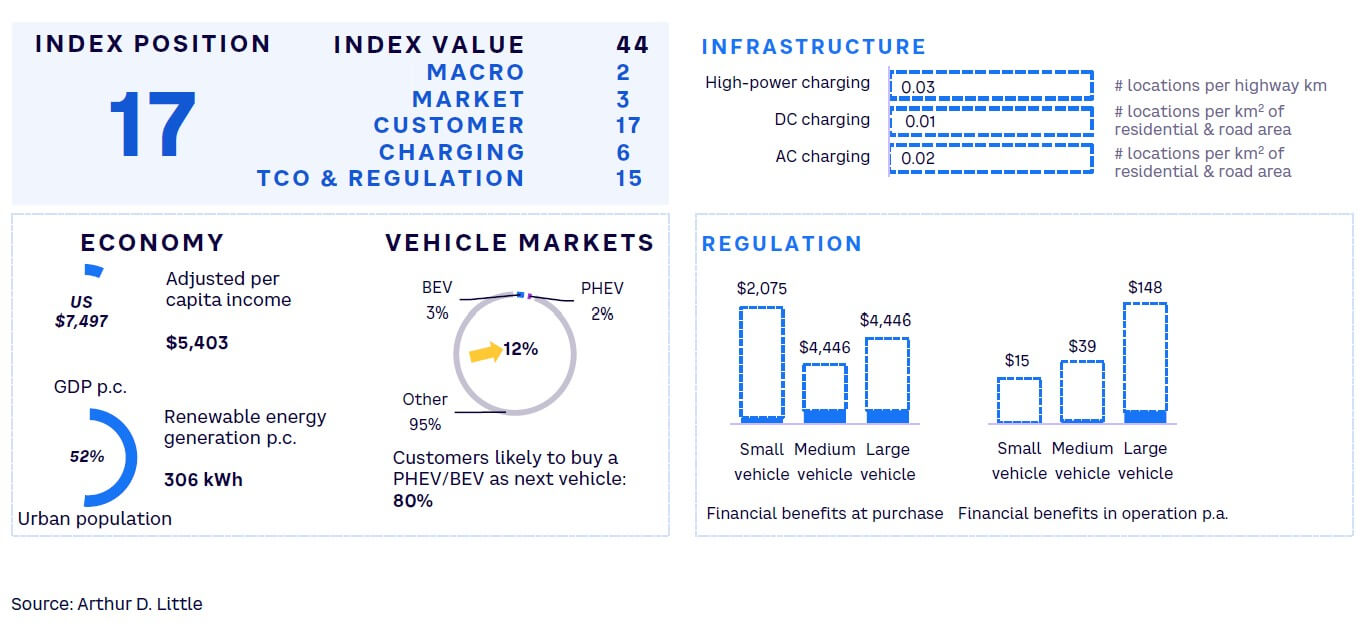
#18 Bahrain
Inauguration of first EV charging station and collaboration with micro-mobility firms paves way for growth
Bahrain has begun its first steps toward embracing EVs with the inauguration of the first EV charging station in 2021, following in the footsteps of other Gulf Corporation Council (GCC) countries aiming to electrify transportation. In addition, Bahrain’s Economic Vision 2030 emphasizes the importance of increasing sustainability. In the future, this vision can pave the road for progressive adoption of e-mobility solutions.
In November 2021, Bahrain launched its Logistics Services Sector Strategy 2022–26 to lift the logistics sector’s contribution to GDP to 10%. This would benefit the country’s commercial transportation in general. Given these broad infrastructural developments, electrification of logistical transit can be considered a future step.
Bahrain hosted a Decarbonization Roundtable Series to enhance understanding of carbon markets and their affect in achieving net-zero emissions, which could have implications for the development of the EV industry in Bahrain.
Furthermore, initial progress comes from collaboration between Bahrain’s Ministry of Transportation and Telecommunications (MTT) and TIER, the leading micro-mobility firm in Europe, to install emissions-free electric scooters and bikes across the city of Manama. Additionally, in 2022, the National Bank of Bahrain (NBB) joined hands with Bahrain National Insurance to offer discounted motor and EV insurance premiums.
This service is provided as part of NBB’s automobile lending program. Customers also will receive up to five years’ complete insurance coverage for agency repairs, as well as additional benefits like battery replacement and electric car recharging. In 2023, Bahraini company Marson Group announced plans to launch Bahrain’s first electric car factory. The organization has partnered with US manufacturing company Gass Auto for implementation. The factory intends to manufacture various EVs, including 2Ws and passenger cars.
Businesses that operate in the oil and gas business or generate money from the extraction or refinement of fossil fuels in Bahrain are exempt from all taxes, including income, sales, capital gains, and estate taxes. Because of the government’s significant hand in the fuel industry, private companies are not adequately incentivized to operate in non-oil businesses. Bahrain still has a long way to go in encouraging OEMs and auxiliary companies to enter the EV car market.
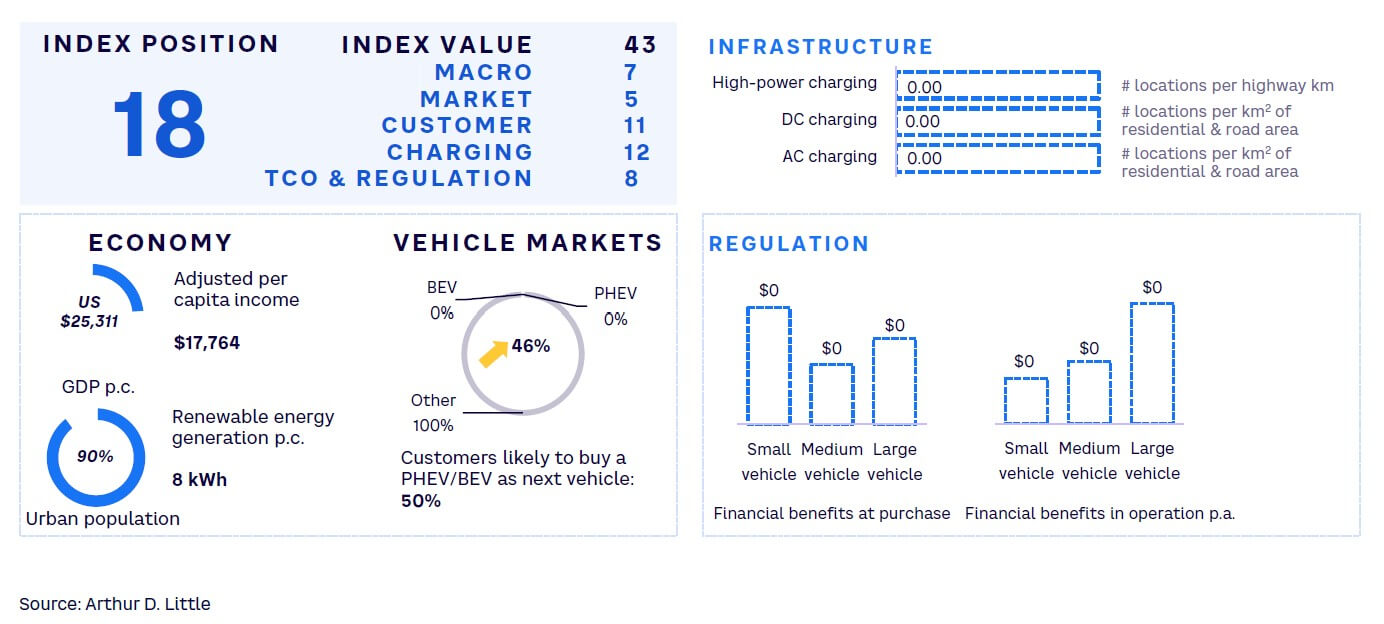
#19 Oman
Net-zero announcements and public charging infrastructure growth are likely to increase EV readiness, but country still has long way to go
As part of Oman Vision 2040, the government has set out plans for a sustainable future with a diversified economy; the adoption of EVs plays a crucial role in this goal. With more than 2 million vehicles on Oman’s roads, representing almost half of the country’s population, reducing carbon emissions from the transport sector is a top priority. The government has committed to achieving net-zero emissions by 2050 as part of its COP27 commitment, with plans to phase out fuel-operated vehicles and ensure that about 80% of vehicles in Oman are electric by 2035.
To support EV adoption, the government is prioritizing the development of infrastructure that enhances convenience for early adopters. For large industrial and commercial users, Oman has implemented time-of-use (TOU) charges, which are more appealing than default rates, if charging is done during off-peak hours. It also intends to dramatically upgrade its metering system. As a result, there is a chance that PEV-specific or more general off-peak rates will emerge in the medium term. In the meantime, with a high homeownership rate and subsidized electricity tariff regimes in place for residential customers, home charging is likely to be quite attractive compared with the running costs of an ICE vehicle.
Oman’s Bahwan Services and Trading (BST) and Saudi Arabia’s Ajlan & Brothers (Abilitii) have signed a collaboration agreement, aligning with Saudi Vision 2030 and Oman Vision 2040. The agreement encompasses projects in industrial manufacturing of lithium-ion batteries, renewable energy, healthcare, and food security.
Charging infrastructure development is critical to the success of the EV industry in Oman. Although facilities are still somewhat limited, new fuel stations on major highways are now required to include EV charging facilities. At the same time, free-of-charge facilities available at an increasing number of hotels and malls are further expected to accelerate Oman’s transition toward sustainable mobility.
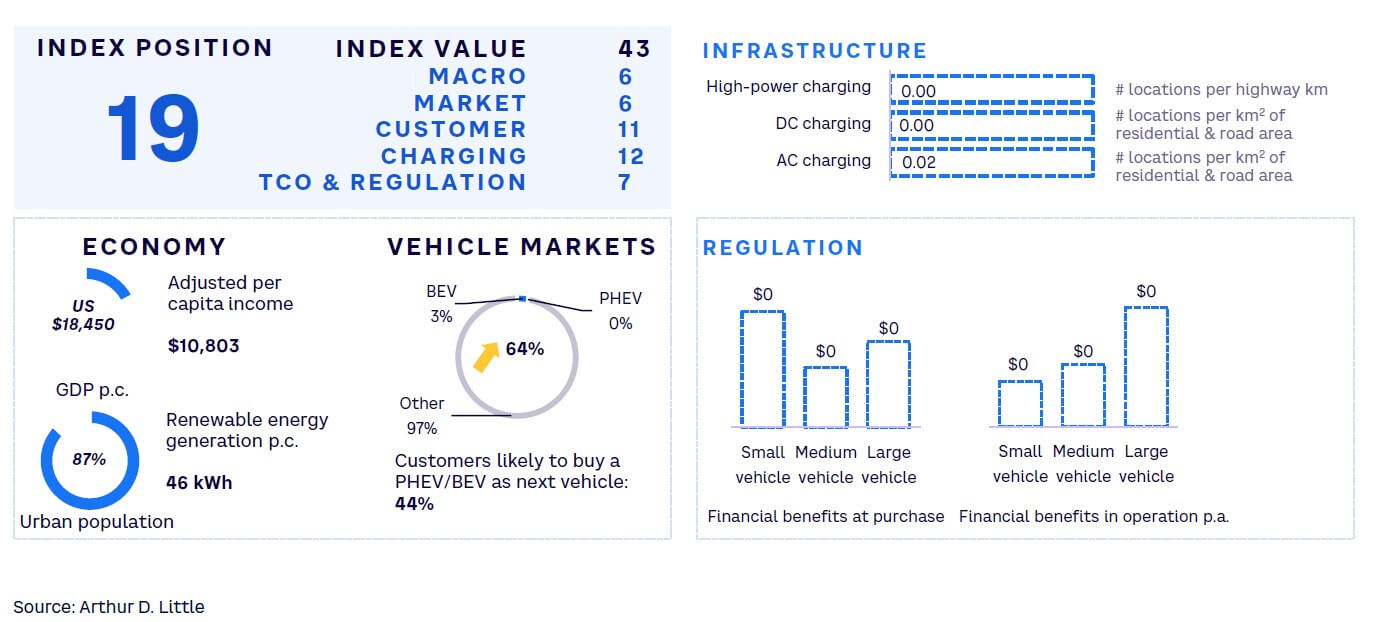
#20 Algeria
Strong participation from various stakeholders, including government and private players, acts as tailwind to accelerate EV market
Algeria, the largest nation in the African continent, is making remarkable progress in the EV market. The government has taken significant steps to create a supportive environment for its growth. It has provided a 20% import benefit on EVs over ICE vehicles, offering a solution to the cost issue for an import-based EV market.
To further promote growth in the sector, Algeria has set an ambitious target of installing 1,000 charging stations in 58 wilayas by 2024. Public energy company Sonelgaz, in partnership with Naftal, a subsidiary of Sonatrach, will install these charging stations. Additionally, the Centre for the Development of Renewable Energies (CDRE) initiative to design and manufacture Algeria’s first EV has further supported the enterprise. The unit production cost of this small EV with seating capacity of two is just under US $5,300, making it very feasible for EV growth in the nation.
Algerian President Abdelmadjid Tebboune’s statement to support EV imports in the country strengthens its commitment to promoting the sector’s growth. It will also help the North African nation to reduce pollution since the transport sector generates 20 million tons of CO2 annually. In 2015, the sun-rich country updated its Renewable Energy and Energy Efficiency Development Plan to 2030 to increase its production of renewable energy, which will benefit the charging infrastructure for EVs.
These government initiatives are spurring interest in the market among other stakeholders. In March 2023, Fiat’s owner, Stellantis, has included Algeria as a key contributor to its Dare Forward 2030 strategic plan. Stellantis’s ongoing project, the Tafraoui-Oran manufacturing facility, will facilitate the production of Algeria’s first hybrid vehicle, the Fiat 500 Hybrid.
However, Algeria’s next challenge lies in addressing range anxiety in the desert nation caused by high temperatures and an above-average commute length. The government must accelerate the installation of more charging stations to solve this problem. Nevertheless, with the government’s support, car manufacturers’ initiatives, and high customer readiness (approximately 80%), Algeria is poised to define the EV market in the MENA region.
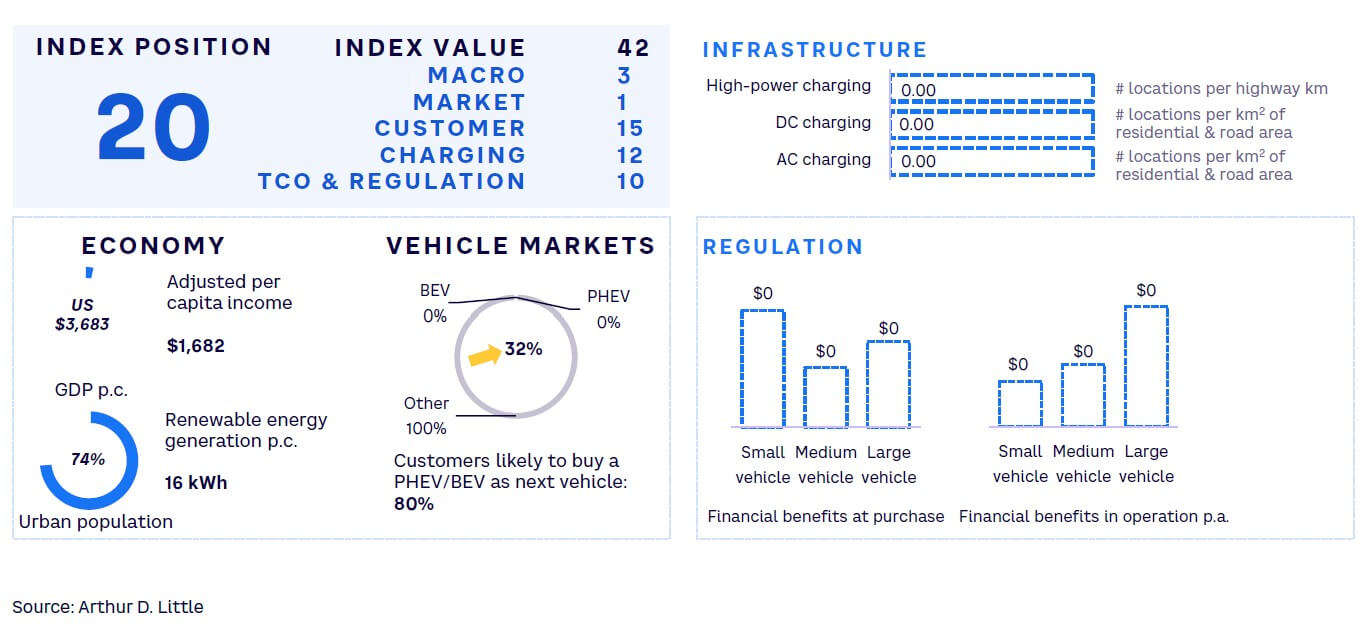
#21 Indonesia
Strategic advantage and incentives sparking EV push
The automotive industry is one of Indonesia’s most significant contributors of GHG emissions; at 27%, it is ranked as the second-largest emitter.
Around 10,000 electric cars were sold in Indonesia in 2022. As part of its EV roadmap, the country seeks to become a major EV market by 2030. Interestingly, the country holds one of the largest nickel reserves in the world, a key component of the lithium-ion battery cells driving the EV revolution. This gives the country a major strategic advantage in EV expansion, and Indonesia is planning to domestically produce 600,000 EVs per year.
To this end, the Indonesian government has introduced various incentives, such as the Positive Investment List (PIL), which promises a host of incentives for companies making investments in the EV space. Since 2013, the Indonesian government has been introducing incentives to support xEVs (BEVs, PHEVs, and HEVs) through its Low Carbon Emission Vehicle (LCEV) program and Presidential Regulation No. 55/2019, which aims to develop an end-to-end EV supply chain.
The government, as per Ministry of Industry Regulation No. 6/2022, has also set a national target of 600K battery electric four-wheelers (e4Ws) and 2.45 million e2Ws by 2030. EV incentives include ease of license procurement, coupled with lucrative tax incentives such as a 0% tariff on luxury vehicles that adhere to net-zero-emissions technology standards. The government has reduced the VAT on EVs to 1% from 11%, bringing the starting price of, for example, a Hyundai IONIQ 5 to under US $45,000 from over US $51,000. However, this price positioning is still not good enough for many prospective EV buyers in the country, with a per capita GDP of US $7,500. Mobilization is very low in international comparison; in many cases, the first step before adopting electric passenger cars would be e2Ws or e3Ws. Part of the issue comes from the high vehicle-import duty: completely built units (CBUs) face a 50% import duty, while completely knocked down (CKD) vehicles are still charged at 10% of the value.
Additionally, the country is witnessing aggressive urbanization and an increasing share of youth among its population. Hence, the environment is conducive to rapid expansion of EVs; still, there needs to be a consistent infusion of capital, time, and efforts. According to Coordinating Minister for Maritime Affairs and Investment Luhut Binsar Pandjaitan, Indonesia requires US $35 billion to build and scale its EV ecosystem.
Challenges around supporting infrastructure in Indonesia prevail; as of the end of 2022, only 439 charging units were built across 328 locations. Conversely, a promising 960 battery-swap stations for e2Ws had been set up.
Traditional fuel prices are low compared to other markets; thus, the economics of EVs still do not convince many to buy them. At the same time, given the strategic advantage around the country’s nickel reserves, government incentives, and interest from private investors, Indonesia is poised for strong growth in the EV sector. Toyota Indonesia, for instance, has announced a US $1.8 billion investment in EV assembly, while LG has committed US $9.8 billion toward EV battery cell manufacturing, allowing it to benefit greatly from PIL incentives.
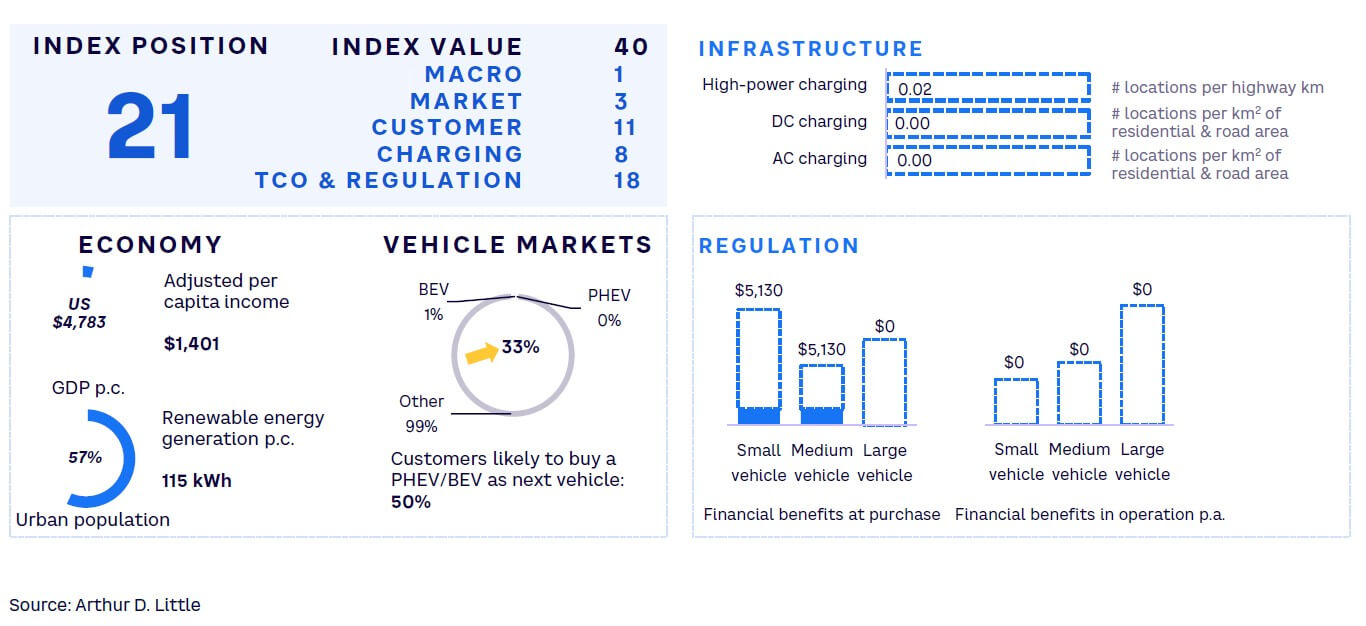
#22 Morocco
Potential to become EV manufacturing hub, with plans for gigafactory and investments in EV supply chain
The current EV fleet in Morocco accounts for only 0.2% of all passenger cars. Affordability concerns are one of the critical causes underpinning such a marginal market landscape. Fuel prices in the country have reached unprecedented highs due to the surge in global energy prices and supply chain disruptions caused by Russia’s invasion of Ukraine. These price increases have discouraged people from purchasing a vehicle due to rising operational costs. Besides affordability, the country’s charging infrastructure is weak.
Despite the current scenario, the EV sector in Morocco holds significant potential for growth and offers various benefits across different dimensions. Morocco is set to become a crucial hub for EV manufacturing, as several OEMs have announced investment plans. The government has revealed plans to construct a gigafactory, but further progress is yet to be communicated. This development is expected to provide a reliable local source of EV batteries, benefiting the country’s auto industry. The battery manufacturer likely will supply Renault and Stellantis, further solidifying Morocco’s key EV manufacturing hub position. Stellantis already has signed a deal to produce Opel’s Rocks-e EV in Kenitra.
Morocco is working toward developing a comprehensive EV supply chain, including battery-recycling and mining companies. The country has significant cobalt deposits, a key component of EV batteries, which could support its EV manufacturing capabilities. BMW has signed a €100 million supply contract with local miner Managem to source cobalt for its EV battery cells. These investments should further enhance Morocco’s appeal as an EV production hub.
Moreover, Morocco’s auto industry is anticipated to grow due to its popularity among auto parts and components manufacturers relocating from Ukraine due to the ongoing war. Japanese company Sumitomo Electric Industries announced its plan to relocate its wiring harness production from Ukraine to Morocco and Romania. This relocation should boost the automotive industry in Morocco and Romania, create new job opportunities, and increase exports.
Morocco’s Intersectorial Association for Electric Mobility (APIME) is leading the initiative to open 2,500 EV charging stations by 2026. The charging stations mainly will be located in major cities like Tangier, Rabat, and Casablanca. The move should incentivize more consumers to switch to EVs.
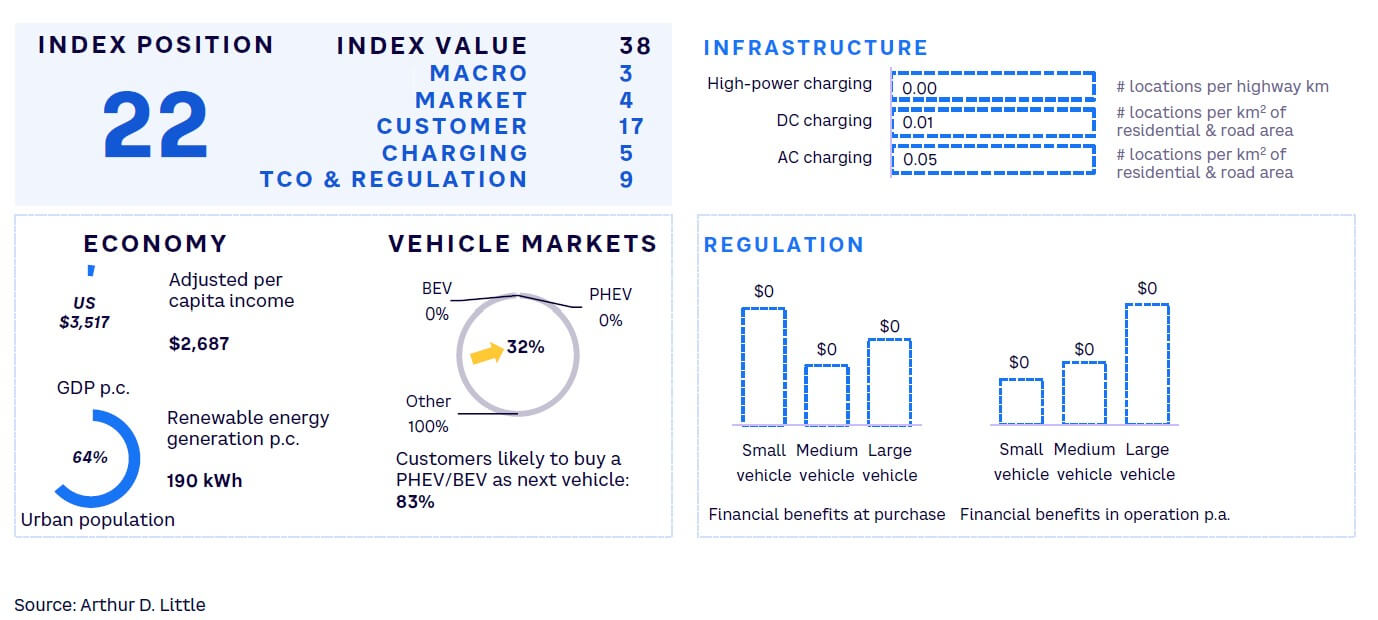
#23 Saudi Arabia
Via Saudi Vision 2030 and huge investments in infrastructure, EV industry set to grow exponentially
Saudi Arabia is one of the biggest automotive markets in the GCC region, with more than 50% of all new vehicle sales in the region. Continuing with its policy of revamping the overall economy under Saudi Vision 2030, the Kingdom of Saudi Arabia (KSA) introduced the Saudi Green Initiative in 2021 to promote green energy, emphasizing EVs. The initiative boasts a target of 30% of total vehicles in the capital being EVs by 2030.
With a vision to be a significant player in the global EV industry, in early November 2022, HRH Crown Prince Mohammed bin Salman announced the creation of CEER, the first Saudi automotive brand. It is a JV between PIF and Taiwanese manufacturer Foxconn to develop, build, and sell several BEVs in KSA by 2025. The company has a target to produce more than 150,000 EVs annually to be available in the Gulf countries. In addition to this, PIF also bought a majority stake (65%) in US-based EV brand Lucid. Under the agreement, Lucid plans to grow its market in the Middle East, establishing its first overseas manufacturing plant in the King Abdullah Economic City (KAEC) region of the nation. KSA has also agreed to purchase 100,000 vehicles from the group in the next decade. With these projections, KSA plans to build a 310,000 production capacity for EV by 2030.
Following in the footsteps of Norway, an oil-built economy, KSA also aims to provide a favorable environment for EV imports/manufacturers to establish their base, enabling public charging infrastructure and providing benefits for customers to reduce TCO. KSA has signed agreements with various companies to develop EV public charging infrastructure in the country, a few key players being Electromin and ABB. Electromin already has installed 100 charging stations in the country and plans to grow exponentially with the government’s support. It also provides free-of-cost charging at various charging stations to incentivize consumers to buy EVs.
KSA’s geographical advantage allows it to be at the center of sourcing (mining/importing) rare minerals required for battery production in the region. In line with this, KSA has announced US $6 billion for steel mining and EV battery production projects, including building an EV metals plant to attract future investment. According to Industry and Mineral Resources Minister Bandar Al-Khorayef, “The investments will continue to position the Kingdom as a mining production and logistics hub for a region stretching from Africa to Asia, while supporting the transformation of our mining sector so it can achieve its potential.”[4]
Saudi Arabia is looking into economically efficient ways to extract and process lithium from seawater desalination and the brine that accompanies oil. Doing so would allow it to source lithium for EV battery production within its own borders, vastly reducing production costs and transnational supply chain vulnerability.
Overall, Saudi Arabia’s concerted efforts to promote EV adoption and build a solid domestic EV industry hold tremendous potential for the country’s economy and the global transition toward a more sustainable future.
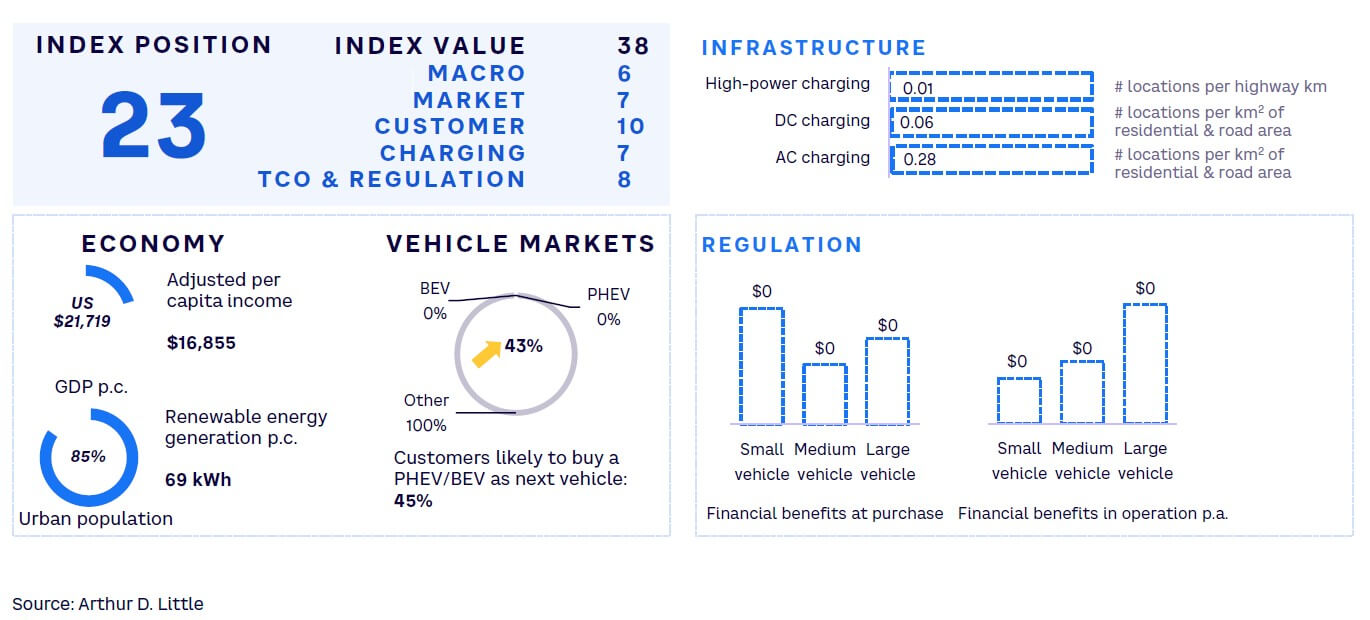
#24 Malaysia
An emerging EV market with ambitious targets
Electric mobility in Malaysia is still in its early stages of development, relatively small but growing quickly. Due to only starting the electrification of the market, the government cannot yet set a target year for banning sales of new ICE vehicles.
The government has set a target of having 100,000 EVs on the road by 2030, but as of the end of 2022, there were only around 10,000 EVs registered in the country, according to the Road Transport Department of Malaysia. Including different types of hybrids, the number of EVs already reaches more than 100,000. Only a limited range of less than 40 different EVs (BEVs and PHEVs) were available in the market in 2022.
The lack of charging infrastructure and high prices of EVs are some of the main barriers to adoption in Malaysia. The country’s per capita GDP is only US $11,000. In March 2022, the government reiterated its aim for installing 10,000 public charging stations by 2025 — the current number is approximately 1,000 AC and 200 DC fast chargers, which leaves a large number to reach the target.
The Malaysian government has implemented and lately extended several incentives to encourage the adoption of EVs in the country:
-
Tax exemptions. EVs are exempt from import and excise duties. This makes EVs more affordable for Malaysians.
-
Road tax exemptions. EVs are also exempt from road tax.
-
Charging infrastructure. The government has allocated funds to install more charging stations across the country to support the growth of EVs.
-
Green investment tax allowance. Companies that invest in EV-related activities, such as manufacturing, R&D, and charging infrastructure, are eligible for a tax allowance of up to 100%.
-
Purchase rebates. The government has introduced a rebate of up to RM 20,000 for the purchase of EVs.
These incentives are part of the government’s efforts to reduce carbon emissions and promote sustainable transportation in Malaysia. There are also several initiatives by private companies to promote EVs, such as ride-hailing services using EVs and the introduction of electric buses in some cities. Overall, while there is still a long way to go, there are positive signs of progress toward electric mobility in Malaysia.
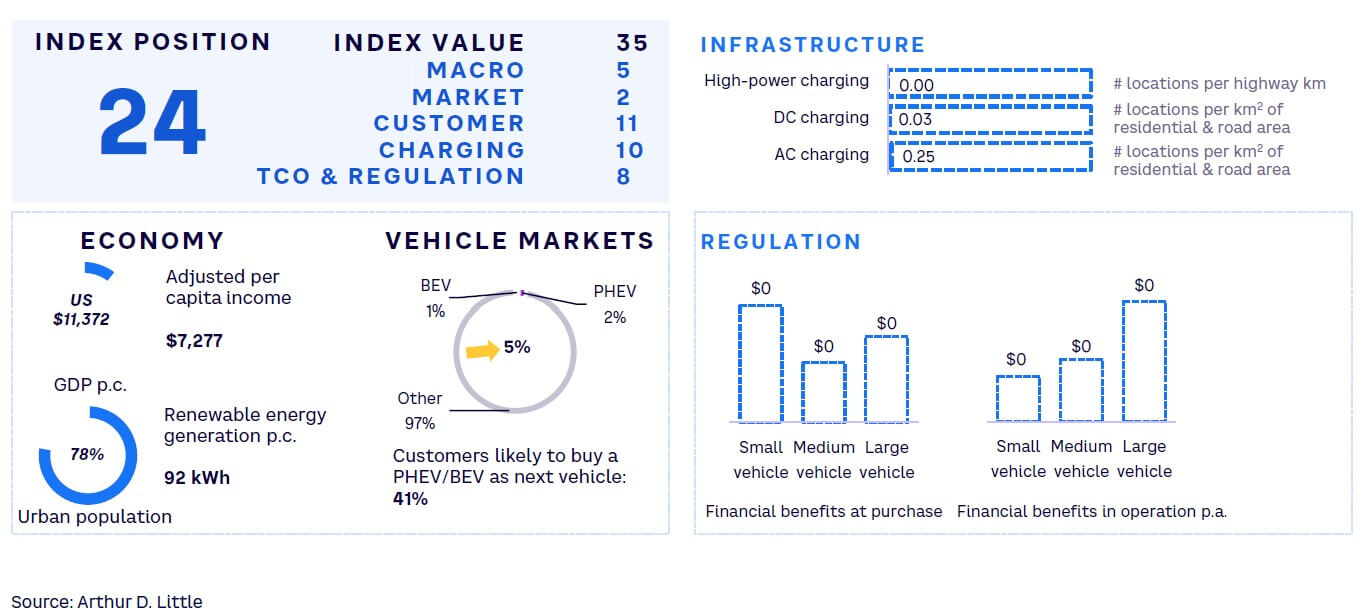
#25 Türkiye
A strong automotive industry drives EV market growth, but lack of clear policies and targets may hinder full potential
Over the past decade, Türkiye has taken significant strides toward becoming a major player in the EV market, with a growing number of consumers and businesses embracing the technology. Around 49% of Turkish consumers say they will consider an EV for their next vehicle.
Türkiye’s strategic location and history in the car industry, skilled labor force, strong government support, and growing domestic market make it attractive for automotive companies. Türkiye has become an important production center for cars sold in Europe. For example, Ford, LG Energy Solution, and Koç Holding plan to build one of Europe’s biggest EV battery factories in Türkiye. The factory is set to break ground in late 2023 and expected to start production in 2026. The JV aims to achieve a minimum of 25 GWh of annual production capacity, potentially expanding to 45 GWh.
While the country’s consumers prefer imported cars, 70%-80% of the 1.5 million vehicles produced annually are shipped overseas, mainly to Europe. The country is following Europe’s carbon-free initiatives in the hope of becoming an EV manufacturing hub and, along the way, boosting its industrial competitiveness. The most important development for the Türkiye automotive industry in 2023 will be the introduction of the homemade EV TOGG to the local market. Including new models to be introduced by other carmakers, EV sales in Türkiye are expected to reach 40,000 units in 2023, which means the share of EVs in total vehicle sales will climb to 7%.
Türkiye is also keeping pace with the expected rise in sales by continuously adding to the EV charging infrastructure. However, as of now, Türkiye has no medium- or long-term policy to transform the EV market. No target has been announced for EV uptake or the deployment of EV charging infrastructure, and no limitations have been placed on the use or sale of ICE vehicles. Thus, the extent to which EV charging stations ultimately will be promoted and regulated through official policy remains unclear. However, the outcome will likely be suboptimal without decisive action.
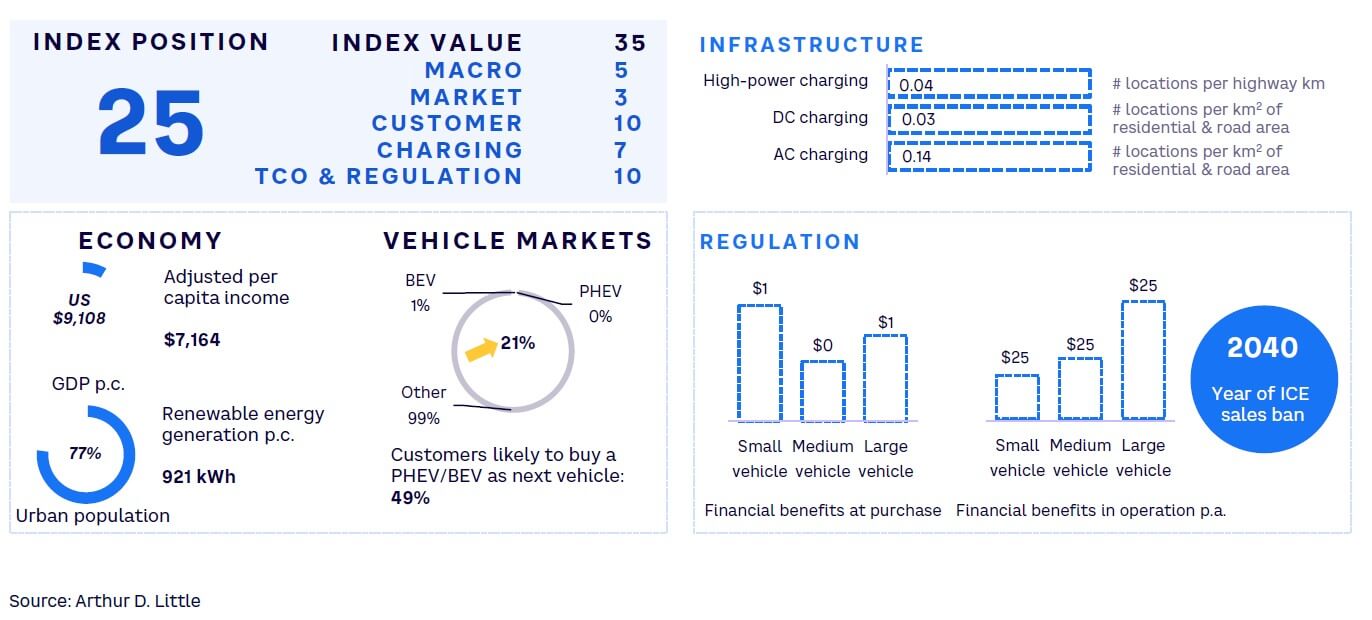
#26 Vietnam
Strong automotive foundation spurs shift toward EVs
Vietnam is one of the dynamically growing economies in SEA, with a GDP CAGR of more than 6%, and clean transportation ranks high on the government’s agenda. The official aim of the government is to shift 10% of all new vehicle sales in Vietnam to electric by 2023.
Along with environmental concerns, a key driver of Vietnam’s EV push is likely to be its massive young, Internet-savvy population. About a third of Vietnam’s consumers report they are likely to purchase an EV. However, much remains to be done to leverage this potential. The motorized vehicle market is largely dominated by 2Ws, and the EV uptake has so far primarily happened in this area: Vietnam is the second largest market worldwide for electric 2Ws. Car ownership, on the other hand, is quite low, at 25 vehicles per 1,000 inhabitants. A growing middle class is about to change this situation, striving for passenger cars and potentially SEA to host an EV manufacturing company. However, the EV sector has since grown sluggishly. Traditionally, Vietnam has not been very strong in manufacturing. For instance, engine components are designed and manufactured overseas and shipped to Vietnam. There is, however, growing interest among private players in the country; VinFast, Kia, Mercedes-Benz, and Toyota are all placing bets on the Vietnam EV market.
Realizing the need to play an active role in EV expansion, the Vietnam government has exempted electric cars from registration fees for three years and reduced the excise tax on BEVs (of nine seats or fewer) to 3%, starting in March 2022.
However, to further enable electrification, the government’s focus could shift to leveraging the interest of private players through policies centered around friendly taxes and ease of production, as in many other markets. Given that there are no concrete policy measures to boost manufacturing of EVs in Vietnam at present, apart from lower excise tax, the road to electrification remains challenging.
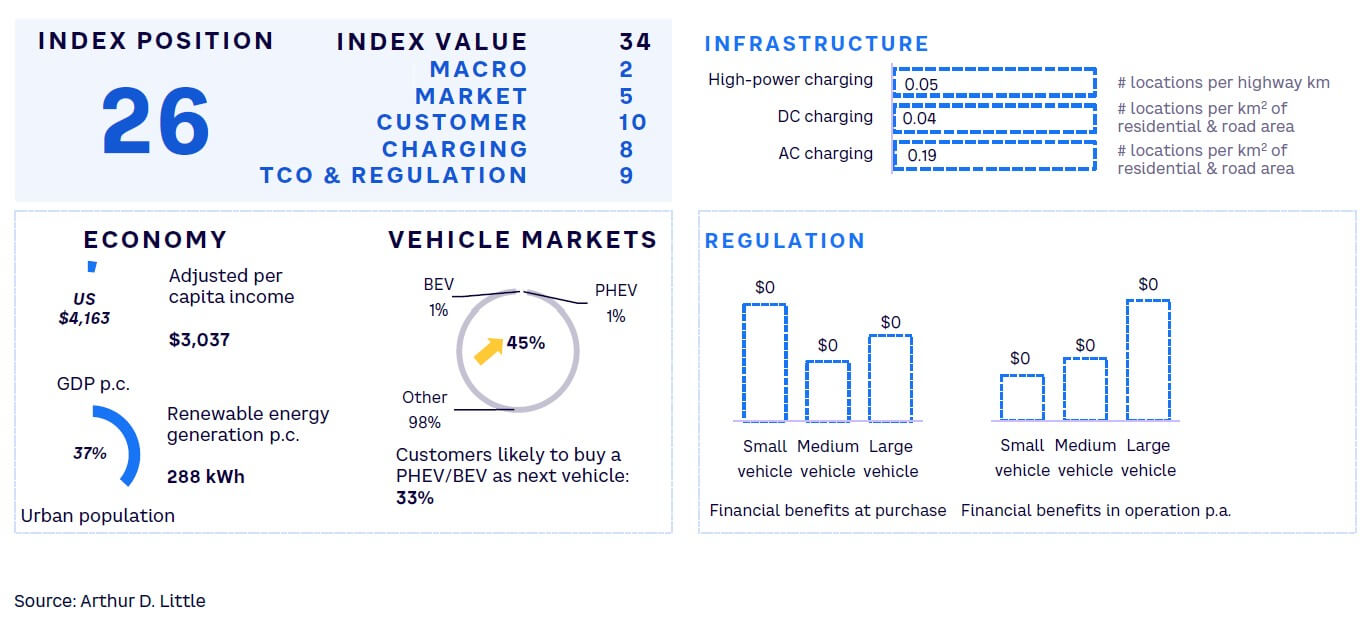
#27 Mexico
Urgent need to tackle rising pollution propels EV push
Among the most populous countries in the world, Mexico is riddled with high travel times and air pollution. While the solution to both problems lies in electric mobility, only 5% of consumers would prefer an EV in the years to come. Government incentives and private investments are required for a strong push toward electrification of the Mexican fleet.
Understanding the criticality of its role, the Mexican government has developed a roadmap for electric mobility. Municipal tax exemptions and pollution control inspections are incentivizing locals. Further, gasoline prices are on the rise, which has further bolstered sales of electric and hybrid vehicles. Private automotive players like BMW and Nissan are making inroads in the country as well.
However, a lack of large-scale government support and limited charging infrastructure are key concerns. According to industry reports, only 1,200 public charging points were available in Mexico at the end of 2022, most concentrated in urban areas. However, the charging network in Mexico is currently growing by 40% annually. Together with increasing government incentives for EVs, this will raise the readiness of the market.
EV owners are exempt from payment of tenure and verification for the first eight years. The average car price in Mexico is around US $22,000, limiting the range of EVs affordable for the average car buyer. Only a small range of 24 full EVs are available on the market. EVs on the market include Nissan Leaf; Renault Twizy; BMW i3; Tesla S, X, and M3; Chevrolet Bolt; and Zacua M2.
Notably, Mexico City is part of the Zero Emission Bus Rapid-deployment Accelerator (ZEBRA) initiative, focused on net-zero-emissions public transport in mainstream cities across Latin America. While infrastructure is a challenge, there is a clear understanding of the need for EVs in Mexico.
The future is encouraging, with General Motors announcing plans to infuse more than US $1 billion in its Mexico plant to build only EVs there from 2024 onwards. This investment also envisages capacity for battery packs, electric motors, and other components, and is the first of its kind in Mexico.
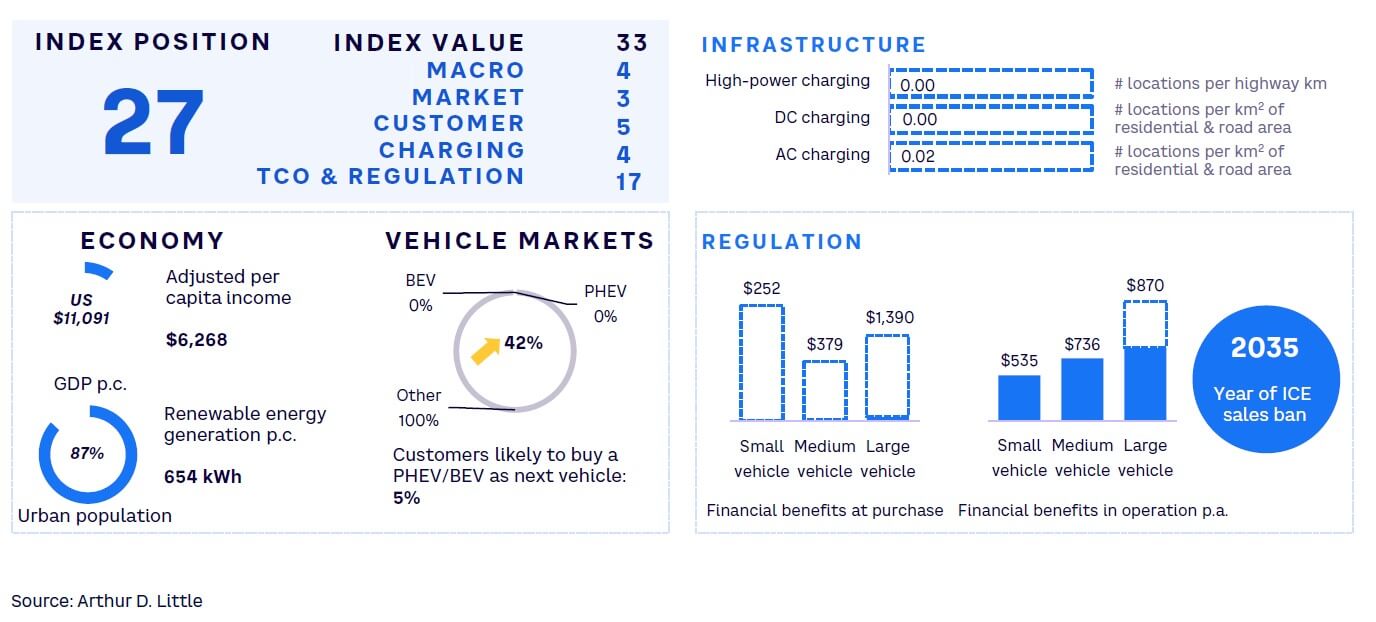
#28 Egypt
Ban on ICE vehicles by 2040 highlights positive outlook for e-mobility
Egypt’s EV industry is in the nascent stage, with a limited number of EVs on the streets. It has one of the lowest GDPs per capita in the MENA region, with a large proportion of low-income households. This is a contributing factor responsible for laggard EV adoption. Moreover, the absence of an adequate charging infrastructure exacerbates the difficulties by limiting the use of EVs in the country.
Despite the relatively low presence of EVs, the government has been expressing strong ambitions to push for the promotion of EVs. A key reason for this ambition is the government’s commitment to achieving its sustainable development goals, which are elaborated on in Egypt Vision 2030. The vision calls for a 10% reduction in GHG from the energy sector, including oil and gas, by 2030, relative to 2016 levels. In line with this initiative, the government has announced a ban on ICE vehicles by 2040.
Several steps have been taken since 2019 to boost the expansion of the EV industry. The country’s Ministry of Public Business Sector and Dongfeng Motor signed a memorandum of understanding (MOU) to produce EVs in the country. The assembly facility, which will be in El Nasr’s factories, will have an initial capacity of 25,000 units. Moreover, the Arab Organisation for Industrialisation, a military organization, presented the nation’s first electric bus route, contributing to the increased popularity of EVs in Egypt. In addition, the introduction of more affordable passenger EVs by manufacturers like MG, as well as the government’s plan to roll out public charging infrastructure, aligns well with the push for EVs.
The EV industry in Egypt has been facing challenges due to the country’s current foreign currency crunch. New cars are offered only in US dollars. This poses a problem for many potential customers who may need access to foreign currency or want to avoid incurring additional fees associated with currency exchange. Still, Egypt is all set to manufacture the first Egyptian EV. Prime Minister Mostafa Madbouly even conducted a follow-up to track the plan’s progress. Given the positive outlook and its initiatives, Egypt will likely become an important market for EVs.
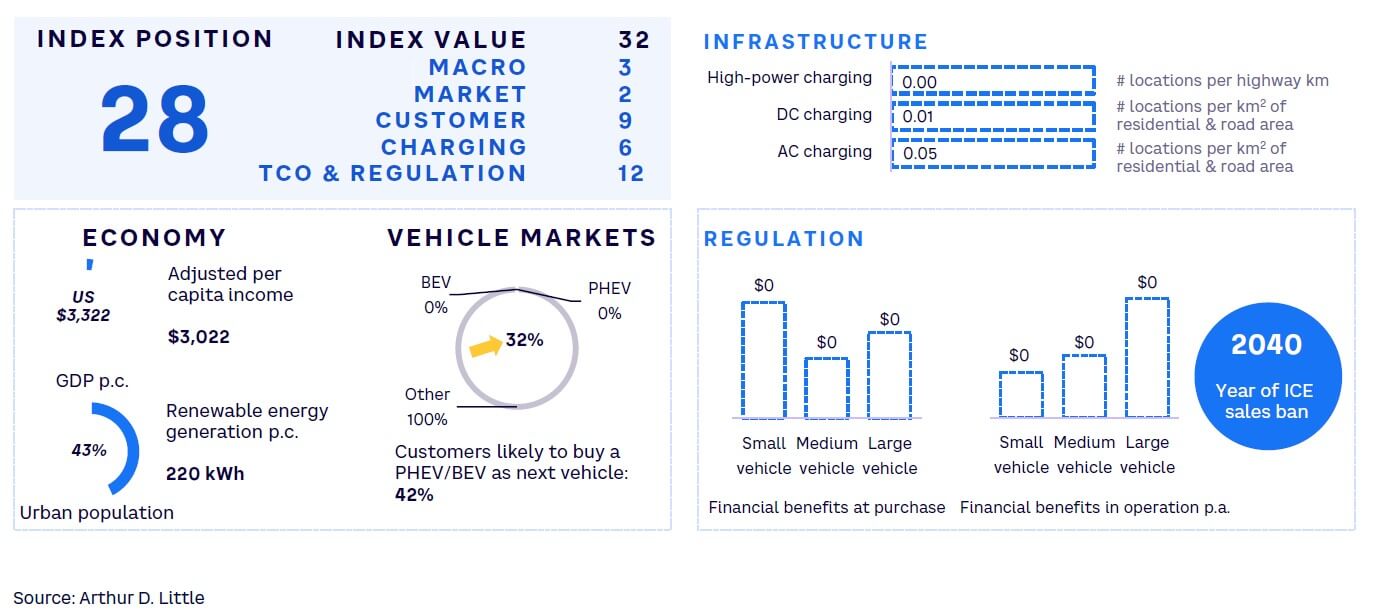
#29 Lebanon
Ambitious target to revamp electric infrastructure gives EVs huge potential
Lebanon is still working to establish the EV sector in the shaken economy. The country already has some presence of EVs on the road. The fact that the nation’s limited public charging infrastructure is currently dominated by luxury car manufacturer Porsche shows that much needs to be done to make EV a more widespread species. To power its new electric cars, EV Electra plans to set up around 100 recharging stations across the country.
Support for EV uptake comes from a stabilizing new car market in 2022 (23,600 units), which was further increasing by 15% year-on-year in the first half of 2023. The market has the presence of various car companies, including Toyota, Nissan, and Renault. These market leaders’ consistent growth paints a favorable picture for EVs in the nation, as they transition to electric mobility worldwide. The e-motor show conducted in the country showcased various e-models from different leading car manufacturers, signifying their active interest in the country.
Despite Lebanon’s EV market being nascent, it is attractive because the government has reduced support for fuel prices, making these some of the highest in the region, complemented by some of the lowest electricity unit costs. The government also supported this growth by providing reduced customs duty of 20% on HEVs and complete exemption on fully electric models. These incentives and prospective growth have led to Lebanon’s first locally built automobile, Quds Rise, priced at just US $30,000, by EV Electra.
Though it presents great potential, Lebanon needs to address the challenges of a weak economic scenario and its overdependence on fossil fuels for power generation. It has an ambitious target of 30% of its energy consumption being from renewables by 2030, but a major revamp is still required to keep pace. This also requires the power sector to undergo a major reform, as it is one of the biggest contributors to the country’s GHG emissions. Overall, Lebanon’s EV sector growth will depend significantly on the government to provide incentives on the purchasing and operation of EVs, which will work with fuel and electricity prices toward the same goal.
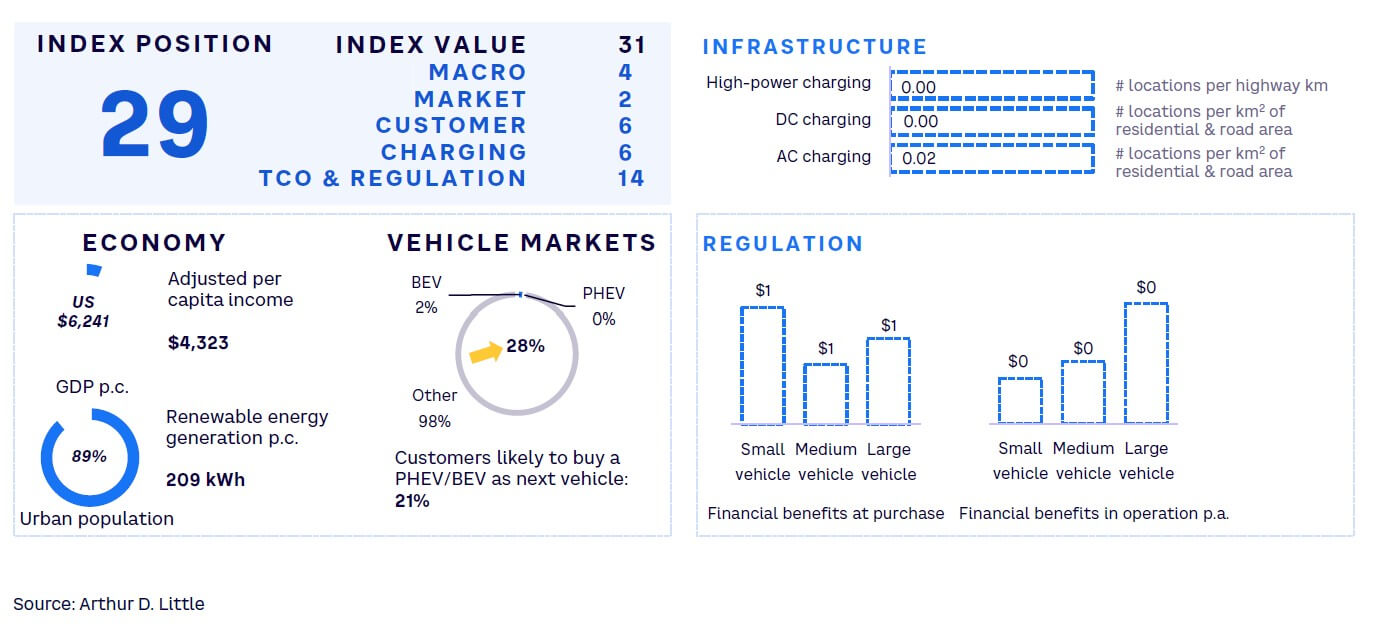
#30 Brazil
Rising prices of fuel and ICE vehicles are not yet enough to spark EV market
A developing economy that has seen one of the lowest GDP per capita growth rates during the pandemic (-5%) and much change in political direction, Brazil is still trying to find the right path to cleaner transport in line with economic development. It is still far behind other nations in EV adoption, even though fuel prices surged rapidly in 2021. Despite strong price fluctuations, the government has not yet set clear roadmaps or targets for EV adoption.
The country has a good starting position for EVs, with a high share of renewables in electricity generation (92% in 2022). Conversely, the key reason for the government’s inability to shift its focus to EVs is the country’s success in reducing its carbon footprint using biofuels. Brazil is planning to explore more opportunities for sustainable vehicles using biofuels. Apart from this, the nation cannot shift abruptly to BEVs, as current consumers are unable to afford them and government and OEM investment in recharging infrastructure is uncertain. Yet, awareness of emissions problems from ICE vehicles has been growing among consumers. However, limited spending power and sparse charging infrastructure have hamstrung adoption of EVs.
According to the Brazilian Electric Vehicle Association (Associação Brasileira do Veículo Elétrico, ABVE), the market share of electric cars rose to 2.5% in 2022, with 126,500 vehicles on the road and more than 50,000 new EVs sold during the year. The slow uptake is mainly due to comparably high acquisition costs and lack of infrastructure, as the vehicles depend on supply networks and specialized chains for maintenance. A lack of regulation and national consensus on the role of EVs has been notorious in the nation, so there is no dedicated charging infrastructure in place. In addition, few OEMs are willing to tackle the high investments and risks of new infrastructure required for adapting manufacturing plants to BEV-native architecture.
That said, recent government measures in terms of financial benefits have sparked hope for growth of EVs, with 68% of consumers reporting that their next vehicle is likely to be electric. Brazil’s biofuel ecosystem for vehicles will determine the path for electromobility in the long term, and the nation must expedite its policies to compete with similar and developed economies across the world.
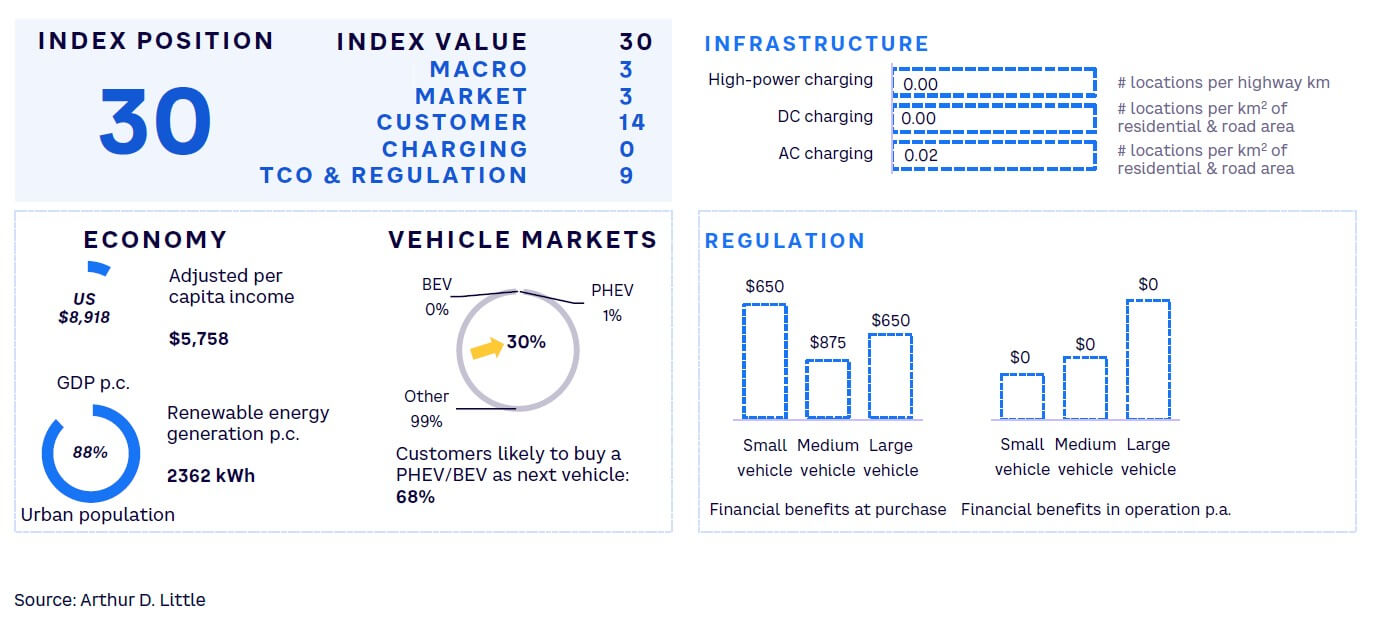
#31 Panama
EV market really only starting — at very low levels
In 2022, sales share of EVs were reported at below 1% of total sales — for PHEVs and BEVs combined, which makes EVs still a very rare species on Panama’s roads. In general, there are neither financial incentives nor a consumer appetite. Additionally, there is barely any public charging infrastructure — only around 10 public charging stations are currently listed for Panama City.
The number of EVs available on the market is still very limited: BMW and BYD are among the OEMs offering EVs, but only a total of 17 different BEVs were available to Panama’s customers in 2022. However, similar to many other markets, Panama wants to reduce its dependency on fossil fuels and lower GHG emissions, improving the overall sustainability of its energy infrastructure and moving toward the objective of energy independence by 2050.
The share of renewable electricity generation reached more than 70% in Panama in 2021, with a majority coming from hydropower. Plan Energético calls for increasing the share to 70% of total energy consumption (including other forms of primary energy) by 2050. This would require substantial changes to energy use in the transport sector, namely a strong shift to EVs.
With a focus on the transportation sector’s emissions, which account for a significant portion of GHG emissions, the government has set out a path in Plan Energético to achieve this goal: the president approved a law promoting EVs as part of a larger initiative to cut GHG emissions, encourage the use of renewable energy sources, and advance sustainability. However, so far, no year to ban ICE vehicles has been announced.
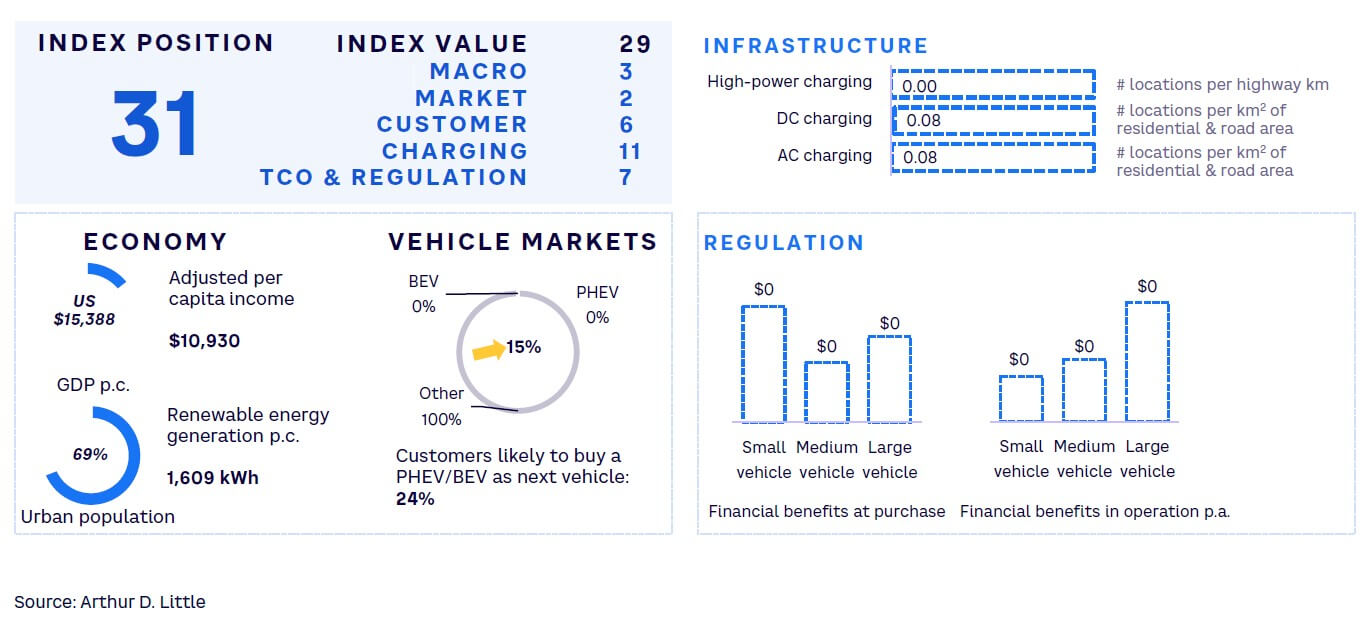
#32 Costa Rica
Abundant renewable energy for use in quickly growing population of EVs
Costa Rica is among the world champions in renewable electricity generation, with nearly 100% of energy output in 2020 from renewables (72% hydroelectric and 15% geothermal, with less than 1% solar). This would make electrification of the transport sector very beneficial in terms of sustainability and climate protection. Transport growth has recently increased the demand for oil and fossil fuels in the country. Costa Rica has to import a substantial portion of its petroleum products, and the country relies on imported crude oil and refined petroleum. Thus, diversifying its energy sources and reducing dependence on fossil fuels are long-term goals.
In addition, Costa Rica reached the highest reported EV sales share in the Americas in 2022, with 7.3& of all cars sold being BEVs, outperforming Canada and the US. However, electric mobility and EV readiness have still not reached much more than a starting level. Setting the market share in perspective, only 2,680 EVs were sold in the country in 2022. The overall passenger car market is tiny on a global scale, with only around 30,000 vehicles sold per annum. The number of EVs available in the market is currently limited to 20 BEVs and eight PHEVs. At the end of 2022, around 5,300 EVs (cars and LCVs) had been registered in Costa Rica, leading to a fleet share of only 0.5%, and there are around 270 public charging locations across the country.
Awareness among consumers of EVs is low, as only 24% state that their next vehicle may be an EV. Availability of home charging is only average, although homeownership rates are high at 70%. For a country like Costa Rica, with a per capita GDP of US $13,300 and a motorization rate of only 240 cars per 1,000 inhabitants, affordability of EVs is key. The government is now providing tax benefits for EVs (BEVs only), which will raise its GEMRIX position and overall EV readiness of the market over the coming years.
Under this new plan, fully EVs costing less than US $30,000 are exempt from taxes. Vehicles costing between US $30,001 and US $45,000 pay only half of sales tax and 75% of selective consumption tax. Vehicles valued between US $45,001 and US $60,000 pay sales tax and only half of selective consumption tax. Vehicles valued at US $60,001 and more pay full taxes.
The new bill also provides tax incentives to companies that replace their gasoline vehicles with EVs. Costa Rica’s public institutions can replace their vehicle fleets with “100% electric” vehicles. Also, the country’s bus fleets will be replaced with electric buses.
EVs (not PHEVs) will continue to be exempt from any import duties. An additional incentives package was added in 2018, including elimination of license plate driving restrictions, waiving payment for yearly road permits, and free parking in designated areas.
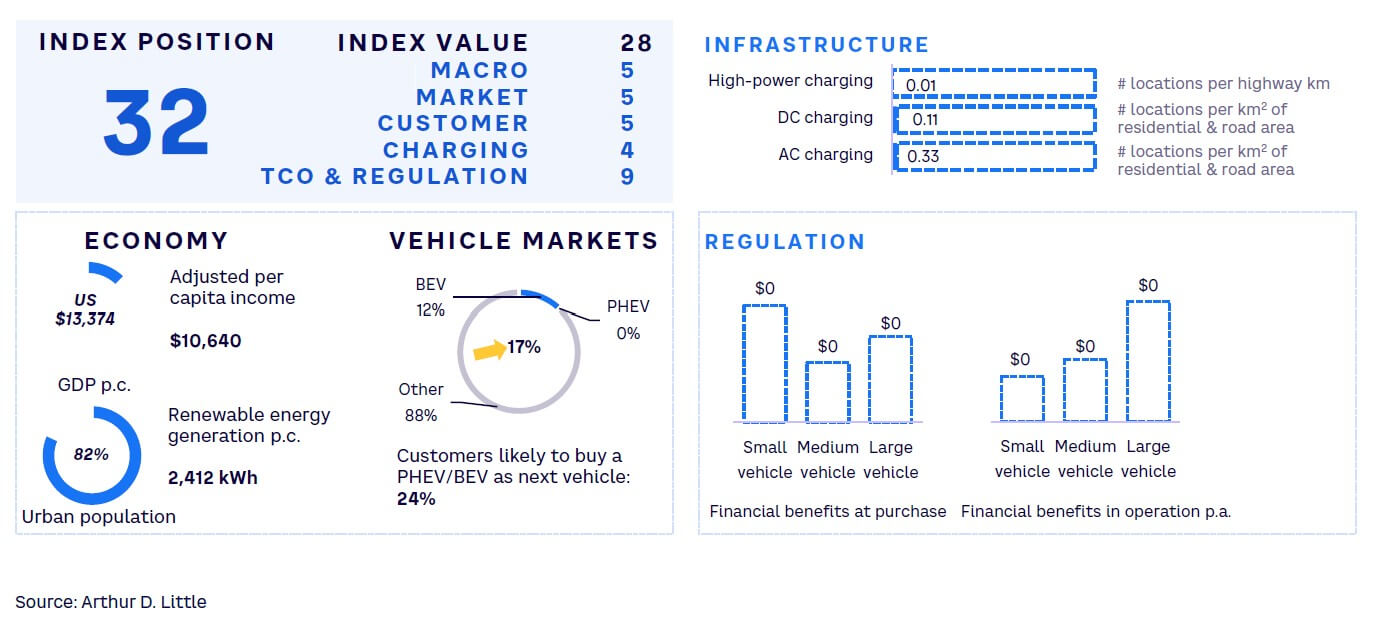
#33 Iraq
Government reducing support for fuel prices, coupled with increasing oil prices, may kick-start EV uptake
Iraq is at a nascent stage in the EV market, as evidenced by its low ranking in GEMRIX and related indicators. However, with a thriving automotive industry projected to cross a market size of US $1 billion by 2023 (CAGR of 27.6%) despite a COVID-induced slowdown, Iraq has become a lucrative market for global players and leaders to invest in during the early stages. This is exemplified by the entry of premium car brand EXEED into the country’s automotive market and launch of the nation’s first EV, Jaguar I-PACE.
Jaguar’s and Land Rover’s presence in the country is a game changer, as it is set to define the EV market. Right now, Jaguar I-PACE can only be imported. Jaguar is also planning to install charging stations to kick-start the development of a strong EV-enabling infrastructure.
To further facilitate ease of doing business for international players, Iraq is proactively taking steps to create a stable and robust environment for growth. In a recent interview, Iraq Oil Minister Ihsan Abdul Jabbar emphasized the current geopolitical tension in the region and world, highlighting that disruption in the oil market will inevitably force the country’s transition to EVs sooner than later.[5] The statement signifies the change in the government’s outlook, as it seeks to diversify its portfolio and reduce its overreliance on oil.
In a commendable shift toward a cleaner future, Iraq has committed to reducing pollution by 15% as part of a global initiative to address climate change. To further support its commitment, Iraq has withdrawn a significant portion of financial support for fuel prices, making the TCO of ICE vehicles more comparable to that of EVs. Iraq has also mandated a ban on new ICE registrations until old registrations expire, further reducing support for ICE vehicles.
At present, Iraq only has 0.01% of hybrids and EVs in the market. This low number is supported by a survey gauging Iraqis’ views on EVs and the challenges associated with their adoption. The survey shows that only 38% of people are willing to buy an EV as their next vehicle, whereas most are either unaware of them or unwilling to buy them because of a nonexistent charging infrastructure or high TCO for EVs. To tackle this, a multi-stakeholder approach via supportive policies and incentives will be needed to solve the chicken-and-egg problem of whether to build charging infrastructure or increase the number of EVs first.
The future of EVs in Iraq strongly lies in the government’s support for the sector. Given its commitment to a cleaner future, Iraq, in complement with its geopolitical advantage, holds tremendous potential to drive the change in the EV market.
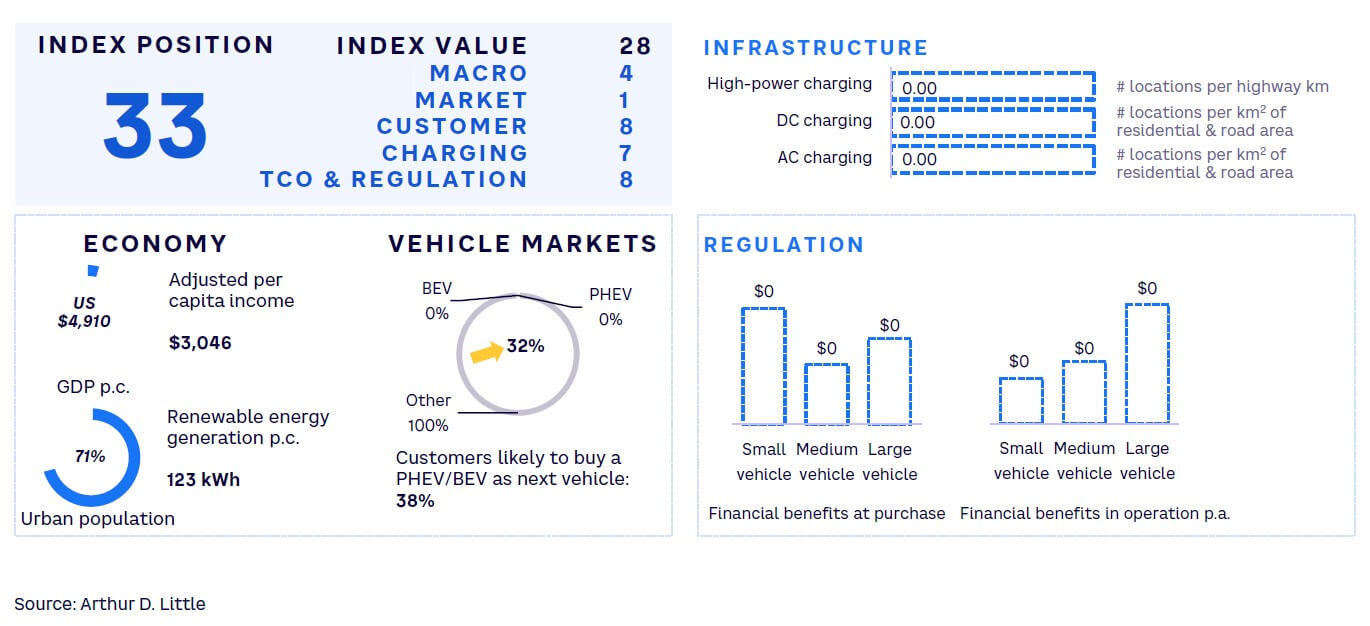
#34 Philippines
Course for EV adoption is set by governmental plans, while EV fleet is still tiny
The total EV fleet, including hybrids, in the Philippines was estimated at 14,000 vehicles in 2022, making it the third-largest EV population in SEA (after Thailand and Indonesia). Pure EVs have only been a fraction of it (probably around 9,000 vehicles). Only 426 pure EVs were sold in the entirety of 2022 in a total car market of 350,000 new vehicles, showing that electric mobility is only just beginning. However, the growth rates are enormous. More and more OEMs are bringing their vehicles to the market to serve growing customer demand. In 2022, 40 different BEV and PHEV model lines were available.
Decarbonizing the transport sector, which is a major contributor to GHG emissions, is part of the country’s climate commitments and objective to reduce dependence on fossil-fueled imports. Road transportation is estimated to account for 80% of the sector’s emissions. The Philippines also wants to increase its renewable energy generation, currently ranking only second in SEA in combined solar and wind power generation, with 1,766 MW of installed capacity, after Vietnam. Philippine power companies consumed coal for nearly 60 % of their electricity generation in 2022 and have increased coal-fired power emissions by more than 40% since 2017. This trend would need to be stopped to make EVs a truly sustainable alternative to those with combustion engines.
Key issues for customers remain the affordability of the vehicles (Philippines GDP per capita was US $3,500 in 2022), the charging opportunities at home and in public, and the absence of strong financial incentives.
The government issued an EV roadmap in 2023 and removed tariffs on CBU EVs for five years from 2023 onwards. Aside from tax incentives, EV owners will benefit from priority registration, discounts on fees and license plates, and an exemption from traffic volume reduction schemes.
For example, the Department of Transportation (DOTr) is implementing the Public Utility Vehicle Modernization Program, which calls for phasing out jeeps converted to public transport that are over 15 years old to be replaced with environmentally friendly alternatives (either Euro 4-compliant vehicles or EVs).
There are close to 180,000 jeepneys operating throughout the country that need to be modernized, and the EV industry is aiming to fill in 10% of this potential demand. Smaller-scale programs at local government and businesses levels (resorts and the like) have been implemented for the adoption of EVs. The government is also starting to purchase EVs as part of its fleet.
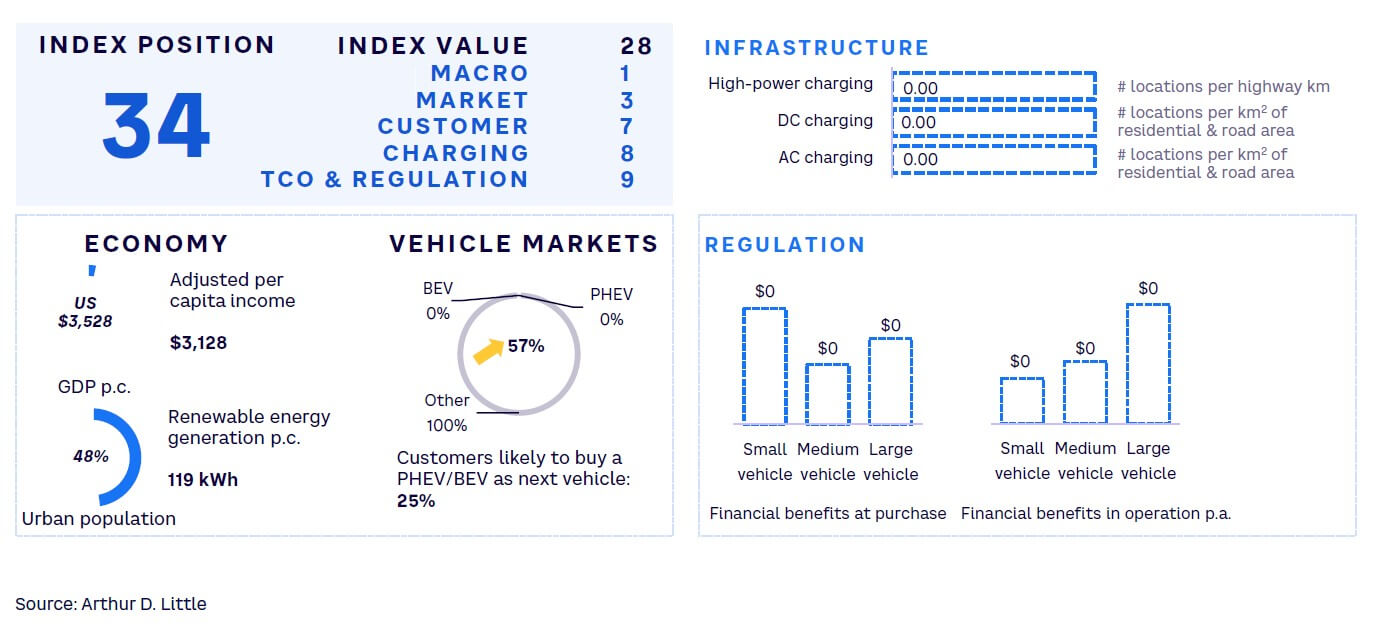
#35 South Africa
Nonexistent EV market likely to grow slowly in coming years
South Africa’s EV market is still almost nonexistent, with only 1,500 electric cars on the road and EV sales making up only 0.16% of all new vehicle sales in 2022. Only 500 EVs were sold throughout 2022. However, the market is expected to grow in the next decade due to multiple government initiatives to reduce carbon emissions and combat global warming by catalyzing the EV sector.
Such low EV penetration is largely due to the government’s limited focus, shrinking GDP per capita, and high up-front costs of EVs, coupled with a poor electricity supply. The ongoing challenge to maintain a constant power supply caused by below-potential electricity generation makes consumers wary of purchasing BEVs. However, there is an opportunity for increased sales of hybrid vehicles, as they can be powered by gasoline or diesel when not using the electric motor. Further, import duties and taxes account for 45% of the cost of imported EVs, which is significantly higher than that for conventional fuel vehicles. New imported vehicles are unaffordable for a large share of the population, and there is currently no domestic EV production.
Currently, South Africa has around 300 charging stations, with approximately one charging station for every five EVs in the country, giving it one of the highest station-to-EV ratios in the world. However, lack of local purchase incentives, combined with continued import duties, will limit the uptake of EVs in the country, as well as the potential for local production due to lack of a market to offer EV producers support.
To reduce the risk of electricity deficits, the government has amended Schedule 2 of the Electricity Regulation Act (ERA), lifting the license-exemption cap for generators to 100 MW. This is expected to bring in investments in the power sector and could benefit the demand for EVs as the supply of electricity stabilizes.
In March 2021, the UK government selected 10 projects in South Africa to receive ZAR 64 million in funding to help decarbonize Johannesburg and Nelson Mandela Bay, which could boost development of the EV infrastructure . Companies like Audi, Mercedes, Nissan, and Opel are also launching full EV models in the country. This will attract investment in charging stations, which, in turn, will help attract the next tier of buyers.
Overall, EV adoption will be quite slow in South Africa, as natural gas-powered vehicles could be the fastest, most cost-effective, and easiest route to reducing emissions in South Africa’s transport sector. However, there is growth potential for hydrogen fuel-cell vehicles, as the country is more likely to adopt affordable liquefied natural gas (LNG)–powered vehicles to cut emissions.
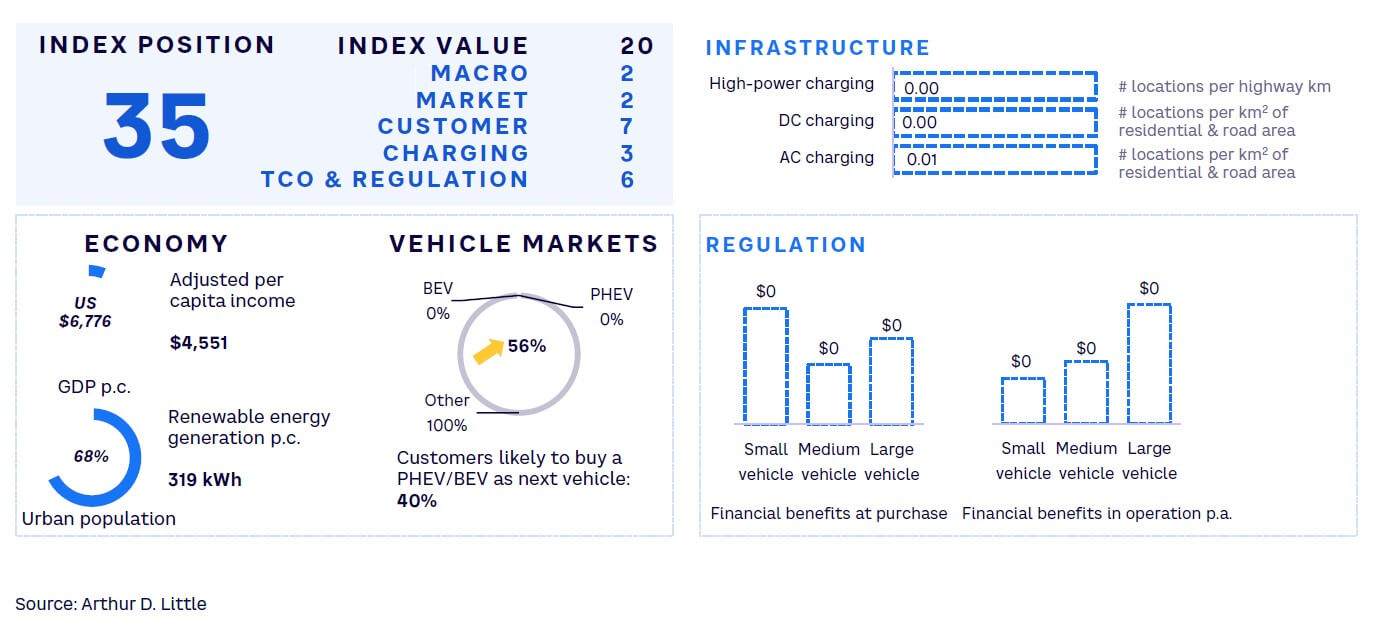
Conclusion
Norway, with an EV sales share of close to 90%, has completed its transition to EVs. This case study demonstrates that battery electric mobility is feasible for an entire country. Neither hydrogen nor ICE vehicles, including hybrids or those burning synthetic or biologically produced liquid fuels, play a role in the new vehicle market any longer. This full transition has only taken little longer than a decade.
The trajectory of EV readiness seems to be determined by the year in which efforts began, average income of population, government incentives, and orchestrated buildup of charging infrastructure. Every country on our list can adopt EVs in the coming years if the respective government wants to do so and orchestrates private and public investments and actions accordingly.
In countries with higher incomes, support for a reliable and dense charging infrastructure is the primary tool to support increasing EV adoption, together with financial incentives to level the playing field between ICEs and EVs during the transition period. Many customers are likely to choose EVs because of their environmental benefits, especially in countries that have access to electricity from renewable sources. In those countries, availability of public fast-charging infrastructure will be the key determinant.
In countries with lower average incomes and e-mobility readiness, subsidies are required to make e-mobility affordable by lowering TCO significantly below that of ICE vehicles in the short term. This will spark interest and make up for current inconveniences in infrastructure. In the midterm, e-mobility followers can leapfrog EV development by quickly investing in the required fast-charging networks. Technological development will continue to push EV costs below those of ICEs and drive customer decisions toward electric mobility.
From analysis of newly added MENA and SEA countries in GEMRIX 2023, we recognize that these countries are also transitioning to EVs for reasons of economic diversification. The technological disruption is widely seen as a chance to reshuffle global market shares in the car industry and to build up new local manufacturing ecosystems.
The governments have also recognized the environmental concerns and thus have promoted sustainable transportation, leveraging local skills and natural resources. The government’s push instills confidence in the public to embrace advanced EV technologies. A positive outlook toward EVs is witnessed by consumers’ favorable likelihood of purchasing an EV. This trend is emerging from enhanced knowledge about technology and sustainability.
Additionally, customers enthusiastically embrace EVs to look trendy and in vogue.
Though many of the emerging and starting EV countries currently have low EV penetration, they are starting the transition by making EVs financially more attractive to customers. Investments in the charging infrastructure also support faster adoption and offer new business opportunities. Both public and private stakeholders are joining hands to build the infrastructure in these countries. Such combined endeavors are playing a pivotal role in advancing the countries’ positions in the EV space.
With similar consistent progress, these countries may follow the example of Norway soon, and increase EV readiness to break through the 100 GEMRIX-points threshold someday.
Notes
[1] Dutta, Soumitra, Bruno Lanvin, Lorena Rivera León, and Sacha Wunsch-Vincent (eds.). “Global Innovation Index 2023: Innovation in the Face of Uncertainty.” World Intellectual Property Organization (WIPO), 2023.
[2] Xinhua News Agency. “Chinese Electric Cars Become New Black in Israeli Market as New Energy Vehicle Industry Thrives.” China Daily, 14 February 2023.
[3] “Electric Car Chargers Regulation Ready: Kuwaiti Official.” Kuwait Times, 9 October 2022.
[4] Saudi Arabia Announces $6 Bln Investments in Steel Complex, EV Metals Plant.” Reuters/Economic Times Auto, 6 May 2022.
[5] Krauss, Clifford. “Iraqi Minister Says High Oil Prices Could Speed the Shift to EVs.” The New York Times, 10 March 2022.
DOWNLOAD THE FULL REPORT
87 min read • Automotive
GLOBAL ELECTRIC MOBILITY READINESS INDEX — GEMRIX 2023
Charting the progressive course of e-mobility across the world

DATE

FOREWORD
Catastrophic climate change urges global shift toward electric vehicles — but the world needs to establish its readiness
The pressing issue of climate change, which world-renowned naturalist David Attenborough called “the biggest threat to security that modern humans have ever faced,” brought world leaders to a single stage culminating in the landmark Paris Agreement. This resulted in the requirement for countries to submit climate action plans known as Nationally Determined Contributions (NDCs), outlining their emissions-reduction targets and the measures they would undertake to achieve them.
Energy is at the heart of today’s climate challenge and key to the solution, with the inherent need to transition from fossil fuels to clean, sustainable energy. The transport sector, in particular, is responsible for approximately a quarter of greenhouse gas (GHG) emissions, with about 95% of the world’s transport energy coming from fossil fuels. Thus, the electrification of transportation offers a promising solution to climate change — but only if combined with a transition to electric energy generation from renewable resources. In any case, electric vehicles (EVs) beat alternative powertrain technologies with internal combustion engines (ICEs) in efficiency by a wide margin, disregarding the burning of fuel.
Of course, ending the age of the combustion engine is still a challenge for large parts of the planet. However, with 90% of the world GDP now covered with net-zero commitments and pressure on companies to counter climate change through new products, processes, and purpose, e-mobility topics have moved up the strategic agenda for automotive executives around the globe. To assist executives in organizations of all kinds around the world, Arthur D. Little (ADL) has set up a methodology to evaluate the “readiness” of markets for electric mobility and help formulate strategies based on the data. The standardized approach and detailed analysis of key market drivers for EVs enable a solid understanding of the current situation.
ADL’s current analysis covers 35 markets across all continents under varied situations regarding demographics, economics, motorization, energy generation, and so forth. In this Report, we provide an overview of the key results of the 2023 edition of the Global Electric Mobility Readiness Index (GEMRIX), which ADL first carried out in 2018 under the name, “BEV Readiness Study.”
Dr. Andreas Schlosser
Partner, Global Lead, Automotive
EXECUTIVE SUMMARY & KEY FINDINGS
GEMRIX 2023 is the third edition of the study and now includes 35 markets across all continents (see Figure 1). Already since the 2022 edition, there has been a massive jump in EV adoption worldwide. Norway has defended its position as the global leader of the EV readiness ranking, but a new challenger is getting closer, making huge steps: China.
The two markets are followed by three distinct groups of countries. All countries are moving to increase EV adoption, following similar patterns but with differences in time by a few years, as some started earlier than others. We discern differences between global markets primarily in specific legislation and, to a lesser extent, socioeconomic factors. In countries with higher income, for example, environment protection plays a crucial role, while in countries with lower average income, cost is the primary determining factor. The perspective to participate in a new, dynamically growing industry also sets incentives for vehicle electrification in many regions.

In the 2023 GEMRIX study, the markets are classified into four clusters:
-
Global Benchmark — markets with a GEMRIX score of 100 or above. In the 2022 edition, only Norway, a lead market for electric mobility, populated this category with more than 110 points. This year, for the first time, a second market has moved closer to the threshold: China scores 98 points. Among the 35 markets, Norway is still the only country with an EV sales share of more than 50%. A stunning 88% of all new cars sold in Norway in 2022 were either battery electric vehicles (BEVs) or plug-in hybrid electric vehicles (PHEVs).
-
Ambitious Followers — where all prerequisites for EV mobility are in place and EVs are on the verge of becoming mainstream. Example markets in this category are Germany, Singapore, and the UK. Among Ambitious Followers, EVs have increased their sales shares to more than 30%. In leading markets, a full range of EV models in different formats and price ranges is available, serving a broad spectrum of client needs. However, even in leading markets, OEMs are still under pressure to expand their EV offerings, especially to the entry market segment.
-
Emerging EV Markets — where conditions for EVs are still inferior to those for ICE vehicles, even though customers are becoming more comfortable with the idea of EVs as infrastructure is ramping up. Example markets are the US, Japan, the UAE, and India. Here, we see mainly scores between 40 and 60, with the UAE and Hong Kong emerging as the front-runners with a score of 57. In these markets, we still see a few operational and financial drawbacks. However, these countries have demonstrated a clear intention to make steady progress toward e-mobility. They are making significant investments to boost the landscape — and will likely catch up soon. For example, an entrepreneurial culture and a start-up ecosystem have played a pivotal role in driving EV innovations in the Americas, Southeast Asia (SEA), and the Middle East. Furthermore, the UAE has experienced an increase in EV charging infrastructure owing to government-led initiatives, a significant catalyst behind the increasing number of consumers willing to buy an EV as their next vehicle.
-
Starter Markets — where EVs have just entered the game and still face major challenges in terms of costs and infrastructure readiness. Example markets are South Africa, Malaysia, and Türkiye. In Starter Markets, electric mobility is just beginning to enter the conversation. Consumers are excited about embracing sustainable technologies, including EVs, as reflected in these countries scoring high in readiness. Given lower fuel costs in these regions, higher total cost of ownership (TCO) of an EV is a deterrent. The limited availability of EV options is yet another major issue. Additionally, given global awareness regarding climate change and a call for sustainability, these regions have ventured into electric mobility and announced initiatives, but execution and implementation at scale remain to be seen. Although the expansion of the EV charging infrastructure is still in its nascent stage, these countries are likely to ascend in the rankings as concerns surrounding charging accessibility are alleviated. Moreover, governments exhibit a strong inclination toward promoting e-mobility in public transportation.
Regarding Customer Readiness, cost is one of the most, if not the most, important drivers of EV adoption. This poses a challenge in developing countries as EV prices are still high and income is comparatively low. Thus, OEMs need to decrease costs, while governments need to create incentives to pave the road to success and allow customers to enjoy electric mobility. Especially in markets with low costs for fossil fuels, there needs to be improvement with TCO for EVs to enable a breakthrough.
In terms of Infrastructure Readiness, battling range anxiety — the fear that a vehicle’s battery will not have sufficient charge to reach the destination — is a key issue. DC chargers are becoming more popular, as they lower charge time, are perfectly suited to highways, and decrease range anxiety. Charging industry players should focus on the Emerging EV Markets — as these countries are about to solve the chicken-and-egg problem (i.e., determining which must be in place first, infrastructure or EVs), if they haven’t already done so, and governments are pushing infrastructure buildup, enabling players to win large-scale contracts. In markets with a quickly rising EV population, the challenge is to keep up with infrastructure installations to avoid creating barriers to adoption.
Government Readiness hinges on government’s willingness to take the first step by introducing wide incentives for purchasing vehicles. Customers should not pay a premium for EVs. Moreover, governments need to reduce TCO by introducing incentives for vehicle usage. Promoting EV adoption in Emerging EV Markets and Starter Markets will give charging infrastructure players the incentive to enter a country, creating a reinforcing spiral of EV adoption.
Betting on EVs is no longer a risky gamble, and the predictability of the EV market is continuing to grow. The only major driver that cannot be predicted fully is government policy. However, making reasonable assumptions about this will give the industry in all countries firm ground on which to base their planning.
1
GEMRIX 2023 METHODOLOGY
GEMRIX evaluates countries’ progress toward e-mobility, providing a comprehensive assessment of their suitability for EV adoption
Index methodology & approach
ADL’s 2023 GEMRIX has been calculated for 35 countries. The index provides a platform to compare countries’ preparedness and progress toward e-mobility. GEMRIX is calibrated between notional scores of 0 and 100. A score of 100 implies that ICE vehicles and EVs are at the same level in terms of acceptability, affordability, and availability. The higher the score, the higher the favorable transition to EVs in the country. Thus, a score beyond 100 shows that EVs are even more beneficial than ICEs.
GEMRIX comprises five major categories reflecting EV adoption: (1) macro factors, (2) EV market and competitive landscape, (3) customer EV readiness, (4) public charging infrastructure, and (5) TCO and government regulation (see Figure 2). Each category is further broken down into six to 16 specific data metrics, analyzed with a standardized metric for each country, rendering 47 variables per country.

The five categories are assigned weights according to their relevance for EV adoption. The countries can score different points in each category, with each metric within the categories varying by weight and market data. The individual point score is calculated from analytics that consider relative and absolute performance measures. The final GEMRIX score is the aggregate of performance indicators from the five subcategories, providing a thorough assessment of a country’s suitability for e-mobility.
Macro factors
A country’s macroeconomic conditions can substantially impact its readiness for e-mobility solutions. GDP per capita, net income, and growth rate are among key macroeconomic statistics. Higher GDP per capita means more disposable income for emerging technology like EVs; the share of the urban population also paves the way for EV adoption (see Figure 3). As cities typically have higher pollution and congestion levels, EVs are appealing to mitigate these risks in urban cities.

Furthermore, renewable energy production can boost e-mobility preparedness by powering EVs with cleaner, more sustainable energy. Renewable energy production is crucial for EVs to be a truly sustainable alternative to ICE vehicles. Smart grids are also vital as governments pursue ambitious plans to boost their electricity supply and integrate renewable energy into their generation portfolios. Importantly, resilient electrical grid infrastructure can accommodate the growing demand for charging EVs. The availability of a secure and steady electrical supply guarantees EV owners a seamless charging experience, thus easing the transition to electric mobility.
EV market & competitive landscape
The level of competition among OEMs impacts a country’s EV adoption — higher competition results in more innovation, lower prices, and better consumer services (see Figure 4). The number of BEV or PHEV models offered in the market by OEMs also indicates the availability of consumer choices, which drives competition and innovation. This, in turn, can make EVs more accessible and affordable to a broader range of people.

Recently, EV markets globally have proved to be very dynamic (see Figure 5). While it was only two years ago in which the EV market outside China was dominated by emerging players (with Tesla leading the way), many incumbent OEMs have since raced to overtake them. German and US OEMs are a good example of this volatility. Up to 2019, they only reluctantly introduced EVs. Customers interested in electric cars of a new kind largely had to turn to Tesla. Starting in 2020, however, pushed by government initiatives and the pressure of coming late to this important future market, German OEMs rapidly introduced new all-electric lines and models. The US saw a very similar uptake, as major US OEMs — including Ford and GM — also electrified their mainstream model lines.

At the same time, Chinese EV manufacturers are now ready to export their EVs all over the world. Moreover, in many countries, new dedicated EV brands and manufacturers have been installed and are about to start operation, for example, in Vietnam, Türkiye, and Saudi Arabia, among others.
Customer EV readiness
Customer preparedness allows for the acceleration of EV adoption and promotion. This is influenced by such factors as the chance of acquiring an EV, Internet penetration, and EV pricing versus ICE automobiles. A higher incidence of homeownership can create a wider pool of potential EV owners who can readily access and install home-charging infrastructure.
Figure 6 summarizes the factors influencing customer readiness, while Figure 7 zones in on customers likely to buy a PHEV/BEV as their next vehicle.


The topic of charging naturally leads to accessibility. We see a correlation between the share of a population living in urban areas and EV readiness. Lack of access to public charging infrastructure is a massive hurdle to the adoption of EVs. Globally, the density of public charging points in rural areas is nowhere near the density of petroleum stations. With most EVs are still of lower range compared to their ICE counterparts, countries with a large rural population have a significant challenge to solve, as is very visible in India and Vietnam. Again, this hurdle is much less pronounced for two-wheelers (2Ws), which can be charged effectively using standard household power lines.
Factors like knowledge and automobile preferences also determine customer readiness. A favorable inclination toward EVs enables greater adoption, as the lucrative demand side will push the supply side, namely, government and OEMs, to enter the EV market. One factor signaling customer preference for EVs is the homeownership rate. Homeowners have the flexibility of charging installation, thereby making e-commutes more feasible. Some countries, such as Oman and Qatar, have fared well in GEMRIX due to upbeat customer readiness, primarily driven by homeownership rates. Range anxiety is another factor that concerns consumers. Thus, a shorter average length of commute bolsters the use of EVs.
Concerns about environmental protection play the second most important role in readiness to buy an EV. We see a clear correlation between EV readiness and environmental awareness, as measured primarily by the number of governmental activities and years since those activities were introduced. While this aspect is very important in Norway and Germany, in a country such as India, it only reaches a very small group of customers. Furthermore, the “coolness” of driving an electric car is a determining factor — again, primarily in Europe and North America.
Additionally, a higher score in the Global Innovation Index (GII)[1] of a country can pave the way for technological advancements in EV technology, including improvements in battery efficiency, range, and charging infrastructure. Customers are more likely to be ready for EV adoption when they see continuous innovation and advancements in these areas.
Public charging infrastructure
The availability and quality of charging infrastructure are critical variables in a country’s EV industry’s growth and success. Before purchasing an EV, consumers must have faith in the availability and dependability of charging infrastructure. A comprehensive charging infrastructure network, including both AC and DC networks, can improve the convenience and appeal of owning an EV by increasing the number of opportunities for drivers to recharge their vehicles. Furthermore, developing a charging infrastructure network can boost customer trust and encourage EV adoption, increasing demand for EVs and moving the EV sector forward.
AC charging infrastructure, prevalent in homes, workplaces, and public parking lots, provides slower charging speeds but is appropriate for overnight or extended charging periods. It makes charging convenient and accessible for daily commuting and routine use. DC fast-charging infrastructure, on the other hand, provides considerably faster charging speeds, allowing EVs to recharge their batteries within 30 minutes or less. DC fast chargers are frequently installed along highways and main travel routes to facilitate long-distance travel and reduce charging time during trips. The presence of both AC and DC charging infrastructure demonstrates the EV sector’s comprehensive development (see Figure 8).

The importance of the charging infrastructure category in GEMRIX is established by allocating one of the highest weightages. Some smaller and densely populated countries score high in this category because of high EV charger density on highways, at destinations and in residential areas. EV charging infrastructure is also among the foundations for strengthening the UAE’s position in achieving the highest score in this category. For example, Dubai is investing in making the charging infrastructure robust through various initiatives aligning with its vision toward sustainability. It makes it a lucrative go-to-market for EV charging infrastructure vendors.
When starting EV markets, the availability of private charging at home or workplaces is the key enabler, but every significant step in a market’s EV adoption requires public charging infrastructure. Only dense-enough and easy-to-use public charging infrastructure enables long-distance travel by EV and opens the market to customers who do not have access to private overnight parking with electric power supply.
Because the lack of public charging is the greatest hurdle in starting EV markets, and the costs of infrastructure setup and charging play a major role, AC charging up to 22 kW was the first choice in early EV markets. While these charging speeds are sufficient for small battery packs and charging use cases that allow for several hours of charging, they fail in en route charging and locations with high and continuous charging demand.
We observed that DC charging becomes the preferred choice in a growing number of public charging use cases, including destination, curbside, and en route highway charging, where maximum outputs can reach up to 300 kW currently. Only DC charging powers of around 100 kW and above enable a quick refill for driving distances greater than 50 km in an hour or less.
Leading GEMRIX markets, such as Norway and Singapore, score high in GEMRIX for their public DC charging infrastructures, while the UK, Germany, and the group of Emerging EV Markets are still more AC-heavy beyond the main highway connections. Changing existing infrastructure to DC or creating a sufficient density of DC charge points will require significant investments in those markets in the coming years. Starter Markets preparing for the first wave of EVs can leapfrog to DC charging in public spaces.
TCO and government regulation
Vehicle price and running costs are the most important factors for customer decisions between ICEs and EVs. ICE vehicles have had a head start of more than a century in optimizing production at scale and building an ecosystem, which has allowed customers to buy and operate vehicles affordably and conveniently. Therefore, legislators have introduced various EV incentives to compensate for economic disadvantages, which are clustered into three broad categories:
-
Sales price — tax reduction or lump sum
-
Ownership — mostly reduction of motor vehicle tax
-
Operations — lower energy prices, reduced tolls, reduced parking prices/exclusive parking
Thus, government regulations can significantly impact the smooth transition to EVs (see Figure 9). Policies like subsidies, tax incentives for EV purchases, and regulations on emissions and fuel-efficiency standards for vehicles can incentivize consumers and manufacturers to adopt EVs. Such schemes help reduce TCO, thereby creating a strong demand pull. Additionally, regulations mandating the installation of charging infrastructure and promoting the use of renewable energy sources for electricity generation can further facilitate the growth of the EV industry.

The classical example for taxation in favor of EVs is Norway. Without the value-added tax (VAT) on EVs, which is 25% in Norway, the end-customer price for a new US $50,000 vehicle effectively falls to US $40,000 for a private customer. As a business, one could deduct the VAT anyway. Thus, EV adoption in Norway has been driven primarily by private customers, which has pushed the market forward and allowed the overall network effects to generate advantages for commercial customers.
Singapore decreased tolls for EVs, making EVs not only more cost-efficient to buy but also to operate. Moreover, in some states of Mexico, EV owners are exempt from the “Tenencia,” an annual vehicle tax based on car value, which amounts to savings of approximately US $850. Additionally, in leading EV countries, the costs of driving 100 km on fuel is nowadays comparatively higher than those of doing so on electricity, also because of taxes.
Such policies aim to create a distinction between ICE vehicles and EVs. Customers’ ability to purchase and maintain EVs is a driving force. It includes financial incentives during purchase and when in operation. Beyond these benefits, the government offers incentives like the announced ban on ICE vehicles (see Figure 10) and free parking for EVs. Many markets, such as the EU, Israel, Türkiye, and Egypt, have already announced bans on the registration of ICE vehicles, which will become active in the next decade.

The comparison between gasoline and electricity prices also leads to determining the favored mode of transportation. Some countries are characterized by significant oil reserves, driving oil prices down. As a reaction, for instance, the Lebanese government has reduced subsidies on fuel prices. It indicates a “disincentivization” of gasoline. Thus, the push from the government becomes more crucial in shaping the affordability, demand, and development of the EV sector.
2
GLOBAL BENCHMARKS
What markets can learn from global benchmarks in EV readiness
A consistent trend is that BEV powertrains are key to decarbonizing transport and contribute to decreasing carbon emissions. This is particularly so for passenger vehicles, as well as light commercial trucks, and likely will be the main technology over the next 20-30 years. However, the full value chain, including suppliers, OEMs, and customers, will have a difficult time through the transition.
Norway, still the front-runner in e-mobility, shows how long it may take to turn even a small market and vehicle fleet toward EVs. Norway’s journey began in 2011, when EVs were rare and exotic, and the first Teslas were not yet in series production. Ambitious Followers and Starter Markets will have it easier today, as key market conditions like EV availability, comparative TCO, and environmental awareness have improved on a global scale over the last 10 years.
Financial incentives for EVs and disincentives for ICEs may still be adequate support measures in a starting market, where only pioneers with home-charging ability use EVs. However, to enable true and mainstream transition, all markets require a functioning ecosystem for EVs, which must work hassle free for users. Thus, the stage must be holistically set up by multiple parties and stakeholders.
Infrastructure
Formerly independent industries, such as vehicle OEMs, energy companies, road infrastructure/service providers, and telecom and software companies, need to work together with local and national authorities to provide widely available, easy-to-use, and reliable charging infrastructure for EVs.
Only an integrated approach can ensure cost-effective and customer-oriented infrastructure development without jeopardizing grid stability and macroeconomic feasibility. While this infrastructure was mainly AC-based in the early periods of electric mobility and in starting markets, nowadays the importance of DC fast charging becomes clear. Long-distance mobility with EVs and widespread EV adoption, especially among drivers without home-charging opportunities, can only work with a dense, fast-charging network along all major routes.
Closed-loop EV supply chain
Successful EV markets require a resilient, sustainable, and effective EV supply chain either domestically or in close reach. China is the prime example for setting up a competitively strong EV industry end-to-end in no more than 10 years. This involves the availability of raw materials, key components, and focal capabilities for EVs. It also necessitates a circular approach — reducing and reusing natural resources — to make e-mobility a truly sustainable alternative and ensure supply of scarce inputs. Other examples of this approach can be found in Central and Northern European markets, which have discovered the attraction of domestic battery production and recycling. In addition, SEA, with automotive hubs in Thailand, Malaysia, Vietnam, and others, is already setting up to follow this EV cluster strategy.
Multi-stakeholder orchestration
Governments and regulators have played a central role in supporting e-mobility and will continue to do so. However, they need to change their approach since many markets have reached new levels of maturity. EV infrastructure and supply chains are key prerequisites for successful e-mobility markets of the future. Both require holistic and integrated action from disconnected parties and market actors. Such a “garage band” needs a conductor to become a symphonic orchestra, and markets need more than tax incentives on one hand and restrictions on the other.
Corporate players, too, can assume the role of integrators. Markets in which either entrepreneurs or authorities successfully assume integrative roles in the areas of infrastructure and supply chains will become Ambitious Followers quickly, or even future leaders.
Market readiness differences attract different players
Leaders & Ambitious Followers
Mature EV markets like Norway and China are experiencing increasing competition among market players in the EV sector — for both vehicles and infrastructure. Ambitious Followers are at a stage that enables the entry of all kinds of EV actors, holding potential for established EV OEMs and scaled-up providers of charging infrastructure and ecosystem services. Customers in these markets appreciate a growing and still improving offering and have a rather high willingness and ability to pay — but also hold high expectations. The competition is increasing, especially with new EV OEMs entering the global field. These markets will see further consolidation, and market-entry barriers for new entrants are already high.
Emerging EV Markets
Players that still want to shape an EV market with new and selective vehicle offerings and charging infrastructure solutions will turn to Emerging EV Markets in the Middle East or SEA, such as the UAE or Thailand. These markets are not yet fully divided up among incumbents and growing rather quickly — a very promising environment in which to scale up and create a home base for later expansion, or to enter for increased market share and dynamically growing revenues. Governments in these regions have clear transition plans and support e-mobility with legislative and fiscal action.
Starter Markets
Slightly late to the party, Starter Markets offer huge potential for new start-up-style entrants and early infrastructure development in a “blue ocean environment,” where market shares are not yet divided up. However, profit pools need to be developed first. These markets require some (financial) patience and willingness to invest. Established players would rather wait for others to prepare the ground and make a late market entry with scale and financial power. Many Starter Markets have taken action by establishing local EV manufacturers and full EV ecosystems with component and local energy provider partnerships to set up a charging infrastructure.
How actors can cope
Vehicle manufacturers
Manufacturers must adapt their offerings and supply chain planning to market-readiness levels (e.g., in quantitative sales planning and product management). However, there is no time to lose, and manufacturers that have yet to embark on the EV journey will face more than hard times to survive the industry transition during the coming years.
In markets with higher GEMRIX scores, such as Ambitious Followers, EV sales planning can follow proven methods, considering target segments, pricing, positioning, and product specifications. In addition, sales planners should note that powertrain disruption usually decreases brand loyalty. A convincing EV model offering helps conquer market share and tap into new market segments. Some successful examples show that positive brand repositioning and expansion into new markets can work with electrification.
Starter Markets and markets with lower readiness, however, need special methods of sales planning and market entry. OEMs frequently prefer selective offerings, first targeting the most promising customer segments with lower risk. New sales models and sales channels may help mitigate risks and lower investment requirements. All sales planning must adjust to the fact that a new offering is only one part of the required market preparation. In particular, EV introduction in less mature markets requires a well-planned launch strategy. It may, nevertheless, be more successful than expected due to the lower level of competition. For a brand, gaining market share with new EVs is even easier in a Starter Market than in more mature environments, while lower absolute sales volumes need to be dealt with.
Infrastructure providers
Norway and Ambitious Followers are experiencing consolidation of the charging infrastructure market already. This includes the formation and shift of roles between energy providers, charge-point operators, and asset owners. Players that have not yet pegged their positions — and established partnerships, customer bases, and solid market shares — will face difficulty in keeping up with development. For incumbents, now is the time for scaling and setting up fast public DC charging in attractive locations. Increasing utilization of charge points will be key to improve economics. Public megawatt (MW) charging for trucks and commercial vehicles will be the next big topic in mature EV markets.
Infrastructure players in Starter Markets should avoid copy-and-paste strategies from early EV markets like Norway, and not rely on the rollout of wide AC networks in the public space. Today’s customers in many developing markets require public charging, as they lack private parking and charging possibilities. Leapfrogging to quicker DC charging solutions at destinations and charging parks in fuel station locations is turning out to be the winning strategy to avoid the need for update investments five years from now.
We expect today’s Starter Markets to develop EV readiness quicker than first-benchmark markets, and thus charging needs to catch up sooner rather than later.
#1 Norway
Still leading in EVs and sustainability due to first-mover advantage
Norway is leading the EV movement across the globe. In 2022, 80% of new vehicle sales were BEVs. This adds to a long history of leadership in many sustainability areas. For example, the country’s utilities sector is built mainly on renewable energy from hydropower, with 45% of its energy mix coming from that source; the first hydropower plant was built in 1892. Moreover, as far back as 2016, 98% of electricity production came from renewables.
One driver for Norway’s EV adoption is its high share of urban population. Of Norway’s inhabitants, 84% live in cities. As a result, typical range anxiety, a major inhibitor of EV adoption, is less relevant, since city driving covers fewer kilometers. However, given that Norway is a vast country, average trip length is high, at close to 15 km per day. The government countered possible range anxiety by launching programs to install charging infrastructure as early as the late 2000s, resulting in about 2,000 charge points by 2011. Today, around 25,000 public charging stations are available in Norway, including around 6,000 fast-charging stations.
As Norway has historically not had a large car industry, a new kind of automotive suppliers are currently flocking to this destination. For example, battery cell manufacturers FREYR AS and Morrow Batteries have set up shop in Norway, and battery recyclers Swedish Northvolt and Canadian Li-Cycle are building plants in the country. The high availability of renewable energy for electricity-intense operations is the key driver of this development.
Norway’s government resolved the previously mentioned economic chicken-and-egg problem through government-funded infrastructure projects and tax breaks for EVs. The first 2,000 charge points were built through a program costing just €7 million. Furthermore, Norway committed to establishing chargers at intervals of at least every 50 km at major roadways, and successfully fulfilled that goal. To further accelerate EV adoption, Norway suspended import taxes on EVs in 1990, decreased annual registration taxes in 2000, and slashed EV VAT to 0% in 2011.
Its focus on cutting taxes paid off as EVs became the major technology in 2019, reaching 50% of sales, and pure BEVs reached 50% of sales in 2020. Conversely, tax burdens on fossil-fueled cars are substantial.
In addition, Norway has set ambitious goals for the future, declaring a target of zero local emissions from passenger vehicles by 2025. Putting this in perspective, the EU aims for the same by 2035. EV adoption has reached levels in Norway that are allowing its government to roll back tax incentives step by step.

#2 China
Leading industrial BEV ecosystem enables global champion position
The EV industry in China is the largest in the world, accounting for more than half of global production (58%, according to International Energy Association [IEA]), and share of exported EVs from China have increased from 25% in 2021 to 35%. Plug-in electric vehicle (BEV/PHEV) sales amounted to nearly 25% of overall automotive sales in China in 2022, and these sales were increasingly driven by local automotive companies. When it comes to vehicle availability, China is the most developed EV market globally, with more than 90 brands offering over 300 models in all price ranges, from micro car to luxury. Local brands have a market share of more than 80%, among which are BYD, Wuling, Chery, and Changan. From China, there are also internationally active EV start-ups, such as Nio, XPeng, Zeekr, and Aiways. With China representing about 50% of the global BEV market, international OEMs must increase their value to customers and find cost-saving opportunities by designing vehicles to meet local requirements.
While global players are strengthening their technology position, they also need local ties to realize additional opportunities. Chinese OEMs such as XPeng, Nio, Geely, and BYD saw new record growth in EV sales in 2022. These regional companies are providing a superior experience to local consumers. Features such as strong human-machine interfaces and connectivity differentiate them from the competition.
With over 2.5 million charging stations added in 2022 alone throughout the country, China’s EV infrastructure continues to expand at an impressive rate. With the successful transition to EVs so far, China’s charging network has grown in step with other technologies, such as battery-swap stations. As a result, it has established itself as the current leader in EV infrastructure.
The Chinese government is supporting the development of the EV industry through regulation. There are encouraging policies and measures for both EV manufacturers and purchasers, as well as incentives for business operators to engage in and improve charging and other peripheral services. Financial benefits for customers can range from US $1,500-$2,000 per vehicle and US $1,000-$1,500 for manufacturers.

#3 Germany
Transitioning automotive industry and public awareness of sustainability and climate change
Germany has always been a strong automotive market, hosting many of the world’s most renowned brands, especially in the high-end sector. Comparing the number of cars on German roads to the population, statistically more than every second person owns a car in the country.
Additionally, environmental protection has long played a significant role in Germany. The first legislation on the “Energiewende” (energy transition) dates from the late 1970s. Today, about half of the country’s electric energy is generated from renewable sources. The political uncertainties around energy import from Russia have prompted Germany to increase local production of renewable energy even further.
The automotive industry in Germany, however, maintained a strong focus on ICEs for a long time. While the hype around EVs from 2010 to 2013 was already high in countries such as the US and China, German manufacturers only started serious production of EV passenger vehicles around 2019–2020. Despite the late start, German OEMs picked up the pace, and today, more than 120 different BEVs are available in the market, representing a healthy mix of local and international brands.
One of the major barriers to adopting EVs in Germany is the aforementioned chicken-and-egg challenge of consumer unwillingness to buy vehicles due to poor charging infrastructure and industry hesitance to invest in infrastructure due to poor vehicle sales. Germany recently made a new attempt to break this vicious cycle, with many new, attractive EVs coming to market that spanned all price ranges. Many of these vehicles come with a free (or at least well-priced) wall charger, making EVs an attractive offer for the considerable portion of the population living in single-family homes with parking.
German consumers have always tended to spend more for their vehicles (US $45,000 on average for new cars in 2022), and cars are still highly appreciated in parts of the population. Rural Germans often see the car as their only means of transportation. Combined with the substantial financial benefits offered by the federal government in 2022, EV adoption increased significantly. This, in turn, made investment in public charging infrastructure attractive for players from the automotive, oil, and energy industries, as well as start-ups.
Notably, German manufacturers’ sudden increase of vehicle models was also driven by the fact that other global OEMs, for example, from the US and China, are now competing heavily with established European brands. The newfound German appreciation for EVs also benefits from EU regulation like the announcement of banning registration of new ICE vehicles by 2035.

#4 Singapore
EV sales boom in Singapore with new governmental measures
Singapore suffered a setback in EV penetration during the pandemic but has bounced back sharply with new measures to promote EV sales. With a strong economy (a high estimated per capita GDP) and almost 100% urbanization, Singapore consumers are not anxious about driving range and are willing to pay a premium price for EVs, considering the manifold advantages. The government has also been clear about its encouragement of EV adoption through its announcement in March 2021 that all new car and taxi registrations would need to be clean energy models from 2030 onward, and that all vehicles on roads would need to run on clean energy by 2040.
EV sales are expected to continue to grow at an average annual rate of around 40% year-on-year — to reach an annual sales volume of just under 7,000 units by 2030 and an EV penetration rate of around 9.6% of total vehicle sales in the same year. In 2022, about 3,600 EVs were sold, representing about 12% of all new cars registered. Tesla has been the highest-selling EV brand, with a market share of about 24%, followed by BYD.
The Singapore government announced in its 2021 budget speech that US $25 million has been set aside over the next five years for EV-related initiatives entailing public-private partnerships. This could include measures to improve charging availability at private premises. Singapore will also accelerate the development of its charging infrastructure to better support the growth of EVs in the next decade, aiming to enable the rapid growth of EV sales at around 40% year-on-year. The plan is to deploy 60,000 charging points at public car parks and private premises by 2030 — which is more ambitious than the previous target of 28,000 chargers.
Financial regulations in Singapore are quite progressive as well. New policies such as the Vehicular Emissions Scheme, together with the EV Early Adoption Incentive initiatives, provide tax rebates to reduce the prices of some electric cars by up to US $15,000. From May 2022, to support mass-market EVs, those with up to 110 kW of power were grouped in the smaller car category in auctions for certificates of entitlement (COEs), lowering costs for consumers. This threshold was previously at 97 kW.
All these measures are motivating consumers and fleet operators to shift from ICEs to EVs as the transition becomes increasingly user-friendly. They have put Singapore at the forefront of EV adoption across the globe, second only to China in Asia.

#5 UK
Fast acceleration of EV adoption — Government’s course is becoming unclear but not having a negative effect yet
Electric mobility is slowly becoming a success story in the UK. In 2022, the sales share of electric light vehicles climbed by 40% to 22.8%, while the overall car market suffered. The dominating technology is full BEVs, as nearly 17% of total vehicles sold used a purely electric drivetrain.
The UK government has set ambitious goals for building up its charging infrastructure. In 2022, the public and semi-public charging infrastructure stood at around 39,000 charge points, of which 6,900 were DC fast chargers with more than 100 kW, and a majority of 21,500 were AC with up to 22 kW. The country aims for at least six rapid charge points at every motorway service area by 2023. By 2030, more than 2,500 high-power charge points are scheduled to be added across strategic road networks. In addition to its large public infrastructure program, the UK subsidizes private home charging with a grant of up to £350.
One obstacle to EV uptake in the UK used to be renewable energy supply. The market has increased its speed in the energy transition, and 2022 saw record highs in renewable energy generation: wind contributed 27%, biomass 5%, solar 4.4%, and hydropower 1.8%.
Governments and cities are endorsing EV uptake through bans and regulations on the one hand, and incentives to empower end consumers on the other. The original plan to ban all new registrations of ICE vehicles by 2030 has, however, been postponed by five years. The effects will have to be monitored. Furthermore, parts of cities are regulated through congestion zones in which vehicle operators must pay if emissions and traffic density standards are not met. For example, in London’s Ultra Low Emission Zone, gasoline cars and vans must meet at least Euro 4 standards to avoid charges, whereas in Oxford’s Zero Emission Zone, every vehicle with local emissions is charged — even PHEVs.
Additionally, EV purchase subsidies are in place for up to £1,500, as well as exemptions from road tax and an expensive-car supplementary tax. Further, the UK government also drives corporate promotion of EVs with a capital allowance and a benefit-in-kind tax. In total, we estimate that a BEV company car has an advantage of more than £8,500 spread over three years over a similar ICE car.
In recent years, the UK has started to embrace the change from ICEs to EVs and is accelerating fast to nudge end customers in the direction of the electric powertrain. The steep increase in EV sales and the rapid buildup of infrastructure indicate its success.

#6 Hong Kong
Charging infrastructure concentrated in residential and commercial buildings
Hong Kong wants to achieve carbon neutrality by 2050 and with the transportation sector being the second largest single producer of carbon emissions, electrification of road transport is an important stepping stone. This region has good overall conditions for an EV transition: an urban, young, tech-savvy population; well-developed electricity infrastructure; and a high smartphone penetration and GII score.
Hong Kong profits from the strong Chinese EV market. The local market for EVs is broad and well developed, as 188 EV passenger cars are available for sale, benefiting from the large offering of Chinese car brands. Unfortunately, only a negligible share of electricity in Hong Kong is generated from renewable sources. Therefore, EVs are not automatically a sustainable alternative, but they help reduce local or tailpipe emissions.
In 2021, the government of the Special Administrative Region implemented a roadmap to support the adoption of EVs, including long-term objectives and policies to reach net-zero vehicle emissions by 2050 (while planning to be carbon neutral overall at the same time). A ban on fossil-fueled cars from 2035 onwards sets a clear agenda, and the government has introduced waivers of first-registration tax (FRT) for EVs, leading to large financial benefits. Enterprises buying EVs can fully deduct the purchase price from their profits in the first year for tax reduction.
The government has also allocated funds for electric buses for public transportation. The EV sales share was 8% in 2022, while the share of fleet is currently around 6%.
Although authorities highlight the importance of charging at home or the workplace, more public charging infrastructure will be required to lower adoption barriers for EVs. A current government plan wants to have a minimum of 5,000 public chargers installed in Hong Kong as early as 2025, in addition to 125,000 chargers in residential and commercial building parking garages. The government has provided funds for installation of EV charging infrastructure at existing residential buildings. For EV users in Hong Kong, an increased transparency about public EV charging locations in the city, along with better accessibility, will make the transition to EV easier.

#7 UAE
Incentives support government’s ambitious EV vision; charging infrastructure fuels EV growth
EVs are increasingly visible on the UAE’s roads. This number is set to expand rapidly in the coming years and will interlink the transport and electricity sectors like never before, as the UAE aims to become carbon neutral by 2050. Under UAE Vision 2021, the government has placed a strong emphasis on promoting the adoption of EVs across the country. Dubai, for example, has launched its Green Mobility Strategy 2030, under which it aims to have approximately 42,000 electric cars on the streets of Dubai by 2030.
In 2015, Dubai launched the EV Green Charger initiative to enhance the availability of charging stations for EVs. The overall number of charging stations in the country has grown considerably to approximately 700 stations and is set to expand further. The Dubai Electricity & Water Authority and Road Transport Authority are working jointly to incentivize the use of EVs, with benefits such as free parking and exemption from tolls. By 2050, they aim to make public transportation emissions-free.
The concerted effort of both the government and private sectors in boosting the EV landscape has been met with a promising response from consumers; a staggering 82% are willing to purchase an EV as their next vehicle.
NWTN, a green mobility tech firm, wants to establish an EV assembly plant in Abu Dhabi with a 25,000 square meter facility. It will have an initial capacity of 5,000-10,000 units annually, with potential expansion to 50,000.
Adnoc Distribution, the UAE’s largest fuel and convenience retailer, and Abu Dhabi National Energy Company are coming together to create new joint venture (JV) E2GO. The venture aims to become the primary provider of EV charging points and infrastructure in Abu Dhabi, with plans to deploy a network of fast chargers at key locations, providing associated solutions like parking and tolling services and related digital platforms to enhance EV charging.
By unlocking new revenue streams and catering to the evolving needs of EV customers, the partnership is well placed to promote the adoption of EVs in Abu Dhabi. With the government’s continued support and collaboration with the private sector, the UAE is well on its way to achieving its goal of becoming a leader in e-mobility and sustainable transportation.

#8 US
Robust government measures continue to create sustainable EV ecosystem — driven also by one of the world’s largest EV OEMs
Until now, EV adoption has been slow in the US, where EVs were roughly 6% of sales in 2022. By the end of the year, only about 1% of the more than 280 million passenger vehicles in the country were electrified. As the US has always been a country of significance for the whole automotive industry, developments will be exciting to monitor over the coming years.
The US has favorable macro factors that are setting a promising framework for EVs: high GDP per capita at more than US $76,000 and 5.6% GDP growth over the last three years indicate adequate disposable income in many cases. One of the highest motorization rates across the globe, with nearly 830 cars per 1,000 inhabitants, establishes the potential of the market. High smartphone penetration of 82% and holding third place in GII rankings also shows the US’s affinity for innovative technologies.
The US automotive industry’s development is now supported by the country’s Inflation Reduction Act policies, including huge clean vehicle tax credits for domestic manufacturers of EVs and EV components such as batteries. The rise of Tesla arguably kicked off the electric mobility movement across the globe and revived the US automotive industry. Tesla’s Model Y and Model 3 are still the most popular EVs within the US. Ford and GM followed up on Tesla’s success by announcing ambitious EV sales plans and introducing electric versions of iconic pickups like the Ford F-150 and the Chevy Silverado. GM aims for 40% of global sales being electric by 2025 and 100% of US passenger EVs by 2035. Ford targets a 50% share of EV sales by 2030. New entrants are also trying to get their share of the market, such as SUV brand Rivian and Lucid Motors.
However, lack of infrastructure is a major inhibitor: charge-point density on highways is very low, at approximately two charge points per 1,000 km. The East and West Coasts boast better infrastructure than the Central and Midwestern states. Additionally, energy infrastructure might pose a problem for home charging, as residential homes are usually served by a single-phase power supply; only commercial sites have the three-phase power required for 22 kW chargers. This creates one of the largest challenges in the US, as range anxiety is the second biggest inhibitor, with more than 25 km traveled per trip per inhabitant.
Encouragingly, the current US government has announced more ambitious plans. It has declared a goal of 50% of sales being EVs by 2030, with the addition of 500,000 new charge points. It backs up these claims by subsidizing EV purchases with tax credits of up to US $7,500 and a fund for infrastructure rollout, including US $7.5 billion for the installation and operation of chargers. Together with the strong tailwind for manufacturers from the IRA, these developments make the US one of the most attractive countries for EV players in the coming years.

#9 Qatar
Policy frameworks and increased charging infrastructure are required to capitalize on growing customer EV readiness
With one of the world’s highest GDP per capita and a heavily oil-reliant economy, Qatar has set ambitious targets to transition from an industrial-based economic model to a sustainable, innovation-driven one. The country’s EV aspirations align with the vision to facilitate the transition.
According to Qatar National Vision 2030, the nation aimed to achieve 25% of its public transit bus fleet to be electric by 2022 and had successfully reached this milestone by year end. The Ministry of Transport, in line with Qatar’s Vision, aims to switch 35% of total vehicles in its fleet and 100% of its public transport buses to electric by 2030. These strong commitments are a testament to the potential of the EV market in Qatar.
A boost to the EV landscape comes from the recently concluded FIFA World Cup 2022 in Qatar, where the use of electric buses and taxis raised awareness of EVs among tourists and locals alike, while also encouraging consumers to choose EVs. In addition, to bring EVs and hybrid EVs (HEVs) to Qatar, the country is forming partnerships with several international automakers. For example, Qatar Free Zones Authority (QFZA) recently signed a multilateral framework agreement with Yutong, one of the world’s leading bus and coach suppliers, and Mowasalat, Qatar’s major transport services provider, to establish and operate an electric bus factory. Regarding charging infrastructure, Qatar General Electricity and Water Corporation (Kahramaa) and fuel retailer Woqod signed an agreement in late 2022 to supply, install, and operate 37 DC fast-charging units for EVs at Woqod stations.
In addition to the support for public transportation, the government is pushing for higher EV adoption among the consumer segment. The Ministry of Transport is actively promoting the deployment of personal EV charging units for private use, while financial institutions are responding to the growing demand for EVs and hybrids by offering green financing options to facilitate purchases. As a result, it is not surprising that nearly three-quarters of consumers are considering purchasing an EV as their next vehicle.
The government’s strong commitment to promoting green mobility is evident in the active participation of various ministries, offices, and stakeholders in developing robust infrastructure for EV charging and offering a broad range of benefits like free charging. These efforts, combined with a focus on enhancing charging infrastructure and providing incentives for EV purchases, are expected to accelerate the growth of the EV market in Qatar and contribute to achieving the country’s sustainable, innovation-driven economic goals.

#10 New Zealand
A promising EV market with loads of renewable energy and lack of public charging infrastructure
New Zealand is known for its tourism and beautiful landscapes and shows increasing awareness of the need for a sustainable economy. Climate issues are particularly important to New Zealanders, especially given that the Asia-Pacific region has suffered severely from natural disasters.
New Zealand is likely to ban sales of ICE vehicles by 2040 but has thus far not taken legislative action in that regard. It could improve its GEMRIX position once a ban has been introduced. However, the government has taken action on other ends, such as implementing trade policies that focus on sustainable growth and ceasing fossil-fueled subsidies. For instance, it has introduced an exemption for road user charges that apply exclusively to EVs. These will be in place at least until March 2024. The government is targeting an EV share of 2% of all light vehicles on the nation’s roads by that time. EV sales shares have reached approximately 7% in 2022, and PHEV sales have been at more than 15%. Currently, sales shares are increasing at a high speed.
As a quite wealthy society, with a GDP of more than US $42,000 per capita and a solid economy and political system, New Zealand has good starting conditions for a transition to EVs. Also, it has a high urbanization rate, and strong interest in EVs has been expressed in surveys among consumers.
A large share of renewable electricity generation (around 85%) will help New Zealand not only reduce tailpipe emissions of its local car fleet but also lower overall carbon emissions from the road transport sector by the introduction of EVs. The government has set out to increase this share to fully 100% by 2030, enabling net-zero emissions via use of EVs.
New Zealand is specifically weak in public charging infrastructure, having a very low GEMRIX score and only one charger per 75 km of state streets. As a market of “home chargers” currently, New Zealand could step up to become Ambitious Followers quickly with an improved public charging infrastructure. Some providers have announced plans to install several hundred ultra-fast chargers over the coming years. Thus, a climb up the GEMRIX ranks is probable for New Zealand in the future. Currently, the growth rate of public EV charging infrastructure is more than 30% year-on-year.

#11 Japan
A huge HEV market prepares for start of full electrification
EV sales as a percentage of total auto sales for Japan were about 2% for 2022, with an estimated annual sales volume of about 77,000 units — a huge jump from around 42,000 units the year before. However, while EV adoption is rising slowly, recent initiatives taken by the government and OEMs are expected to bring a much-needed boost to electrification.
In 2021, the Government of Japan set a target for all new cars sold by 2035 to be environmentally friendly, which will push EV sales. The government has also subsidized part of the cost of purchasing EVs, particularly BEVs, PHEVs, and fuel cell EVs (FCEVs). Local automakers such as Toyota, Suzuki, and Honda expanded their EV offerings in 2022 for the first time, after betting much longer on hybrid and (in small numbers) fuel cell powertrains. For Japanese consumers, 2022 marked the first year of EV model availability from domestic manufacturers.
While PHEVs and BEVs have not seen high adoption in the country, HEVs are still quite popular, reaching a record in sales share of 49% of total auto sales in 2022. Japan also has a strong EV charging infrastructure, with about 30,000 charging stations, and the government plans to increase the number to 150,000 by 2030. With a strong mix of urban population and regulatory push, Japan is slated to become one of the bigger EV markets globally.
Japan’s laggard approach to e-mobility is largely due to its huge investments in gasoline-electric hybrids. For a long time, the Nissan Leaf was the only successful BEV operating in the country. Thus, both the government and Japanese companies have good reason to hold their bets on EVs.
Today, Japan dominates the global market for the current generation of gasoline-electric vehicles. Given customers’ familiarity with this technology, their preference to shift to PHEVs/BEVs is far lower than that of other developed nations. Almost half of all vehicles sold in Japan are HEVs. After incentives provided by the government in 2012, electric charging infrastructure developed rapidly in the country, with more than 30,000 stations already operating.
As demand for HEVs continues to rise, the EV charging infrastructure will further improve. The government provides subsidies at the point of purchase for EVs, but no such incentive is currently provided for operating EVs. The latest changes in the strategy of Japanese OEMs have shown that incumbents like Toyota will surely move quickly to avoid being left behind.

#12 Israel
Propelled by boost in public charging infrastructure and e-mobility innovations
Israel is a highly urbanized, densely populated country with a high dependency on private car commutes. Its commitment to fighting climate change has resulted in an impressive growth story for EVs in the country, which ranks among the top countries in the region in terms of EV readiness. The government’s announcement of making electric cars the only option for purchase from 2030 has further boosted the EV landscape.
Moreover, Israel’s ranking of 16th in GII underscores its affinity for innovative technologies. Although the country’s EV industry is less mature than that of countries like Norway, Sweden, and the Netherlands, Israeli companies have developed some of the best solutions in the industry. Many of the equipment and solutions developed by Israeli companies are highly valued, even in mature markets. For example, StoreDot, an Israeli start-up, has developed a fast-charging battery that can charge an EV in just five minutes, while Electreon Wireless has developed wireless charging technology for EVs, enabling a more convenient charging experience.
A new deal between Toyota and Electreon will yield built-in wireless charging for future Toyota EVs, as well as an easy-to-install kit. With such innovative solutions, Israel is poised to break into the top bracket of countries leading the global EV market.
With one of the highest rates of taxation on ICE vehicles in the world and lower rates for EVs, Israel has incentivized the adoption of EVs. The availability of public charging stations and good electricity infrastructure has also facilitated the EV uptake among customers. As a result, around 45% of consumers will likely buy an EV as their next vehicle. Most current EV purchases in Israel are Chinese imports, with BYD and Geely becoming popular brands and beating legacy players like Hyundai and Kia in sales numbers.
According to Israeli experts and importers, advanced technologies, higher availability, and better configuration are the three main reasons for the success of Chinese EVs in the Israeli market.[2]
However, rapid growth of EVs has put the Israeli government in a conundrum. The government is discussing doubling the purchase tax on EVs from 10% to 20%. The intent is to emphasize public transportation versus massive private EV car usage, as one government official reported saying that the government’s “aim is not to fill the roads, but to encourage travel on public transport.” While this move may cause some confusion in the market regarding emphasis on public and private mobility, the overall EV industry is being bolstered by the government.

#13 Jordan
Well-developed electric infrastructure; young, urban population; and booming tourism industry bodes well for EV market
In the heart of the Middle East, Jordan is transforming into a sustainable and environmentally friendly nation. The country has shown significant interest in promoting EVs, particularly through government support. In recent studies, more than half of the population shows interest in buying EVs as their next vehicle. Jordan has a significant share of the young and urban population (92%), who are more likely to embrace sustainable technologies like EVs. Additionally, Jordan has a well-developed electric infrastructure, which is a key enabler for robust EV charging infrastructure and opportunities for home charging.
Jordan’s booming tourism industry will have a positive effect on expanding the commercial automotive sector. Intending to build a low-carbon transportation infrastructure, Jordan can capture this boom in commercial transport to enrich electric mobility. The country relies heavily on imported vehicles, focusing on used cars rather than new ones. Affordability is a key consideration for Jordanian car buyers. Thus, cost advantage would be a significant selling point for moving from fuel-based to electric cars. Therefore, the government must invest in charging infrastructure and public transportation to support the transition toward a low-carbon economy.
Jordan’s economic modernization vision aims to promote EV adoption as part of its strategy to reduce dependence on imported fossil fuels and promote sustainable energy solutions. The government has already implemented several initiatives to support EV adoption, including developing a network of electric charging stations. One such initiative is via a partnership with German electric charging station company eCharge to install 10,000 public charging points nationwide.
To meet rising demand, Jordan is also making strides in electrifying public transportation by purchasing up to 15 new battery electric buses (BEBs) in a pilot rollout for the first electric bus transportation network in the city. This project is part of a larger fleet expansion project that involves purchasing 151 buses — 136 diesel Euro V buses and 15 BEBs. Overall, Jordan has favorable conditions for EV adoption. With continued fiscal incentives from the government, such as exempted registration fees and lower customs duties compared to ICE vehicles, the country is well positioned to accelerate its transition toward sustainable transportation.

#14 Kuwait
Ambitious infrastructure goals and plans for the Middle East’s first EV manufacturing center indicate potential progress in transition
Kuwait’s e-mobility readiness is gaining momentum, with various initiatives being implemented to encourage the adoption of EVs. With 100% urbanization, there is a high concentration of people and automobiles in densely populated areas, which could make EVs a viable option for reducing air pollution and traffic congestion. In addition, the Internet penetration rate in Kuwait is 100%, which could facilitate simple access to online charging infrastructure, vehicle tracking, and maintenance services. Other potential indicators include Kuwait’s high per capita GDP and the government’s commitment to sustainable development.
However, Kuwait is a highly oil-driven market, with more than 50% of its economy generating output from the industry sector. Such easy and inexpensive availability of fuel poses a hindrance to the evolution of electric mobility.
Customers’ sentiment toward electric transportation is lukewarm, given no substantial value addition over ICE vehicles. On the positive side, the Kuwaiti population owns a high number of cars per 1,000 people. SUVs are Kuwait’s most popular vehicle type, accounting for a little less than half of the market. Kuwait is also an exceptional market for high-end luxury and vintage cars. This reflects that the average Kuwaiti is willing to spend a higher amount on cars. Kuwait also possesses an expansive auto parts supply chain by leading the supply services to Iraq and Afghanistan. These factors can add to positive acceptability of EVs as the transition takes place.
In October 2022, Kuwait-based logistics company Agility announced an investment of US $20 million in Loop Global, a US manufacturer of EV infrastructure. This exhibits the inclination of private players to move ahead in the EV space.
The Kuwaiti government’s infrastructure and environmental objectives are ambitious. Kuwait Ports Authority (KPA) announced intentions to develop EV City, the Middle East’s first EV manufacturing center, in August 2021. In fiscal year 2023/2024, design and construction contracts were to be put out to bid. The decision to create a facility for EV makers aligns with the vision of New Kuwait 2035. This vision strives to recast Kuwait as a trading hub. Strengthening trading relations would pave the way to come to par with other leading economies in transportation development.
Minister of Public Works and Minister of Electricity, Water, and Renewable Energy Ali Al-Mousa said in a statement to Kuwait News Agency (KUNA) that a proposed electric charging rule intends to give electric car chargers to clients.[3] The rule stresses that it establishes a mechanism to enhance the placements of charging points in different areas of Kuwait while taking technical limitations and Kuwait’s environment into account. “Preparing this regulation will encourage many foreign electric car-producing companies to enter the Kuwaiti market, which is one of MEW’s goals,” the minister added.

#15 Australia
Government incentives and increasing investments into charging infrastructure support double-digit annual growth of EV market
Like other large territorial states with populations clogging some urban agglomerations, EV shares of vehicle fleets differ greatly in Australia. This share is very low in rural and scarcely populated areas, but higher in large cities with better developed infrastructure and higher awareness of sustainability and climate change issues.
Australia is generally well developed and has a strong economy, with a high GDP of more than US $60,000 per capita. In 2022, its EV sales share was reported at 7% for PHEVs and 1.5% for BEVs. Australia announced that it would ban ICE registrations from 2035 onwards — putting it on tap with the ambition level of the EU.
However, infrastructure is a problem, especially in areas with low population and traffic density. There is a lack of fast-charging stations, especially at interstate connections. Several federal financial incentives are in place; for example, a higher threshold for net-zero-emissions vehicles in luxury car tax (LCT) has been introduced, and all customs duties have been removed for BEVs, PHEVs, and FCEVs. Additionally, zero and low tailpipe emissions vehicles are exempt from fringe benefits tax (FBT). Some territories have introduced additional benefits, such as free registrations for BEVs, direct purchase subsidies, and stamp duty waivers.
Australia’s share of renewable energy in electricity is still low, at below 40%, but growing. The grid is stable and well developed in urban areas.
Consumer interest in EVs has only just begun, as Australia is not a big car market and due to its right-hand traffic style is rarely among the first markets served by new entrants. Still, approximately 150 different EV and PHEV models are now available on the market, and steadily increasing in number. EVs may become more popular as new models are introduced beyond SUVs and sedans (e.g., pick-up trucks and vans).

#16 India
Strong government push drives EV adoption
India is uniquely positioned in the EV space, with high customer adoption in a few segments. The current penetration rate of a little more than 1% is not encouraging, but given the country’s ambitions and capacity commitments, it might turn out to be the dark horse in the EV race.
More and more Indian-based manufacturers and local subsidiaries of international OEMs recognize the huge opportunity of the large local vehicle market. Tata Motors currently has a market share of more than 70% in the nascent market but will have to face increasing competition.
However, EV adoption has been higher for 2Ws and 3Ws in India in comparison to passenger cars, which have not had much traction. A lack of proper road connectivity, long charging times, and infrastructure constraints have funneled penetration in favor of 2Ws and 3Ws in the country, which remain the backbone of transport in the large urban centers.
The Indian government’s Faster Adoption and Manufacturing of Hybrid and Electric Vehicles II (FAME-II) policy is one of the most important regulatory factors driving the EV push. Although current EV infrastructure is barely present, both local and global players have placed big bets on setting up adequate EV infrastructure in the coming two to three years. A rising middle-class population, the government’s push to reduce carbon emissions, and increasing fuel prices are some other factors driving EV adoption.
The Indian government is providing several financial incentives to OEMs in EV manufacturing, which have been passed down to customers at the point of purchase. However, lack of adequate charging infrastructure has restrained customers from shifting toward EVs, which is still usually a preferred second car choice for aspirational consumers in the country.
A lot of nonfinancial incentives have been provided for EVs, which has further spurred adoption. Given India’s demographics, the shift will, however, be led by the metropolises of Delhi, Mumbai, Bengaluru, and Chennai before it trickles to other parts of the country. The lower cost and customer preference to travel smaller distances on bikes have led to faster adoption of 2Ws. Players like Ola and Ather have already sold out their first batches of EV bikes, and large OEMs like Hero, Honda, and TVS have shifted their focus to 2Ws as well.
India’s prominence in the global space is reflected in its mission to play an important role in the EV space. It remains to be seen if plans put in place materialize soon for the country to achieve its targets.

#17 Thailand
Strong stakeholder engagement enhances EV adoption
Often referred to as the “Automotive Hub of Asia,” Thailand has witnessed the flourishing of its automobile industry over the years. The industry contributes significantly to its GDP.
At present, EV penetration is still low, with a fleet share of below 1% and a sales share of 3% of all new cars as of 2022. It is encouraging to note, however, that almost half the population would prefer an EV in the years to come. To sustain this enthusiasm, Thailand will need active government intervention and stakeholder engagement. Recent progress is noteworthy. There has been a concerted push to fast-track EV adoption in the country. State-run companies, academic institutions, government agencies, and automotive associations are taking the lead in electrifying the vehicular fleet, particularly in the area of public transportation.
The Thailand government is supporting EV sales through various demand-side and supply-side incentives, including tax incentives for local EV production and import duties exemption on machinery. They are also offering a five-year corporate income tax exemption for investments in charging stations with at least 40 chargers. The government has set a target of 1.123 million net-zero-emissions vehicles by 2030, with a focus on electrification in the car and pick-up segment.
Also, the government has planned consistent efforts for building the country’s charging infrastructure. The Ministry of Industry, for example, targets the setting up of charging stations within a maximum 50- to 70-km radius in the years to come. To bolster this, three state enterprises — Electricity Generating Authority of Thailand (EGAT), Metropolitan Electricity Authority (MEA), and Provincial Electricity Authority (PEA) — have joined to support investments in EV charging infrastructure.
The Thailand National EV Policy Committee has introduced a roadmap as a framework for EV development from 2021 to 2035, with the aim of developing a well-established supply chain for manufacturing EVs and building the technological capacity for modern mobility.
With EGAT, the Ministry of Higher Education, Science, Research, and Innovation and several academic institutions have collaborated to form the Thailand Energy Storage Technology Alliance (TESTA), which has the objective of revolutionizing local storage technology, a key pillar of electric mobility.
Thailand, therefore, is set for accelerated growth in EVs in the next five to 10 years, with increased investments from local and Thai investors, coupled with government incentives. The government has committed to carbon neutrality by 2050, which will lead to a thrust in EV adoption from 2025 onwards. The government’s National Electric Vehicle Policy Committee has set the target of EV sales penetration at 30% by 2030.

#18 Bahrain
Inauguration of first EV charging station and collaboration with micro-mobility firms paves way for growth
Bahrain has begun its first steps toward embracing EVs with the inauguration of the first EV charging station in 2021, following in the footsteps of other Gulf Corporation Council (GCC) countries aiming to electrify transportation. In addition, Bahrain’s Economic Vision 2030 emphasizes the importance of increasing sustainability. In the future, this vision can pave the road for progressive adoption of e-mobility solutions.
In November 2021, Bahrain launched its Logistics Services Sector Strategy 2022–26 to lift the logistics sector’s contribution to GDP to 10%. This would benefit the country’s commercial transportation in general. Given these broad infrastructural developments, electrification of logistical transit can be considered a future step.
Bahrain hosted a Decarbonization Roundtable Series to enhance understanding of carbon markets and their affect in achieving net-zero emissions, which could have implications for the development of the EV industry in Bahrain.
Furthermore, initial progress comes from collaboration between Bahrain’s Ministry of Transportation and Telecommunications (MTT) and TIER, the leading micro-mobility firm in Europe, to install emissions-free electric scooters and bikes across the city of Manama. Additionally, in 2022, the National Bank of Bahrain (NBB) joined hands with Bahrain National Insurance to offer discounted motor and EV insurance premiums.
This service is provided as part of NBB’s automobile lending program. Customers also will receive up to five years’ complete insurance coverage for agency repairs, as well as additional benefits like battery replacement and electric car recharging. In 2023, Bahraini company Marson Group announced plans to launch Bahrain’s first electric car factory. The organization has partnered with US manufacturing company Gass Auto for implementation. The factory intends to manufacture various EVs, including 2Ws and passenger cars.
Businesses that operate in the oil and gas business or generate money from the extraction or refinement of fossil fuels in Bahrain are exempt from all taxes, including income, sales, capital gains, and estate taxes. Because of the government’s significant hand in the fuel industry, private companies are not adequately incentivized to operate in non-oil businesses. Bahrain still has a long way to go in encouraging OEMs and auxiliary companies to enter the EV car market.

#19 Oman
Net-zero announcements and public charging infrastructure growth are likely to increase EV readiness, but country still has long way to go
As part of Oman Vision 2040, the government has set out plans for a sustainable future with a diversified economy; the adoption of EVs plays a crucial role in this goal. With more than 2 million vehicles on Oman’s roads, representing almost half of the country’s population, reducing carbon emissions from the transport sector is a top priority. The government has committed to achieving net-zero emissions by 2050 as part of its COP27 commitment, with plans to phase out fuel-operated vehicles and ensure that about 80% of vehicles in Oman are electric by 2035.
To support EV adoption, the government is prioritizing the development of infrastructure that enhances convenience for early adopters. For large industrial and commercial users, Oman has implemented time-of-use (TOU) charges, which are more appealing than default rates, if charging is done during off-peak hours. It also intends to dramatically upgrade its metering system. As a result, there is a chance that PEV-specific or more general off-peak rates will emerge in the medium term. In the meantime, with a high homeownership rate and subsidized electricity tariff regimes in place for residential customers, home charging is likely to be quite attractive compared with the running costs of an ICE vehicle.
Oman’s Bahwan Services and Trading (BST) and Saudi Arabia’s Ajlan & Brothers (Abilitii) have signed a collaboration agreement, aligning with Saudi Vision 2030 and Oman Vision 2040. The agreement encompasses projects in industrial manufacturing of lithium-ion batteries, renewable energy, healthcare, and food security.
Charging infrastructure development is critical to the success of the EV industry in Oman. Although facilities are still somewhat limited, new fuel stations on major highways are now required to include EV charging facilities. At the same time, free-of-charge facilities available at an increasing number of hotels and malls are further expected to accelerate Oman’s transition toward sustainable mobility.

#20 Algeria
Strong participation from various stakeholders, including government and private players, acts as tailwind to accelerate EV market
Algeria, the largest nation in the African continent, is making remarkable progress in the EV market. The government has taken significant steps to create a supportive environment for its growth. It has provided a 20% import benefit on EVs over ICE vehicles, offering a solution to the cost issue for an import-based EV market.
To further promote growth in the sector, Algeria has set an ambitious target of installing 1,000 charging stations in 58 wilayas by 2024. Public energy company Sonelgaz, in partnership with Naftal, a subsidiary of Sonatrach, will install these charging stations. Additionally, the Centre for the Development of Renewable Energies (CDRE) initiative to design and manufacture Algeria’s first EV has further supported the enterprise. The unit production cost of this small EV with seating capacity of two is just under US $5,300, making it very feasible for EV growth in the nation.
Algerian President Abdelmadjid Tebboune’s statement to support EV imports in the country strengthens its commitment to promoting the sector’s growth. It will also help the North African nation to reduce pollution since the transport sector generates 20 million tons of CO2 annually. In 2015, the sun-rich country updated its Renewable Energy and Energy Efficiency Development Plan to 2030 to increase its production of renewable energy, which will benefit the charging infrastructure for EVs.
These government initiatives are spurring interest in the market among other stakeholders. In March 2023, Fiat’s owner, Stellantis, has included Algeria as a key contributor to its Dare Forward 2030 strategic plan. Stellantis’s ongoing project, the Tafraoui-Oran manufacturing facility, will facilitate the production of Algeria’s first hybrid vehicle, the Fiat 500 Hybrid.
However, Algeria’s next challenge lies in addressing range anxiety in the desert nation caused by high temperatures and an above-average commute length. The government must accelerate the installation of more charging stations to solve this problem. Nevertheless, with the government’s support, car manufacturers’ initiatives, and high customer readiness (approximately 80%), Algeria is poised to define the EV market in the MENA region.

#21 Indonesia
Strategic advantage and incentives sparking EV push
The automotive industry is one of Indonesia’s most significant contributors of GHG emissions; at 27%, it is ranked as the second-largest emitter.
Around 10,000 electric cars were sold in Indonesia in 2022. As part of its EV roadmap, the country seeks to become a major EV market by 2030. Interestingly, the country holds one of the largest nickel reserves in the world, a key component of the lithium-ion battery cells driving the EV revolution. This gives the country a major strategic advantage in EV expansion, and Indonesia is planning to domestically produce 600,000 EVs per year.
To this end, the Indonesian government has introduced various incentives, such as the Positive Investment List (PIL), which promises a host of incentives for companies making investments in the EV space. Since 2013, the Indonesian government has been introducing incentives to support xEVs (BEVs, PHEVs, and HEVs) through its Low Carbon Emission Vehicle (LCEV) program and Presidential Regulation No. 55/2019, which aims to develop an end-to-end EV supply chain.
The government, as per Ministry of Industry Regulation No. 6/2022, has also set a national target of 600K battery electric four-wheelers (e4Ws) and 2.45 million e2Ws by 2030. EV incentives include ease of license procurement, coupled with lucrative tax incentives such as a 0% tariff on luxury vehicles that adhere to net-zero-emissions technology standards. The government has reduced the VAT on EVs to 1% from 11%, bringing the starting price of, for example, a Hyundai IONIQ 5 to under US $45,000 from over US $51,000. However, this price positioning is still not good enough for many prospective EV buyers in the country, with a per capita GDP of US $7,500. Mobilization is very low in international comparison; in many cases, the first step before adopting electric passenger cars would be e2Ws or e3Ws. Part of the issue comes from the high vehicle-import duty: completely built units (CBUs) face a 50% import duty, while completely knocked down (CKD) vehicles are still charged at 10% of the value.
Additionally, the country is witnessing aggressive urbanization and an increasing share of youth among its population. Hence, the environment is conducive to rapid expansion of EVs; still, there needs to be a consistent infusion of capital, time, and efforts. According to Coordinating Minister for Maritime Affairs and Investment Luhut Binsar Pandjaitan, Indonesia requires US $35 billion to build and scale its EV ecosystem.
Challenges around supporting infrastructure in Indonesia prevail; as of the end of 2022, only 439 charging units were built across 328 locations. Conversely, a promising 960 battery-swap stations for e2Ws had been set up.
Traditional fuel prices are low compared to other markets; thus, the economics of EVs still do not convince many to buy them. At the same time, given the strategic advantage around the country’s nickel reserves, government incentives, and interest from private investors, Indonesia is poised for strong growth in the EV sector. Toyota Indonesia, for instance, has announced a US $1.8 billion investment in EV assembly, while LG has committed US $9.8 billion toward EV battery cell manufacturing, allowing it to benefit greatly from PIL incentives.

#22 Morocco
Potential to become EV manufacturing hub, with plans for gigafactory and investments in EV supply chain
The current EV fleet in Morocco accounts for only 0.2% of all passenger cars. Affordability concerns are one of the critical causes underpinning such a marginal market landscape. Fuel prices in the country have reached unprecedented highs due to the surge in global energy prices and supply chain disruptions caused by Russia’s invasion of Ukraine. These price increases have discouraged people from purchasing a vehicle due to rising operational costs. Besides affordability, the country’s charging infrastructure is weak.
Despite the current scenario, the EV sector in Morocco holds significant potential for growth and offers various benefits across different dimensions. Morocco is set to become a crucial hub for EV manufacturing, as several OEMs have announced investment plans. The government has revealed plans to construct a gigafactory, but further progress is yet to be communicated. This development is expected to provide a reliable local source of EV batteries, benefiting the country’s auto industry. The battery manufacturer likely will supply Renault and Stellantis, further solidifying Morocco’s key EV manufacturing hub position. Stellantis already has signed a deal to produce Opel’s Rocks-e EV in Kenitra.
Morocco is working toward developing a comprehensive EV supply chain, including battery-recycling and mining companies. The country has significant cobalt deposits, a key component of EV batteries, which could support its EV manufacturing capabilities. BMW has signed a €100 million supply contract with local miner Managem to source cobalt for its EV battery cells. These investments should further enhance Morocco’s appeal as an EV production hub.
Moreover, Morocco’s auto industry is anticipated to grow due to its popularity among auto parts and components manufacturers relocating from Ukraine due to the ongoing war. Japanese company Sumitomo Electric Industries announced its plan to relocate its wiring harness production from Ukraine to Morocco and Romania. This relocation should boost the automotive industry in Morocco and Romania, create new job opportunities, and increase exports.
Morocco’s Intersectorial Association for Electric Mobility (APIME) is leading the initiative to open 2,500 EV charging stations by 2026. The charging stations mainly will be located in major cities like Tangier, Rabat, and Casablanca. The move should incentivize more consumers to switch to EVs.

#23 Saudi Arabia
Via Saudi Vision 2030 and huge investments in infrastructure, EV industry set to grow exponentially
Saudi Arabia is one of the biggest automotive markets in the GCC region, with more than 50% of all new vehicle sales in the region. Continuing with its policy of revamping the overall economy under Saudi Vision 2030, the Kingdom of Saudi Arabia (KSA) introduced the Saudi Green Initiative in 2021 to promote green energy, emphasizing EVs. The initiative boasts a target of 30% of total vehicles in the capital being EVs by 2030.
With a vision to be a significant player in the global EV industry, in early November 2022, HRH Crown Prince Mohammed bin Salman announced the creation of CEER, the first Saudi automotive brand. It is a JV between PIF and Taiwanese manufacturer Foxconn to develop, build, and sell several BEVs in KSA by 2025. The company has a target to produce more than 150,000 EVs annually to be available in the Gulf countries. In addition to this, PIF also bought a majority stake (65%) in US-based EV brand Lucid. Under the agreement, Lucid plans to grow its market in the Middle East, establishing its first overseas manufacturing plant in the King Abdullah Economic City (KAEC) region of the nation. KSA has also agreed to purchase 100,000 vehicles from the group in the next decade. With these projections, KSA plans to build a 310,000 production capacity for EV by 2030.
Following in the footsteps of Norway, an oil-built economy, KSA also aims to provide a favorable environment for EV imports/manufacturers to establish their base, enabling public charging infrastructure and providing benefits for customers to reduce TCO. KSA has signed agreements with various companies to develop EV public charging infrastructure in the country, a few key players being Electromin and ABB. Electromin already has installed 100 charging stations in the country and plans to grow exponentially with the government’s support. It also provides free-of-cost charging at various charging stations to incentivize consumers to buy EVs.
KSA’s geographical advantage allows it to be at the center of sourcing (mining/importing) rare minerals required for battery production in the region. In line with this, KSA has announced US $6 billion for steel mining and EV battery production projects, including building an EV metals plant to attract future investment. According to Industry and Mineral Resources Minister Bandar Al-Khorayef, “The investments will continue to position the Kingdom as a mining production and logistics hub for a region stretching from Africa to Asia, while supporting the transformation of our mining sector so it can achieve its potential.”[4]
Saudi Arabia is looking into economically efficient ways to extract and process lithium from seawater desalination and the brine that accompanies oil. Doing so would allow it to source lithium for EV battery production within its own borders, vastly reducing production costs and transnational supply chain vulnerability.
Overall, Saudi Arabia’s concerted efforts to promote EV adoption and build a solid domestic EV industry hold tremendous potential for the country’s economy and the global transition toward a more sustainable future.

#24 Malaysia
An emerging EV market with ambitious targets
Electric mobility in Malaysia is still in its early stages of development, relatively small but growing quickly. Due to only starting the electrification of the market, the government cannot yet set a target year for banning sales of new ICE vehicles.
The government has set a target of having 100,000 EVs on the road by 2030, but as of the end of 2022, there were only around 10,000 EVs registered in the country, according to the Road Transport Department of Malaysia. Including different types of hybrids, the number of EVs already reaches more than 100,000. Only a limited range of less than 40 different EVs (BEVs and PHEVs) were available in the market in 2022.
The lack of charging infrastructure and high prices of EVs are some of the main barriers to adoption in Malaysia. The country’s per capita GDP is only US $11,000. In March 2022, the government reiterated its aim for installing 10,000 public charging stations by 2025 — the current number is approximately 1,000 AC and 200 DC fast chargers, which leaves a large number to reach the target.
The Malaysian government has implemented and lately extended several incentives to encourage the adoption of EVs in the country:
-
Tax exemptions. EVs are exempt from import and excise duties. This makes EVs more affordable for Malaysians.
-
Road tax exemptions. EVs are also exempt from road tax.
-
Charging infrastructure. The government has allocated funds to install more charging stations across the country to support the growth of EVs.
-
Green investment tax allowance. Companies that invest in EV-related activities, such as manufacturing, R&D, and charging infrastructure, are eligible for a tax allowance of up to 100%.
-
Purchase rebates. The government has introduced a rebate of up to RM 20,000 for the purchase of EVs.
These incentives are part of the government’s efforts to reduce carbon emissions and promote sustainable transportation in Malaysia. There are also several initiatives by private companies to promote EVs, such as ride-hailing services using EVs and the introduction of electric buses in some cities. Overall, while there is still a long way to go, there are positive signs of progress toward electric mobility in Malaysia.

#25 Türkiye
A strong automotive industry drives EV market growth, but lack of clear policies and targets may hinder full potential
Over the past decade, Türkiye has taken significant strides toward becoming a major player in the EV market, with a growing number of consumers and businesses embracing the technology. Around 49% of Turkish consumers say they will consider an EV for their next vehicle.
Türkiye’s strategic location and history in the car industry, skilled labor force, strong government support, and growing domestic market make it attractive for automotive companies. Türkiye has become an important production center for cars sold in Europe. For example, Ford, LG Energy Solution, and Koç Holding plan to build one of Europe’s biggest EV battery factories in Türkiye. The factory is set to break ground in late 2023 and expected to start production in 2026. The JV aims to achieve a minimum of 25 GWh of annual production capacity, potentially expanding to 45 GWh.
While the country’s consumers prefer imported cars, 70%-80% of the 1.5 million vehicles produced annually are shipped overseas, mainly to Europe. The country is following Europe’s carbon-free initiatives in the hope of becoming an EV manufacturing hub and, along the way, boosting its industrial competitiveness. The most important development for the Türkiye automotive industry in 2023 will be the introduction of the homemade EV TOGG to the local market. Including new models to be introduced by other carmakers, EV sales in Türkiye are expected to reach 40,000 units in 2023, which means the share of EVs in total vehicle sales will climb to 7%.
Türkiye is also keeping pace with the expected rise in sales by continuously adding to the EV charging infrastructure. However, as of now, Türkiye has no medium- or long-term policy to transform the EV market. No target has been announced for EV uptake or the deployment of EV charging infrastructure, and no limitations have been placed on the use or sale of ICE vehicles. Thus, the extent to which EV charging stations ultimately will be promoted and regulated through official policy remains unclear. However, the outcome will likely be suboptimal without decisive action.

#26 Vietnam
Strong automotive foundation spurs shift toward EVs
Vietnam is one of the dynamically growing economies in SEA, with a GDP CAGR of more than 6%, and clean transportation ranks high on the government’s agenda. The official aim of the government is to shift 10% of all new vehicle sales in Vietnam to electric by 2023.
Along with environmental concerns, a key driver of Vietnam’s EV push is likely to be its massive young, Internet-savvy population. About a third of Vietnam’s consumers report they are likely to purchase an EV. However, much remains to be done to leverage this potential. The motorized vehicle market is largely dominated by 2Ws, and the EV uptake has so far primarily happened in this area: Vietnam is the second largest market worldwide for electric 2Ws. Car ownership, on the other hand, is quite low, at 25 vehicles per 1,000 inhabitants. A growing middle class is about to change this situation, striving for passenger cars and potentially SEA to host an EV manufacturing company. However, the EV sector has since grown sluggishly. Traditionally, Vietnam has not been very strong in manufacturing. For instance, engine components are designed and manufactured overseas and shipped to Vietnam. There is, however, growing interest among private players in the country; VinFast, Kia, Mercedes-Benz, and Toyota are all placing bets on the Vietnam EV market.
Realizing the need to play an active role in EV expansion, the Vietnam government has exempted electric cars from registration fees for three years and reduced the excise tax on BEVs (of nine seats or fewer) to 3%, starting in March 2022.
However, to further enable electrification, the government’s focus could shift to leveraging the interest of private players through policies centered around friendly taxes and ease of production, as in many other markets. Given that there are no concrete policy measures to boost manufacturing of EVs in Vietnam at present, apart from lower excise tax, the road to electrification remains challenging.

#27 Mexico
Urgent need to tackle rising pollution propels EV push
Among the most populous countries in the world, Mexico is riddled with high travel times and air pollution. While the solution to both problems lies in electric mobility, only 5% of consumers would prefer an EV in the years to come. Government incentives and private investments are required for a strong push toward electrification of the Mexican fleet.
Understanding the criticality of its role, the Mexican government has developed a roadmap for electric mobility. Municipal tax exemptions and pollution control inspections are incentivizing locals. Further, gasoline prices are on the rise, which has further bolstered sales of electric and hybrid vehicles. Private automotive players like BMW and Nissan are making inroads in the country as well.
However, a lack of large-scale government support and limited charging infrastructure are key concerns. According to industry reports, only 1,200 public charging points were available in Mexico at the end of 2022, most concentrated in urban areas. However, the charging network in Mexico is currently growing by 40% annually. Together with increasing government incentives for EVs, this will raise the readiness of the market.
EV owners are exempt from payment of tenure and verification for the first eight years. The average car price in Mexico is around US $22,000, limiting the range of EVs affordable for the average car buyer. Only a small range of 24 full EVs are available on the market. EVs on the market include Nissan Leaf; Renault Twizy; BMW i3; Tesla S, X, and M3; Chevrolet Bolt; and Zacua M2.
Notably, Mexico City is part of the Zero Emission Bus Rapid-deployment Accelerator (ZEBRA) initiative, focused on net-zero-emissions public transport in mainstream cities across Latin America. While infrastructure is a challenge, there is a clear understanding of the need for EVs in Mexico.
The future is encouraging, with General Motors announcing plans to infuse more than US $1 billion in its Mexico plant to build only EVs there from 2024 onwards. This investment also envisages capacity for battery packs, electric motors, and other components, and is the first of its kind in Mexico.

#28 Egypt
Ban on ICE vehicles by 2040 highlights positive outlook for e-mobility
Egypt’s EV industry is in the nascent stage, with a limited number of EVs on the streets. It has one of the lowest GDPs per capita in the MENA region, with a large proportion of low-income households. This is a contributing factor responsible for laggard EV adoption. Moreover, the absence of an adequate charging infrastructure exacerbates the difficulties by limiting the use of EVs in the country.
Despite the relatively low presence of EVs, the government has been expressing strong ambitions to push for the promotion of EVs. A key reason for this ambition is the government’s commitment to achieving its sustainable development goals, which are elaborated on in Egypt Vision 2030. The vision calls for a 10% reduction in GHG from the energy sector, including oil and gas, by 2030, relative to 2016 levels. In line with this initiative, the government has announced a ban on ICE vehicles by 2040.
Several steps have been taken since 2019 to boost the expansion of the EV industry. The country’s Ministry of Public Business Sector and Dongfeng Motor signed a memorandum of understanding (MOU) to produce EVs in the country. The assembly facility, which will be in El Nasr’s factories, will have an initial capacity of 25,000 units. Moreover, the Arab Organisation for Industrialisation, a military organization, presented the nation’s first electric bus route, contributing to the increased popularity of EVs in Egypt. In addition, the introduction of more affordable passenger EVs by manufacturers like MG, as well as the government’s plan to roll out public charging infrastructure, aligns well with the push for EVs.
The EV industry in Egypt has been facing challenges due to the country’s current foreign currency crunch. New cars are offered only in US dollars. This poses a problem for many potential customers who may need access to foreign currency or want to avoid incurring additional fees associated with currency exchange. Still, Egypt is all set to manufacture the first Egyptian EV. Prime Minister Mostafa Madbouly even conducted a follow-up to track the plan’s progress. Given the positive outlook and its initiatives, Egypt will likely become an important market for EVs.

#29 Lebanon
Ambitious target to revamp electric infrastructure gives EVs huge potential
Lebanon is still working to establish the EV sector in the shaken economy. The country already has some presence of EVs on the road. The fact that the nation’s limited public charging infrastructure is currently dominated by luxury car manufacturer Porsche shows that much needs to be done to make EV a more widespread species. To power its new electric cars, EV Electra plans to set up around 100 recharging stations across the country.
Support for EV uptake comes from a stabilizing new car market in 2022 (23,600 units), which was further increasing by 15% year-on-year in the first half of 2023. The market has the presence of various car companies, including Toyota, Nissan, and Renault. These market leaders’ consistent growth paints a favorable picture for EVs in the nation, as they transition to electric mobility worldwide. The e-motor show conducted in the country showcased various e-models from different leading car manufacturers, signifying their active interest in the country.
Despite Lebanon’s EV market being nascent, it is attractive because the government has reduced support for fuel prices, making these some of the highest in the region, complemented by some of the lowest electricity unit costs. The government also supported this growth by providing reduced customs duty of 20% on HEVs and complete exemption on fully electric models. These incentives and prospective growth have led to Lebanon’s first locally built automobile, Quds Rise, priced at just US $30,000, by EV Electra.
Though it presents great potential, Lebanon needs to address the challenges of a weak economic scenario and its overdependence on fossil fuels for power generation. It has an ambitious target of 30% of its energy consumption being from renewables by 2030, but a major revamp is still required to keep pace. This also requires the power sector to undergo a major reform, as it is one of the biggest contributors to the country’s GHG emissions. Overall, Lebanon’s EV sector growth will depend significantly on the government to provide incentives on the purchasing and operation of EVs, which will work with fuel and electricity prices toward the same goal.

#30 Brazil
Rising prices of fuel and ICE vehicles are not yet enough to spark EV market
A developing economy that has seen one of the lowest GDP per capita growth rates during the pandemic (-5%) and much change in political direction, Brazil is still trying to find the right path to cleaner transport in line with economic development. It is still far behind other nations in EV adoption, even though fuel prices surged rapidly in 2021. Despite strong price fluctuations, the government has not yet set clear roadmaps or targets for EV adoption.
The country has a good starting position for EVs, with a high share of renewables in electricity generation (92% in 2022). Conversely, the key reason for the government’s inability to shift its focus to EVs is the country’s success in reducing its carbon footprint using biofuels. Brazil is planning to explore more opportunities for sustainable vehicles using biofuels. Apart from this, the nation cannot shift abruptly to BEVs, as current consumers are unable to afford them and government and OEM investment in recharging infrastructure is uncertain. Yet, awareness of emissions problems from ICE vehicles has been growing among consumers. However, limited spending power and sparse charging infrastructure have hamstrung adoption of EVs.
According to the Brazilian Electric Vehicle Association (Associação Brasileira do Veículo Elétrico, ABVE), the market share of electric cars rose to 2.5% in 2022, with 126,500 vehicles on the road and more than 50,000 new EVs sold during the year. The slow uptake is mainly due to comparably high acquisition costs and lack of infrastructure, as the vehicles depend on supply networks and specialized chains for maintenance. A lack of regulation and national consensus on the role of EVs has been notorious in the nation, so there is no dedicated charging infrastructure in place. In addition, few OEMs are willing to tackle the high investments and risks of new infrastructure required for adapting manufacturing plants to BEV-native architecture.
That said, recent government measures in terms of financial benefits have sparked hope for growth of EVs, with 68% of consumers reporting that their next vehicle is likely to be electric. Brazil’s biofuel ecosystem for vehicles will determine the path for electromobility in the long term, and the nation must expedite its policies to compete with similar and developed economies across the world.

#31 Panama
EV market really only starting — at very low levels
In 2022, sales share of EVs were reported at below 1% of total sales — for PHEVs and BEVs combined, which makes EVs still a very rare species on Panama’s roads. In general, there are neither financial incentives nor a consumer appetite. Additionally, there is barely any public charging infrastructure — only around 10 public charging stations are currently listed for Panama City.
The number of EVs available on the market is still very limited: BMW and BYD are among the OEMs offering EVs, but only a total of 17 different BEVs were available to Panama’s customers in 2022. However, similar to many other markets, Panama wants to reduce its dependency on fossil fuels and lower GHG emissions, improving the overall sustainability of its energy infrastructure and moving toward the objective of energy independence by 2050.
The share of renewable electricity generation reached more than 70% in Panama in 2021, with a majority coming from hydropower. Plan Energético calls for increasing the share to 70% of total energy consumption (including other forms of primary energy) by 2050. This would require substantial changes to energy use in the transport sector, namely a strong shift to EVs.
With a focus on the transportation sector’s emissions, which account for a significant portion of GHG emissions, the government has set out a path in Plan Energético to achieve this goal: the president approved a law promoting EVs as part of a larger initiative to cut GHG emissions, encourage the use of renewable energy sources, and advance sustainability. However, so far, no year to ban ICE vehicles has been announced.

#32 Costa Rica
Abundant renewable energy for use in quickly growing population of EVs
Costa Rica is among the world champions in renewable electricity generation, with nearly 100% of energy output in 2020 from renewables (72% hydroelectric and 15% geothermal, with less than 1% solar). This would make electrification of the transport sector very beneficial in terms of sustainability and climate protection. Transport growth has recently increased the demand for oil and fossil fuels in the country. Costa Rica has to import a substantial portion of its petroleum products, and the country relies on imported crude oil and refined petroleum. Thus, diversifying its energy sources and reducing dependence on fossil fuels are long-term goals.
In addition, Costa Rica reached the highest reported EV sales share in the Americas in 2022, with 7.3& of all cars sold being BEVs, outperforming Canada and the US. However, electric mobility and EV readiness have still not reached much more than a starting level. Setting the market share in perspective, only 2,680 EVs were sold in the country in 2022. The overall passenger car market is tiny on a global scale, with only around 30,000 vehicles sold per annum. The number of EVs available in the market is currently limited to 20 BEVs and eight PHEVs. At the end of 2022, around 5,300 EVs (cars and LCVs) had been registered in Costa Rica, leading to a fleet share of only 0.5%, and there are around 270 public charging locations across the country.
Awareness among consumers of EVs is low, as only 24% state that their next vehicle may be an EV. Availability of home charging is only average, although homeownership rates are high at 70%. For a country like Costa Rica, with a per capita GDP of US $13,300 and a motorization rate of only 240 cars per 1,000 inhabitants, affordability of EVs is key. The government is now providing tax benefits for EVs (BEVs only), which will raise its GEMRIX position and overall EV readiness of the market over the coming years.
Under this new plan, fully EVs costing less than US $30,000 are exempt from taxes. Vehicles costing between US $30,001 and US $45,000 pay only half of sales tax and 75% of selective consumption tax. Vehicles valued between US $45,001 and US $60,000 pay sales tax and only half of selective consumption tax. Vehicles valued at US $60,001 and more pay full taxes.
The new bill also provides tax incentives to companies that replace their gasoline vehicles with EVs. Costa Rica’s public institutions can replace their vehicle fleets with “100% electric” vehicles. Also, the country’s bus fleets will be replaced with electric buses.
EVs (not PHEVs) will continue to be exempt from any import duties. An additional incentives package was added in 2018, including elimination of license plate driving restrictions, waiving payment for yearly road permits, and free parking in designated areas.

#33 Iraq
Government reducing support for fuel prices, coupled with increasing oil prices, may kick-start EV uptake
Iraq is at a nascent stage in the EV market, as evidenced by its low ranking in GEMRIX and related indicators. However, with a thriving automotive industry projected to cross a market size of US $1 billion by 2023 (CAGR of 27.6%) despite a COVID-induced slowdown, Iraq has become a lucrative market for global players and leaders to invest in during the early stages. This is exemplified by the entry of premium car brand EXEED into the country’s automotive market and launch of the nation’s first EV, Jaguar I-PACE.
Jaguar’s and Land Rover’s presence in the country is a game changer, as it is set to define the EV market. Right now, Jaguar I-PACE can only be imported. Jaguar is also planning to install charging stations to kick-start the development of a strong EV-enabling infrastructure.
To further facilitate ease of doing business for international players, Iraq is proactively taking steps to create a stable and robust environment for growth. In a recent interview, Iraq Oil Minister Ihsan Abdul Jabbar emphasized the current geopolitical tension in the region and world, highlighting that disruption in the oil market will inevitably force the country’s transition to EVs sooner than later.[5] The statement signifies the change in the government’s outlook, as it seeks to diversify its portfolio and reduce its overreliance on oil.
In a commendable shift toward a cleaner future, Iraq has committed to reducing pollution by 15% as part of a global initiative to address climate change. To further support its commitment, Iraq has withdrawn a significant portion of financial support for fuel prices, making the TCO of ICE vehicles more comparable to that of EVs. Iraq has also mandated a ban on new ICE registrations until old registrations expire, further reducing support for ICE vehicles.
At present, Iraq only has 0.01% of hybrids and EVs in the market. This low number is supported by a survey gauging Iraqis’ views on EVs and the challenges associated with their adoption. The survey shows that only 38% of people are willing to buy an EV as their next vehicle, whereas most are either unaware of them or unwilling to buy them because of a nonexistent charging infrastructure or high TCO for EVs. To tackle this, a multi-stakeholder approach via supportive policies and incentives will be needed to solve the chicken-and-egg problem of whether to build charging infrastructure or increase the number of EVs first.
The future of EVs in Iraq strongly lies in the government’s support for the sector. Given its commitment to a cleaner future, Iraq, in complement with its geopolitical advantage, holds tremendous potential to drive the change in the EV market.

#34 Philippines
Course for EV adoption is set by governmental plans, while EV fleet is still tiny
The total EV fleet, including hybrids, in the Philippines was estimated at 14,000 vehicles in 2022, making it the third-largest EV population in SEA (after Thailand and Indonesia). Pure EVs have only been a fraction of it (probably around 9,000 vehicles). Only 426 pure EVs were sold in the entirety of 2022 in a total car market of 350,000 new vehicles, showing that electric mobility is only just beginning. However, the growth rates are enormous. More and more OEMs are bringing their vehicles to the market to serve growing customer demand. In 2022, 40 different BEV and PHEV model lines were available.
Decarbonizing the transport sector, which is a major contributor to GHG emissions, is part of the country’s climate commitments and objective to reduce dependence on fossil-fueled imports. Road transportation is estimated to account for 80% of the sector’s emissions. The Philippines also wants to increase its renewable energy generation, currently ranking only second in SEA in combined solar and wind power generation, with 1,766 MW of installed capacity, after Vietnam. Philippine power companies consumed coal for nearly 60 % of their electricity generation in 2022 and have increased coal-fired power emissions by more than 40% since 2017. This trend would need to be stopped to make EVs a truly sustainable alternative to those with combustion engines.
Key issues for customers remain the affordability of the vehicles (Philippines GDP per capita was US $3,500 in 2022), the charging opportunities at home and in public, and the absence of strong financial incentives.
The government issued an EV roadmap in 2023 and removed tariffs on CBU EVs for five years from 2023 onwards. Aside from tax incentives, EV owners will benefit from priority registration, discounts on fees and license plates, and an exemption from traffic volume reduction schemes.
For example, the Department of Transportation (DOTr) is implementing the Public Utility Vehicle Modernization Program, which calls for phasing out jeeps converted to public transport that are over 15 years old to be replaced with environmentally friendly alternatives (either Euro 4-compliant vehicles or EVs).
There are close to 180,000 jeepneys operating throughout the country that need to be modernized, and the EV industry is aiming to fill in 10% of this potential demand. Smaller-scale programs at local government and businesses levels (resorts and the like) have been implemented for the adoption of EVs. The government is also starting to purchase EVs as part of its fleet.

#35 South Africa
Nonexistent EV market likely to grow slowly in coming years
South Africa’s EV market is still almost nonexistent, with only 1,500 electric cars on the road and EV sales making up only 0.16% of all new vehicle sales in 2022. Only 500 EVs were sold throughout 2022. However, the market is expected to grow in the next decade due to multiple government initiatives to reduce carbon emissions and combat global warming by catalyzing the EV sector.
Such low EV penetration is largely due to the government’s limited focus, shrinking GDP per capita, and high up-front costs of EVs, coupled with a poor electricity supply. The ongoing challenge to maintain a constant power supply caused by below-potential electricity generation makes consumers wary of purchasing BEVs. However, there is an opportunity for increased sales of hybrid vehicles, as they can be powered by gasoline or diesel when not using the electric motor. Further, import duties and taxes account for 45% of the cost of imported EVs, which is significantly higher than that for conventional fuel vehicles. New imported vehicles are unaffordable for a large share of the population, and there is currently no domestic EV production.
Currently, South Africa has around 300 charging stations, with approximately one charging station for every five EVs in the country, giving it one of the highest station-to-EV ratios in the world. However, lack of local purchase incentives, combined with continued import duties, will limit the uptake of EVs in the country, as well as the potential for local production due to lack of a market to offer EV producers support.
To reduce the risk of electricity deficits, the government has amended Schedule 2 of the Electricity Regulation Act (ERA), lifting the license-exemption cap for generators to 100 MW. This is expected to bring in investments in the power sector and could benefit the demand for EVs as the supply of electricity stabilizes.
In March 2021, the UK government selected 10 projects in South Africa to receive ZAR 64 million in funding to help decarbonize Johannesburg and Nelson Mandela Bay, which could boost development of the EV infrastructure . Companies like Audi, Mercedes, Nissan, and Opel are also launching full EV models in the country. This will attract investment in charging stations, which, in turn, will help attract the next tier of buyers.
Overall, EV adoption will be quite slow in South Africa, as natural gas-powered vehicles could be the fastest, most cost-effective, and easiest route to reducing emissions in South Africa’s transport sector. However, there is growth potential for hydrogen fuel-cell vehicles, as the country is more likely to adopt affordable liquefied natural gas (LNG)–powered vehicles to cut emissions.

Conclusion
Norway, with an EV sales share of close to 90%, has completed its transition to EVs. This case study demonstrates that battery electric mobility is feasible for an entire country. Neither hydrogen nor ICE vehicles, including hybrids or those burning synthetic or biologically produced liquid fuels, play a role in the new vehicle market any longer. This full transition has only taken little longer than a decade.
The trajectory of EV readiness seems to be determined by the year in which efforts began, average income of population, government incentives, and orchestrated buildup of charging infrastructure. Every country on our list can adopt EVs in the coming years if the respective government wants to do so and orchestrates private and public investments and actions accordingly.
In countries with higher incomes, support for a reliable and dense charging infrastructure is the primary tool to support increasing EV adoption, together with financial incentives to level the playing field between ICEs and EVs during the transition period. Many customers are likely to choose EVs because of their environmental benefits, especially in countries that have access to electricity from renewable sources. In those countries, availability of public fast-charging infrastructure will be the key determinant.
In countries with lower average incomes and e-mobility readiness, subsidies are required to make e-mobility affordable by lowering TCO significantly below that of ICE vehicles in the short term. This will spark interest and make up for current inconveniences in infrastructure. In the midterm, e-mobility followers can leapfrog EV development by quickly investing in the required fast-charging networks. Technological development will continue to push EV costs below those of ICEs and drive customer decisions toward electric mobility.
From analysis of newly added MENA and SEA countries in GEMRIX 2023, we recognize that these countries are also transitioning to EVs for reasons of economic diversification. The technological disruption is widely seen as a chance to reshuffle global market shares in the car industry and to build up new local manufacturing ecosystems.
The governments have also recognized the environmental concerns and thus have promoted sustainable transportation, leveraging local skills and natural resources. The government’s push instills confidence in the public to embrace advanced EV technologies. A positive outlook toward EVs is witnessed by consumers’ favorable likelihood of purchasing an EV. This trend is emerging from enhanced knowledge about technology and sustainability.
Additionally, customers enthusiastically embrace EVs to look trendy and in vogue.
Though many of the emerging and starting EV countries currently have low EV penetration, they are starting the transition by making EVs financially more attractive to customers. Investments in the charging infrastructure also support faster adoption and offer new business opportunities. Both public and private stakeholders are joining hands to build the infrastructure in these countries. Such combined endeavors are playing a pivotal role in advancing the countries’ positions in the EV space.
With similar consistent progress, these countries may follow the example of Norway soon, and increase EV readiness to break through the 100 GEMRIX-points threshold someday.
Notes
[1] Dutta, Soumitra, Bruno Lanvin, Lorena Rivera León, and Sacha Wunsch-Vincent (eds.). “Global Innovation Index 2023: Innovation in the Face of Uncertainty.” World Intellectual Property Organization (WIPO), 2023.
[2] Xinhua News Agency. “Chinese Electric Cars Become New Black in Israeli Market as New Energy Vehicle Industry Thrives.” China Daily, 14 February 2023.
[3] “Electric Car Chargers Regulation Ready: Kuwaiti Official.” Kuwait Times, 9 October 2022.
[4] Saudi Arabia Announces $6 Bln Investments in Steel Complex, EV Metals Plant.” Reuters/Economic Times Auto, 6 May 2022.
[5] Krauss, Clifford. “Iraqi Minister Says High Oil Prices Could Speed the Shift to EVs.” The New York Times, 10 March 2022.
DOWNLOAD THE FULL REPORT